![]()
![]()
![]()
Group & Last Name Index to Full History:
A B C D E F G H I J K L M N O P Q R S T U V W X Y Z
Composers are listed chronologically. Tracks are listed alphabetically.
Not on this page? See
history tree below.Alphabetical
Chronological
Featured on this page in order of the composer's birth date.
| This page concerns early modern
classical composers born before 1900. Major biographical sources are Wikipedia
and All
Music. The 20th century witnessed the decline
of the popularity of classical music and opera in the face of other genres
such as folk, jazz and rock, with the exception of popular music in film
scores. A few musicians at the begin of this page will have bridged
from the Romantic period. Albeit the Expressionist movement in painting
began concurrently with the latter Romantic, it's contribution to modern
classical composition was notable and concurrent with early modern. The
Modern period largely commences with atonal works and
Arnold Schoenberg's
twelve-tone chromatic system, replacing the seven notes of the major and
minor keys), soon dubbed serialism. The classical pages are structured
differently from the other YouTube histories. Due that specific dates are
largely impossible with early classical music we keep the convention of
indexing works on those pages by alphabetical order only. That is, they are
not in chronological order. Dates are noted by appendage and refer the year
of publication if not composition. Brackets (: [Part 1]) indicate sections made by YouTube
channels. If the composer you're checking isn't on this page he may be a
bridge figure in
Late Romantic
(Nielsen,
Busoni) or
Modern 2. Such may be true of French composers dubbed as Impressionist
during the late Romantic (Scriabin,
Ravel) or composers born after 1900. Composers on this page who experimented with German Expressionism at
some point in their career were
Béla Bartók,
Igor Stravinsky,
Arnold Schoenberg,
Alban Berg,
Anton Webern
and
Paul Hindemith.
(Late piano sonatas by
Alexander Scriabin have
been called Expressionistic.) As the history of classical music is largely European until its later
arrival to the United States in the 19th century, helpful in the use of this
account may be
chronological maps of Europe and its monarchs mentioned throughout
[1,
2,
3,
4]. The
earliest major European temporal power to which this history refers
throughout is the Roman Catholic Church and the
Papal States. Much of the
history of Europe is likewise that of the Holy Roman Empire (HRE) from the 9th
to the 19th centuries [1,
2,
3;
HMEA].
France
was a major player alongside the
Church in medieval music prior to the Renaissance and
became the major European check to the HRE. Venice didn't acquire a lot of territory
but became a major cultural center during the Renaissance alike
Italy
of which it became a part in 1866. Other
European nations important to these accounts include in alphabetical order
Austria,
England [GB UK: 1,
2],
Germany,
Poland [1,
2],
Prussia [1,
2],
Russia and
Spain. Also
much affecting European music was northern Europe or, Scandinavia
[1,
2,
3],
particularly as an adversarial check to Russia.
Quick dates for monarchs and popes:
1,
2,
3,
4. See also America [1,
2].
Where World War I (7/28/1914-11/11/1918) is cited see: text: 1,
2,
3,
4,
5,
6,
7,
8;
video: 1,
2,
3.
Where World War II (9/1/1939-9/2/1945) is cited see: text: 1,
2,
3,
4,
5,
6;
video: 1,
2.
|
||
|
Born in 1 Oct 1865 in Paris,
Paul Dukas
was a composer of the Romantic period w a strong classical foundation, though
with a modern lean. His catalogue is relatively brief, particularly as he spent the
last couple decades of his life composing next to nothing as he focused on
teaching. His father was a banker, his
mother a pianist who died when Dukas was five. He played
piano as a youth and began composing at age fourteen. Two years later he
entered the Paris Conservatoire, composing an unpublished 'Air de
Clytemnestre' for voice and small orchestra in 1882. His symphonic poem of
an overture, 'Le Roi Lear', arrived in 1883 [audio by the Württembergische Philharmonie Reutlingen w Fabrice Bollon],
the same year as 'Goetz de Berlichingen', another symphonic poem as an
overture [audio by the Württembergische Philharmonie Reutlingen w Fabrice Bollon].
Dukas left the Conservatoire in 1889 toward writing music criticism for
various chronicles, producing some 410 articles over the years. 'Polyeucte' was an overture written in 1891 for the tragic play, 'Polyeucte',
by Pierre Corneille
[1,
2,
3;
audio w score by the Česká filharmonie w Antonio de Almeida
& the BBC Philharmonic w Yan Pascal Tortelier;
score]. His 'Symphony' in C Major' was completed in 1896 toward its premiere on 3 Jan
1897 w conducting by Paul Vidal to whom he dedicated its publication in 1908
[1,
2,
3,
4;
audio w score by the Radio Philharmonisch Orkest w Jean Fournet,
live performance by the Orquesta Sinfónica del Estado de México w Guillermo Villarreal].
Come his scherzo (playful), the symphonic poem,
'The Sorcerer's Apprentice' in F minor in 1897, inspired by Goethe's 1797
poem by the same
name [1,
2,
3,
4,
5,
6;
audio by the Berliner Philharmoniker w James Levine,
live performance by the Moscow City Symphony Russian Philharmonic w Michail Jurowski]. 'The
Sorcerer's Apprentice' was used in the 1940 Disney film,
'Fantasia', w
Stokowski
conducting the Philadelphia Orchestra [audio].
As the 19th rolled into the 20th century Dukas composed 'Piano Sonata' in E
flat minor toward publishing in 1901 w dedication to
Saint-Saëns [1,
2,
3;
audio w Marc-André Hamelin at piano].
He published 'Villanelle' for horn and piano in 1906 [1,
2,
3;
audio w horn by Pierre Azzuro or
Richard Watkins w score;
live performances w horn by Marcin Chrzanowski or
Christoph Ess].
Dukas premiered his
Oriental ballet, 'La Péri', in Paris on 22 April 1912 (not be confused w
Burgmüller's
'La Peri' of 1843)
[1,
2,
3,
4,
5;
live performance by the Texas Festival Orchestra w Perry So]. With choreography by Ivan Clustine,
the prelude to 'La Peri' was 'Fanfare' [1,
2,
3;
live performance by the Boston Civic Symphony w Max Hobart].
'La Peri' was Dukas' final major composition, though he wrote at least two
future works, one for solo piano, another a song. Turning to private
teaching, he eventually succeeded
Charles-Marie Widor
as professor of composition at the Conservatoire de Paris in 1927. Dukas was
working a symphonic poem inspired by Shakespeare's 1610-11 'The Tempest'
when he died
in Paris on 17 May 1935. References: 1,
2.
Compositions:
alphabetical: 1,
2;
chronological;
by genre.
Editions & scores: 1,
2,
3,
4,
5;
France.
Sheet music: 1,
2.
Audio: 1,
2,
3,
4,
5,
6.
Recordings of: discos: 1,
2,
3,
4,
5,
6;
select: 'Paul Dukas (1865-1935)' by the Württembergische Philharmonie Reutlingen w Fabrice Bollon;
'Paul Dukas' w piano by Jean-François Heisser.
Usage in modern media.
Iconography.
Other profiles: Dutch;
English: 1,
2,
3,
4;
Norwegian;
Portuguese;
русском: 1,
2;
Spanish;
Swedish.
Paul Dukas 1911 Dance poem Ulster Orchestra/Yan Pascal Tortelier 1900 4 movements Piano: Alexander Vaulin 1891 Overture Les Siècles/François-Xavier Roth 1896–97 Scherzo symphonic poem Philharmonic Orchestra Bucharest Cristian Orosanu 1895-96 Allegro non troppo vivace Direction: Armin Jordan 1895-96 Andante espressivo e sostenuto Direction: Armin Jordan 1895-96 Allegro spiritoso Direction: Armin Jordan 1899–1902? 14 piano pieces in 3 sections 12 variations - Interlude - Finale Piano: Marco Rapetti 1905? For horn & piano Horn: Dennis Brain Piano: Gerald Moore |
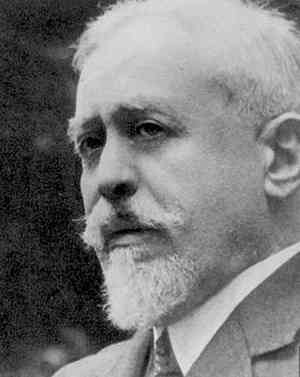 Paul Dukas Source:Classical Connect |
|
|
Born in Honfleur, Normandy, on 17 May 1866,
Érik Satie
is generally described as the so-called father of modern classical music,
Fauré beginning to break away
from the conservative mold a generation earlier. So-called Impressionist
composers like
Debussy
and Ravel are often cited as
bridge figures from Romantic to Modern, Satie a precursor by a touch. Satie
pushed the envelope of getting labeled after Impressionist painting through
identification with modern art movements. Getting labeled a "a clumsy but
subtle technician" in 1911, his response was that he was a phonometrician
(measurer of sounds) before a musician. Satie's
mother, one Jane Leslie Anton, had died in 1872, soon succeeded by his
stepmother, Eugenie, who early mentored him. In 1879 Satie entered the Paris
Conservatoire where he was presumed to be "insignificant and laborious" as
well as "worthless" and sent back home. With so bright prospects before him,
he wrote 'Allegro' in 1884, his earliest known composition not published
until 1972 [1,
2;
audio w piano by Jean-Yves Thibaudet]. A positive
thinker, he composed 'Valse-ballet' and 'Fantaisie-valse' in '85 toward
publishing in '87 by his father, Alfred Satie, whose invention of opus
numbers for Erik would come to none used at all. 'Valse-ballet', for
instance, had been published as Op 62, disregarded since then
[*;
audio w piano by Jean-Pierre Armengaud
or
Jean-Yves Thibaudet;
'Fantasie Valse': *;
audio w piano by Jean-Pierre Armengaud,
Aldo Ciccolini
or
Jean-Yves Thibaudet].
The Belial of music students had been readmitted to the Conservatoire in
1885, though to about the same result as before. Thus he joined the
military, to which he was adverse, so he infected himself with bronchitis
toward a discharge. He then moved from his father's residence to Montmarte where in 1887 he wrote his
first notable music, 'Trois Sarabandes' [1,
2;
audio w piano by Bojan Gorišek,
Reinbert de Leeuw
or
Jean-Yves Thibaudet;
scores].His
first of 'Trois Gymnopédies' arrived in 1888 [1,
2,
3,
4,
5,
6,
7;
audio by various].
Satie's initial 'Gnossienne' was composed in 1889, ending up as No.5 [audio] of six
[audio].
Nos. 1-3 were composed in 1890 as 'Trois Gnossiennes'
[audio]. The first act from 'Les Fils des Etoiles'
composed in 1891 [live performance] contains what is considered 'Gnossienne'
No.7 [audio].
No.4 was also written in '91 [audio]. Satie called such pieces Gnossian due to his interest at the time in
Gnosticism [1,
2,
3,
4,
5,
6].
Concurrently drawn to Rosicrucianism [1,
2,
3,
4], Satie
wrote 'Trois Sonneries de la Rose+Croix' in 1891
[1,
2;
audio w piano by Bojan Gorišek;
scores].
Satie had been a chapel master for the Rosicrucian Order. In 1893 he founded the Metropolitan Art Church of Jesus the
Conductor, which publications helped ensure that he be its only member
[1,
2].
Linked to that period is Satie's 'Messe des Pauvres' or what he called the
'Grande Messe de l'Église Métropolitaine d'Art' with seven movements composed
from '93 to '95 [1,
2;
audio w organ by Marilyn Mason or
Martin Rost;
score].
Come 'Vexations' dated by scholars to circa 1893-94 which theme is repeated 840 times,
a regular chalkboard script for an errant student staying after class.
[1,
2,
3;
live performance by Nicolas Horvath
exceeding nine hours]. Satie began working as a cabaret pianist in 1899, adding a few of his own
compositions to his repertoire of more than a hundred others. He was yet
performing popular cabaret tunes when in 1905 he became a student at the Schola Cantorum de Paris
founded in 1894 by Charles Bordes,
Alexandre
Guilmant and
Vincent d'Indy
to rival the Conservatoire [1,
2,
3]. He there studied some five years, emerging to
great success with his miniature piano pieces. During World War I he spent
part of 1915
on 'Cinq grimaces pour Le songe d'une nuit d'été' intended as incidental
music to a circus production that didn't happen of Shakespeare's 'A Midsummer Night's Dream'
[*;
audio by the Orchestre du Capitole de Toulouse w Michael Plasson;
score arranged for string quartet by Mike Magatagan].
His
ballet, 'Parade', premiered at the Théâtre du Châtelet in Paris on 18 May
1917 performed by Ballets Russes to music conducted by
Ernest Ansermet.
'Parade' was a project commissioned by impresario, Sergei Diaghilev, created in collaboration with author, Jean Cocteau,
choreographer, Léonide Massine and
Cubist painter,
Pablo Picasso,
the last designing costumes and stage [1,
2,
3,
4;
live performance of 'Acrobates' No.5 of 6 sections;
score].
Satie would also begin projects w Cubist painter, Georges Braque, though not
to see light. Due to the closing of many concert halls and theatres during
World War I, Satie thought to fill the gap with events staged by a group of
artists and composers he called les
Nouveaux Jeunes in 1917 consisting of avant-garde composers,
Louis Durey,
Arthur Honegger,
Darius Milhaud,
Germaine Tailleferre,
Georges Auric, and
Francis Poulenc. Satie
abandoned that association later the next
year, but it carried on with assistance from Cocteau as Les Six [1,
2,
3,
4],
named after the
earlier nationalist Romantic movement in Russia called the
The Five. Also in 1917
arrived the first of what Satie called 'Musique d'ameublement' ("furnishing
music"), more commonly called furniture music, meant to "furnish"
environments w discreet ambient backgrounds, precursor in ways to both
lounge and elevator music. Those came in a set of two titled 'Tapisserie
en fer forgé' and 'Carrelage phonique' [audio by the Royal College of Music Furniture Music Ensemble;
arranged for string quartet by Stephen Whittington]. In 1919 Satie
began associating with Dadaist artists and would publish in the Dada
magazine, '.391'. Works from that period include 'Ragtime Dada' of 1922
extracted from 'Parade' (above). He performed 'Trois morceaux en forme de
poire' ('Three pear-shaped pieces') resurrected from 1903 at a Dada event
called 'Soirée du Coeur à Barbe' ('The Bearded Heart') held at the Michel
Theatre on 6 July of 1923, the same at which Surrealist author, Andre
Breton, started a riot marking the death of Dada and the birth of Surrealism [1,
2;
see also Dada: 1,
2,
3,
4,
5,
6,
7;
Surrealism: 1,
2,
3,
4,
5,
6,
7] Among Satie's last three compositions was for the Surrealist ballet, 'Mercure',
premiering on 15 June 1924
w choreography again by Massine and Picasso again in charge of costumes and stage design
[audio of Orchestre De Paris w Pierre Dervaux &
the Orchestre Symphonique et Lyrique de Nancy w Jérôme Kaltenbach;
piano reduction by Bojan Gorišek].
The premiere of Satie's ballet,'Relache' ('Canceled'), was indeed postponed
due to sudden illness of its star dancer, Jean Borlin, changing its date
from 29 November of '24 to 4 Dec [1,
2,
3,
4;
audio by the Orchestre du Capitole de Toulouse w Michel Plasson: Part 1,
Part 2;
piano reduction by Jane Manning].
'Relache' was the brainchild of painter, Francis Picabia.
Satie also composed the score to 'Entr'acte', a surrealistic film by René
Clair to be shown between acts of 'Relache'
[1,
2,
3,
4,
5,
6]. Satie died on 1 July 1925 of cirrhosis of the liver,
having been a heavy drinker. Living a life of "stark simplicity" in
"squalor" and "chaos," perhaps he has thought positively and been readmitted
via reincarnation, to about the same result, thus to develop a cough in boot camp somewhere,
spinning a wheel on ice another 840 times. We all hope that we don't
have to read this 840 times. "You better be good. You better be nice" once
advised Coots & Gillespie. Summarily, along with numerous
arrangements, Satie composed largely for solo piano. He also wrote a strong
number of songs and dramatic works, as well as instrumental pieces for such
as small orchestra. References: 1,
2.
Chronologies: 1,
2.
Compositions:
alphabetical: 1,
2,
3;
chronological: 1,
2,
3;
by genre: 1,
2,
3,
4,
5,
6,
Deutsch.
Manuscripts.
Editions & scores: 1,
2,
3,
4,
5;
France: 1,
2;
Germany: 1,
2.
Sheet music: 1,
2,
3,
4,
5,
6,
7.
Song texts.
Audio: 1,
2,
3,
4,
5,
6,
7,
ranking.
Recordings of: discos: 1,
2,
3,
4;
select: 'Festival Paris Dada'
*,
'The Minimalism of Erik Satie'
*.
Usage in modern media.
Iconography: 1,
2,
3,
4.
Further reading by source: Meurig Bowen;
Chosic;
Akademiska Föreningen;
Kenneth Goldsmith;
Timothy Hazlett;
LTM Recordings;
Nick Shave;
Wolfgang Scherer;
Simon Wells;
WRTI.
Further reading by topic: associates;
John Cage
and;
Gnossienne 1;
Gnossienne 2;
Gymnopedies;
trivia.
Bibliography:
'Erik Satie' by Mary E. Davis (Reaktion Books 2007)
*;
'Satie the Composer' by Robert Orledge Cambridge U Press 1990)
*;
'Erik Satie: Music, Art and Literature' by Caroline Potter (Routledge 2016)
*;
'Erik Satie: A Parisian Composer and His World' by Caroline Potter (Boydell & Brewer 2016)
*;
'Satie the Bohemian: From Cabaret to Concert Hall' by Steven Moore Whiting (Clarendon Press 1999)
*.
Other profiles: Arabic;
English: encyclopedic: 1,
2,
3,
4;
humanities;
musical: 1,
2,
3,
4;
French: 1,
2,
3;
German;
Spanish.
Erik Satie 1888 3 piano pieces Piano: Pascal Rogé 1892 3 airs Piano: Bojan Gorišek 1924 Surrealist film 1889–97 6 piano pieces Piano: Pascal Rogé 1917 Ballet 6 sections Kölner Rundfunk Sinfonieorchester Igor Markevitch 1924 Ballet 21 sections Orchestre Symphonique et Lyrique de Nancy Jérome Kaltenbach 1914 21 piano pieces Piano: Ellen Hohmann |
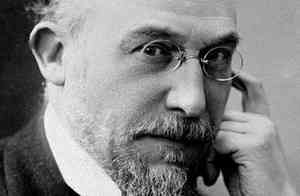 Erik Satie Circa 1890 Source: Nueva Tribuna |
|
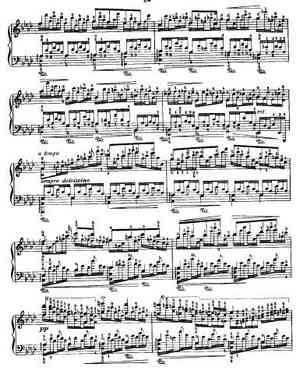 Sample score by Godowsky Source: Wikipedia |
Born on 11 Feb 1870 in Žasliai, Russia (now Lithuania),
Leopold Godowsky
joins other composers such as
Rachmaninoff whose piano
compositions require virtuosic mastery beyond the norm to play, to the left
a sample page from one his scores, a transcription of
Chopin's 'Etude' Op
25 No.1. Unlike Rachmaninoff, he was
largely an autodidact, receiving little formal instruction. He is said to have been composing (a minuet) and playing both piano and violin
at age five. He gave his first public appearance at age
nine, then toured regionally. IMSLP traces his 'Twilight Thoughts' to as
early as age ten,
He studied at the Königliche
Hochschule für Musik in Berlin for a short time before visiting America
for the first time w his mother in 1884, performing in Boston on 7 December.
While in the States he met philanthropist, Leon Saxe, w whom he returned to Europe in
1886
to study under
Liszt. Liszt had already died, however, on 31 July, leading
to a loose pupil-mentor sort of relationship in Paris w
Saint-Saëns, the latter apparently not of much assistance when it came
to performing at piano. Upon Saxe's death in 1890 Godowsky returned to the
States to teach at the New York College of Music in 1890. He would later
teach in Philadelphia (1891-93), then in Illinois at the Chicago
Conservatory (1893-1900). Beyond human at piano himself,
he taught weight release in addition to muscular
movement. On 24 April 1891 he
performed at Carnegie Hall a couple of weeks before its official opening as
Carnegie Hall on 5 May by
Tchaikovsky.
Six days later on the 30th he married one of Saxe's daughters, Frida, also
becoming an American citizen in
1891. Godowsky is best known for his virtuosic
adaptations of other composers.
Younggun Kim has him beginning his 53 arrangements of
Chopin's Etudes in 1894, to which he would add for the next
twenty years toward what is generally known as 'Studies on Chopin's Études'
[1,
2,
3,
4,
5,
6;
audio w piano by Emanuele Delucchi or
Marc-André Hamelin;
discography].
Twenty-two of those were for left hand only, such as Study 22 of Chopin's
1831 'Revolutionary' Op 10 No.12, Godowsky date unidentified
[audio of Ivan Ilić w score;
live performances by Boris Berezovsky,
Francesco Libetta
or
Gregory Wang]. Godowsky was back in Europe by 1900, performing and
teaching in Berlin. From 1909 to 1914 he taught at the Vienna Academy of
Music. He returned to the States in 1912, there to make his first acoustic
flat disc recordings in New York City. DAHR finds him documenting compositions by
Mendelssohn,
Liszt,
Chopin
&
Schubert
[audio] for Columbia
in NYC on 10 April 1913. Also recording for Brunswick, Marston Records has
him releasing 51 acoustic sides until better sounding electrical recordings
for Columbia in 1929 and '30. Godowsky permanently moved to the United States in 1914 upon the start of
World War I, to work in New York, Los Angeles and Seattle. He began
making piano rolls for Ampico (American Piano
Company)
in 1914 w better fidelity, though virtuosity absent. Ampico also issued rolls as
Rythmodik,
that becoming a separate company from 1918 to 1920. Warren Trachtman finds him recording
compositions by
Chopin for both in 1914, 'Waltz' Op 42 in A flat per Ampico
51554 and 'Andante Spianato' Op 22 per Rythmodik F9544
[©]. Trachtman identifies
Godowsky on seven Rythmodik rolls. Peter Phillips has him making 21 rolls
for Ampico, eight for Duo-Art [see also 'A Catalogue of Music for the
Ampico' (Ampico 1922)].
Veikko Viljanen at SoundCloud proffers audio of two 1916 piano rolls, again
of comps by
Chopin: 'Trois Ecossaises' Op 72 Nos.3-5 on Duo-Art 5741 and
'Ballade' in G minor Op 23 on Duo-Art 5793.
Foster White has him recording above 40
rolls for the Artrio-Angelus [1,
2] label
of
Wilcox and White [1,
2]
beginning in early 1919. During the
twenties Godowsky toured internationally including South America and Japan in
1922, China in 1923. Travel in Indonesia resulted in his phonorama, 'Java
Suite' published in 1925 [1,
2,
3,
4,
5,
6,
7;
audio of piano by Esther Budiardjo].
Godowsky disowned his son, Gordon, in 1928
for marrying a vaudeville dancer. in December '31 he published 'Capriccio'
in C♯ minor for both left hand alone and two hands [*;
score
two hands]. Gordon died of suicide in 1932, Godowsky's wife of heart attack
in '33. Godowsky's other son, Leopold Jr., invented
Kodachrome's color
reversal film process in 1935 w musician, Leopold Mannes.
His slightly older daughter, Dagmar, had already been a silent film star
throughout the twenties. He died of stomach cancer on 21 Nov 1938
to be buried at Temple Israel Cemetery in Westchester County, New York.
References: 1,
2,
3,
4.
Compositions: 1;
2;
alpha;
chrono;
by genre;
adaptations: 1,
2.
Editions & scores: 1,
2,
3,
4,
5;
France:
1;
2;
Germany.
Audio: 1,
2,
3,
4,
5,
6,
7,
8,
9.
Video.
Recordings of: discos: 1,
2,
3,
4,
5;
select:
'The Complete Leopold Godowsky': Vol 1:
1,
2
Vol 2:
1,
2
Vol 3:
1,
2
'The Complete Studies on Chopin’s Etudes'
*,
'Godowsky' w Emanuele Delucchi at piano
*;
'Godowsky' w Laurent Wagschal at piano
*;
'Godowsky - Java Suite' w Konstantin Scherbakov at piano
*;
'Godosky - Strauss II' w Marc-André Hamelin at piano
*.
Documentaries: 'The Buddha of the Piano' directed by Antonio Iturrioz 2010.
Further reading by Heinrich Neuhaus: 1,
2.
See also:
the International Master Institute of Music Leopold Godowsky
*;
the Leopold Godowsky Collection
*;
the New International Godowsky Society
*.
Bibliography: 'The Arrangements of Leopold Godowsky' by Millan Sachania (U of Cambridge 1997)
*;
'The Pianists' Pianist' by Jeremy Nicholas (Travis & Emery 2014 [APR 1989]);
*;
'The Published Music of Leopold Godowsky' by Leonard S. Saxe ('Notes' 1957);
*.
Other profiles: Catalan;
Dutch;
English: 1,
2,
3,
4;
French;
German;
Hungarian;
Russian: 1,
2. Leopold Godowsky Composer: Chopin 1835-1836 Op 23 Piano: Leopold Godowsky Piano roll recorded 1916 1924–25 12 sections in 4 parts Piano: Esther Budiardjo 1928 Passacaglia Piano: Howard Na 1928 Symphonic metamorphosis Transcription from 'The Gypsy Baron' Original composer: Strauss II Piano: Takeo Tchinai 1905-12 Paraphrase Part 1: 1905 Transcription of 'Künstlerleben' Original composer: Strauss II Piano: Earl Wild 1905-12 Paraphrase Part 2: 1907 Transcription of 'Die Fledermaus' Original composer: Strauss II Piano: Dan Sato 1905-12 Paraphrase Part 3: 1912 Transcription of 'Wein, Weib und Gesang' Original composer: Strauss II Piano: Marc-André Hamelin |
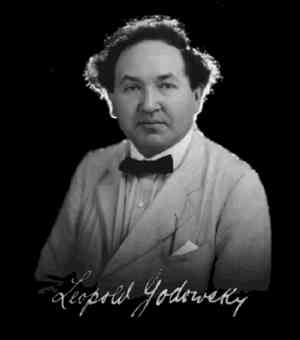 Leopold Godowsky Source: Bach Cantatas |
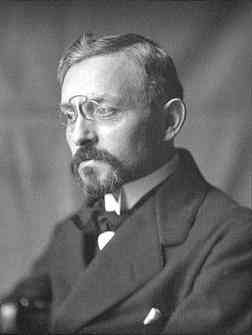 Florent Schmitt Source: Into Classics |
Born on 28 Sep 1870 in Meurthe-et-Moselle, France,
Florent Schmitt
is a highly regarded composer who
studied music in Nancy before entering the Paris Conservatoire at age
nineteen. Juvenile works had included waltzes and a solonnelle. He won the Prix de Rome in 1900.
His Opus 1, 'O Salutaris for Voice and Piano', followed in 1891. The Prix de Rome was the most
distinguished scholarship one could win in France, rewarding three to five
years of accommodations to study in Italy or elsewhere. Sometime about 1900
or later he joined Les Apaches [1,2] a group of composers who rallied about pianist, Ricardo Viñes,
including
Claude Debussy and
Maurice Ravel. A good
example of one of his works for chorus and orchestra is 'Psaume XLVII' (47)
Op 38 composed in 1904 [IMSLP;
audio w soprano by Susan Bullock
w text,
Denise Duval or
Andréa Guiot.
'Psaume XLVII' opens w his 'Gloire au Seigneur!' ('Glory to God!') [soprano by Christine Buffle].
He composed 'Reflets d'Allemagne' ('Reflections of Germany') Op 28 in 1905
toward publishing in 1912 [1,2;
score]. Though
Schmitt never wrote an opera, he composed what the author at French Wikipedia
calls a mimodrama [1,
2] in
dumbshow,
that another of his most popular works titled 'La Tragédie de Salomé' Op 50 composed in
1907 based on a poem by Robert d'Humières, revised in 1910 for large orchestra to premiere at the Concerts Colonne
on 8 Jan 1911 w conducting by Gabriel Pierné
[1,
2,
3,
4;
audio: the New Philharmonia Orchestra w Antonio de Almeida;
BBC National Orchestra of Wales w Thierry Fischer;
Orchestre Philharmonique de Radio France w Marek Janowski;
discography;
score]. Schmitt's
was by that time a big name long before becoming a
music critic for 'Le Temps' from 1929 to 1939
[1,
2].
Also writing works for solo piano, one such was 'Small Gestures' Op 92 in 1940
[1,
2,] in
three pieces called 'Rocking',
'Waltzing'
and
'Pacing'. Albeit Schmitt's life as a music critic
sparked controversy he remained a highly popular composer until World
War II, sympathizing with Nazi Germany and the occupation of Vichy, France.
That lessened not the quality of his music, however, as witnessed by his
chamber work, 'Trio a Cordes' in E minor Op 105 dedicated to Jean, Pierre
and Etienne Pasquier who premiered it on 6 Feb 1946 as the Trio Pasquier,
also recording it on an unknown date toward issue on Pathe CPTX 615
[1,
2;
audio].
Another of Schmitt's best-known works is 'Symphony No.2' Op 137 as of 1957
[1,
2,
audio of French National Radio-Television Orchestra w Jean Martinon].
Schmitt's final Opus was 'Messe en quatre parties' for mixed chorus and organ Op 138 in 1958
[1,
2;
audio of the BBC Singers w Simon Joly
conducting and Andrew Parnell at organ;
score]. He
passed away in Neuilly-sur-Seine on 17 August 1958, leaving his ballet of
1953, 'Le Jardin Secret', without Opus. Schmitt had written well above a hundred works, largely for
chamber and orchestra, as well as ballets and pieces for piano and voice.
References: 1,
2.
Compositions: 1,
2;
alphabetical: 1,
2,
3,
4;
by genre 1,
2;
by Opus.
Editions & scores: 1,
2,
3,
France.
Manuscripts: 1,
2.
Audio: 1,
2,
3,
4,
5.
Recordings of: discos: 1,
2,
3,
4;
select:
'Orchestral Music' by the BBC National Orchestra of Wales w Thierry Fischer
*;
'La Tragédie de Salomé' by the Rheinland-Pfalz State Philharmonic Orchestra w Patrick Davin
*,
review.
Icongraphy.
Further reading by source: Leslie De'Ath,
Phillip Nones.
Further reading by topic: interviews;
premieres of orchestral works. Other profiles:
Catalan,
English,
French,
German,
Italian,
Japanese,
Spanish.
Florent Schmitt 1913 Op 62 For wind band Philharmonic Winds 1943/1944 Op 96 4 pieces Tarihere Quartet 1904 Op 38 Psalm Orchestre Symphonique de Sao Paulo Yan Pascal Tortelier 1948 Op 102 Raintree Saxophone Quartet 1934 Op 84 4 pieces Quinteto Tournier 1958 Op 137 Orchestre National de la RTF Charles Munch 1907 Op 50 Ballet Sao Paulo Symphony Orchestra Yan Pascal Tortelier |
|
|
Born on 14 Oct 1871 in
Alexander von Zemlinsky
was a Jewish romantic composer who transitioned to the modern period during
his later career. He played piano and organ as a child before entering the
Vienna Conservatory in 1884 where he studied under Anton Door, Robert Fuchs,
Johann Nepomuk Fuchs and
Anton Bruckner.
His 'Sonata No.1' is traced to as early as 1887. Zemlinsky's Opus 1, 'Ländliche
Tänze', was written in 1891 while yet a student at the Conservatoire
[1,
2,
3;
audio w piano by Christophe Sirodeau;
live performance by Aglaya Zinchenko;
scores: 1,
2].
Graduating from the Conservatoire in 1892, Zemlinsky found a major champion in Johannes Brahms
whom he met in 1893. In 1895 he founded his Polyhymnia Orchestra, meeting another
important associate that year in
Arnold Schoenberg
who joined that outfit. Zemlinsky's Op 2 was 'Lieder' consisting of 13 songs w texts by various in two
notebooks written 1895-96 [1,
2;
live performance of 'Heft 2' by Elena Mariani
& Gianni Franceschi;
scores].
'Clarinet Trio' Op 3 arrived 1896, published the next year w assistance from
Brahms
[1,
2,
3;
audio w clarinet by Wolfgang Meyer w score;
live performance w clarinet by Jenny Jonquil].
Zemlinsky premiered 'String Quartet No.1' in A major Op 4 in Vienna on 2 Dec
1896 [1,
2,
3;
audio;
live performances: 1,
2].
His initial of eight operas, 'Sarema', arrived to the Munich Hofoper on 10
Oct 1897 w libretto by Adolf von Zemlinszky and
Schoenberg
after Rudolf von Gottschall's 'Rose of Caucasus' [IMSLP;
audio of the Overture by the Danmarks Radiosymfoniorkester w Thomas Dausgaard].
Zemlinsky fell in love with one of his students in 1900, composer, Alma
Mahler (nee Schindler). Zemlinsky, however, was only 5' 2" and his
physical bearing not so impressive as his music. Alma was persuaded by her
circle to end the relationship, thus to marry
Gustav Mahler in 1902.
In 1906 Zemlinksy became kapellmeister at the new Vienna Volksoper. He
married one Ida Guttmann in 1907 until her death in '29, after which he
married Luise Sachsel in 1930 until his own passing twelve years later. From
1911 to 1927 Zemlinsky conducted at the Deutsches Landestheater to eventually become
the current Prague State Opera in 1988. He then worked with
conductor,
Otto Klemperer, in Berlin at the Kroll Opera. In 1930 he
converted from Judaism to Protestantism. Zemlinksy fled Germany for Vienna
in 1933 upon Adolf Hitler becoming Chancellor that year. He began writing
his eighth opera, 'Der König Kandaules', in 1936 but left it unfinished,
that eventually accomplished in 1990 by musicologist,
Antony Beaumont.
Zemlinsky's final assigned
Opus arrived in 1937 per 'Zwölf Lieder' Op 27 w texts by various
[All Music;
audio of 'Afrikanischer Tanz' Op 27 No.3 by
Dagmar Hesse w Antony Beaumont]. He left
Austria for New York City in 1938, arriving at Ellis Island on 23 December.
Though his former pupil,
Schoenberg,
had emigrated to the United States in 1933 to much fanfare, Zemlinky crossed
the Pond (Atlantic) nigh unknown in the States. Meanwhile, Jewish composers who remained in Germany
or other locations in Europe
did so at peril of persecution if not execution [1,
2,
3,
4].
Zemlinsky was
working on another opera, 'Circe',
when in 1939 he began to experience a number of strokes that put an end to
composing. He died of pneumonia on 15 March 1942 in New York City. In
addition to operas, he had composed largely
for chamber, orchestra, piano and voice.
References: 1,
2.
Chronologies: 1,
2,
3.
Compositions:
alphabetical: 1,
2;
Chronological: OREL,
en Español;
by genre: chamber,
operas: 1,
2,
for piano,
symphonic;
by genre internationally: Deutsch;
Dutch;
English; 1,
2,
3,
4,
5;
Francais;
Japanese;
русском;
by Opus: 1,
2;
Editions & scores: 1,
2,
3,
4;
France: 1,
2;
Germany.
Collections.
Sheet music.
Song texts.
Audio: 1,
2,
3,
4,
5,
6.
Discos: 1,
2.
Further reading: relationship w Schonberg.
See also: Zemlinsky lecture by Antony Beaumont 2013;
Zemlinsky Fund and/or Prize: 1,
2,
3.
Other profiles:
Deutsch: 1,
2;
Dutch;
English: 1,
2,
3,
4,
5,
6;
Espanol;
Francais;
Italiano;
Japanese;
Portuguese;
русском.
Alexander Zemlinsky 1916 Op 16 Opera 1 act London Philharmonic Orchestra Vladimir Jurowski Soprano (Bianca): Heike Wessels 1923 Op 18 7 songs Baritone: Juha Uusitalo Soprano: Solveig Kringelborn Philharmonia Orchestra/Esa-Pekka Salonen Die Seejungfrau (The Little Mermaid) 1902–03 Symphonic poem FantasyDeutsches Symphony Orchestra Ingo Metzmacher 1892–93 North German Radio Symphony Orchestra Antony Beaumont 1897 Slovak Philharmonic Orchestra Edgar Seipenbusch 1919–21 Op 17 Opera 1 act Frankfurter Kantorei Gürzenich-Orchester Kölner Philharmoniker James Conlon |
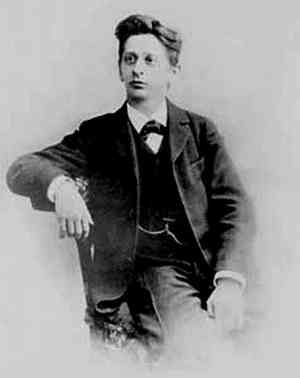 Alexander von Zemlinsky Source: Arnold Schoenberg |
|
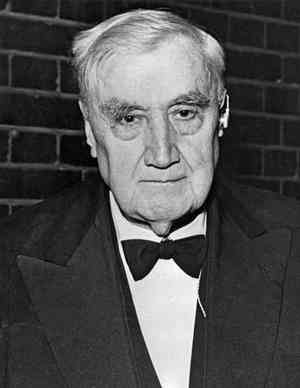 Ralph Vaughan Williams Source: Britannica |
Born on 12 Oct 1872 in Gloucestershire,
Ralph Vaughan Williams
was very much the English composer as compared to modern. Music on the Island
had ever been something independent from what composers did on the
Continent, the short distance between them that was the Channel nevertheless
affecting a distinguishably different take on things for the British than,
say, the Paris Conservatoire and its Prix de Rome which could also include
study in Germany. The late Romantic to early Modern was a decidedly
different affair on the Island than on the Continent as well, the latter
host to such as the so-called Impressionists, Les
Six, Expressionism, Surrealism, etc.. Ralph (pronounced "rafe") largely dispensed with
"modern" music and continued along the veins of the Romantic toward what he
called "pure" music, that is, simply music in and of itself without
identifiers. William's father was a vicar at All Saints Church whose son
would later arrive to the view that
Gustav Mahler
was "a very tolerable imitation of a composer." Ralph began to play piano and compose at age five, taking
lessons from his aunt when he wrote 'Robin's Nest' in 1878 for piano. He
soon took up violin as well. A couple of the larger names with whom he associated at the Royal
College of Music in London were
Gustav Holst
and
Leopold Stokowski.
He also studied with
Max Bruch
in Berlin and
Maurice Ravel in Paris. It was 1898 when he composed 'Serenade' in A
minor for small orchestra [audio by the Royal Scottish National Orchestra conducted by Martin Yates]. Williams'
first published composition was 'Linden Lea', a song for voice and piano written
in 1901, printed in '02 [1,
2;
audio w Ian Bostridge (tenor) & Julius Drake (piano);
text: 1,
2].
In 1905 Williams began conducting the Leith Hill Music Festival, as he would each year until 1953.
Among his first major works arrived in 1909, incidental music for a staging
of Aristophanes' 'The Wasps' [*;
audio of Overture by the Royal Philharmonic Orchestra w Christopher Seaman;
audio complete by the Hallé Chorus and Orchestra directed by Mark Elder;
on CD: 1,
2].
His 'Symphony No.1' ('Sea Symphony') premiered in Leeds on 12 Oct 1910
[1,
2,
3,
4;
audio by the London Philharmonic w Bernard Haitink w score;
live performances by the CSU Symphony Orchestra
* &
the SWR Symphonieorchester
*;
CD by the Bournemouth Symphony Orchestra w Paul Daniel].
Upon World War I Williams enlisted in the medical corps at forty-one
years of age. He bore stretchers in France until making second lieutenant in
the artillery in 1917. He became Director of Music of the First Army in
1918. Williams premiered his ballet, 'Old King Cole', at Trinity College
Cambridge on 5 June 1923 [1,
2,
3;
audio of the Philharmonic Promenade Orchestra w Sir Adrian Boult]. In autumn of 1925 Williams conducted acoustic recordings of 'The
Wasps' and 'Old King Cole' for Vocalion issued on A0249 and
A0247-48 respectively [*]. 'Symphony No.4'
in F minor arrived to its London premiere on 10 April 1935 w Sir Adrian Boult
conducting the BBC Symphony Orchestra, that Williams' first symphony to
represent "pure music" existing in and of itself apart from external
inspiration and given no descriptive title [1,
2,
3,
4,
5;
audio by the London Symphony Orchestra w Andre Previn
(1969) or the
BBC Symphony Orchestra directed by Williams (1937);
live performance by the BBC Scottish Symphony Orchestra w Andrew Manze; CD by the Hallé Orchestra w Sir Mark Elder].
Williams is the earliest-born composer in these histories to apply
composition to film scores in a large way, such his modernity. '49th
Parallel' premiered in London during World War II on 8 Oct 1941 w direction
by Michael Powell in the interest of assisting the British War effort
[1,
2,
3,
4;
incipit scenes].
Going by the RVW Society,
'Coastal Command' was premiered at Piccadilly Circus on 16 October 1942
[1,
2;
film].
'The Flemish Farm' followed at the Leicester Square Theatre 12 August 1943
[*;
film].
'The Story of a Flemish Farm' was an orchestral suite pulled from the film
score which Williams conducted at a Promenade concert in July 1945
[*;
audio of the BBC Philharmonic Orchestra w Rumon Gamba].
The film directed by Charles Frend, 'Scott of the Antarctic', saw premiere on 29
November 1948 [1,
2,
3;
CD]. Williams used the score of that toward 'Symphony No.7'
('Antarctica') which was first performed in Manchester 14 January 1953 by
Sir John Barbirolli conducting the Hallé Orchestra
[1,
2,
3;
audio by the London P O w Bernard Haitink].
'Symphony No.8' in D minor saw conducting of the Hallé Orchestra in Manchester by Sir
John Barbirolli on 2 May 1956 [1,
2,
3,
4,
5,
audio by the Halle Orchestra w Sir Mark Elder or
the Boston Symphony w Charles Munch;
live performance by the London P O w Sir Adrian Boult].
'Symphony No.9', Williams' last, premiered in London on 2 April 1958
[1,
2,
3;
audio of the London P O w Sir Adrian Boult or
the Royal Liverpool Philharmonic Orchestra w Vernon Handley].
He died four months later on 26 August
1958. Other than symphonies, ballets and scores he had written other
orchestral works, operas, chamber works, concerti and songs. Though an atheist-agnostic, Williams
had also written sacred pieces such as hymns and choral music.
References: 1,
2.
Chronology.
Compositions:
alphabetical: 1,
2,
3,
4;
chronological:
in Dutch;
by genre: Deutsch;
Dutch;
English: 1,
2,
3,
4,
5;
Espanol;
Italian;
Portuguese;
operas;
symphonies: 1,
2.
Correspondence: 1,
2.
Iconography.
Editions & scores: 1,
2,
3;
France: 1,
2;
Germany.
Sheet music:
vocal.
Song texts.
Audio: 1,
2,
3,
4,
5,
6.
Audio & live performances: chamber,
choral,
concerti,
orchestral,
stage,
symphonies,
various.
Recordings of: discos: 1,
2,
3,
4;
select: 'Albion's Journey' (compilation by various): 1,
2;
'Symphonies 1-9'
by the London Philharmonic C & O w Adrian Boult.
IMDb.
Further reading by source: Terry Blain;
David Wright.
Further reading by topic: RVW Trust;
'Symphony No.6';
trivia.
Bibliography:
'The Cambridge Companion to Vaughan Williams' ed. by Frogley & Thomson (Cambridge U Press 2013).
Other profiles: Dutch;
English: didactic;
encyclopedic: 1,
2,
3;
musical: 1,
2,
3,
4;
Finnish;
German;
Italian;
Spanish.
Vaughan Williams 1936 Sacred cantata 5 movements Eastman-Rochester Chorus Eastman School SO/Yunn-Shan Ma Soprano: Michaela Anthony 1914 Revised 1920 Romance Violin: Janine Jansen 1926–31 Royal Liverpool Philharmonic Orchestra James Judd Piano: Ashley Wass 1925 Sacred oratorio The Bach Choir Winchester Cathedral Choristers Winchester College Quiristers Bournemouth Symphony Orchestra David Hill 'A London Symphony' 4 movements 1911–13 Revised 1918 1920 1933 London Philharmonic Sir Roger Norrington 1935 4 movements BBC Scottish Symphony Orchestra Andrew Manze 1947 4 movements BBC Scottish Symphony Orchestra Andrew Manze |
|
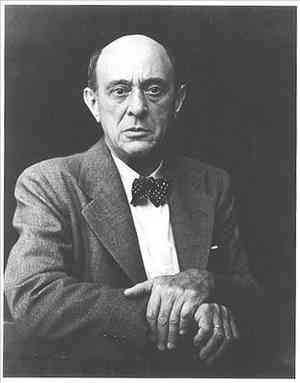 Arnold Schoenberg Source: All Music |
Born on 13 Sep 1874 in
Vienna, Austria,
Arnold Schoenberg
was a Jewish expressionist composer born to a shopkeeper for a father. He
was also an expressionist painter [1,
2,
3].
Expressionism in art and music most widely remarks on contrast
[1,
2,
3,
4,
5]. Like
Debussy
with whom the tide of the modern began to rise, Schoenberg
would earn the title of a degenerate
by the German Reich. (Though Debussy was French, his wife was a Jew.) Unlike
Debussy, the atonality [1,
2,
3,
4] of
Schoenberg's expressionistic period from 1908 to about 1921 was deemed
inconsistent with the Nazi Regime. He made that worse with the development
of a twelve-tone (dodecaphonic) system during his third period. Though
Josef Matthias Hauer came up with a twelve-tone system in 1919, Schoenberg's
would be considerably more influential, particularly via the New or Second
Vienna School with
Anton Webern and
Alban Berg
[1,
2,
3,
4,
5,
6,
7]. George Perle
would later develop his own dodecaphonic system prior to the twelve-tone
compositional method beginning to be referred to as "serialism" in 1947 by
Polish
composer,
René Leibowitz
[1,
2,
serial composers,
serial compositions].
As for Schoenberg, his major influence as a youth had been
Johannes Brahms
[*].
With the exception of lessons in counterpoint from
Alexander Zemlinsky in 1895, he was
self-taught. To go by Walter Frisch at UC Press, Schoenberg had already set
music in 1893 to Alfred Gold's 'In hellen Träumen' [text] and Nikolaus Lenau's 'Schilflied'
[*].
The (yet tonal) instrumental work, 'Three Piano Pieces', followed in 1894 [1,
2;
audio w piano by Pi-Hsien Chen]. In 1898
Schoenberg converted to Lutheran Christianity, the same year he composed his
Opus 1, 'Zwei Gesänge' for baritone and piano
[1,
2;
audio of Konrad Jarnot (baritone) w Urs Liska
(piano)]. His first significant composition was a string quartet
interpretation of a poem by Richard Dehmel, 'Verklärte Nacht' Op 4, written
in three weeks in 1899 toward premiere in Vienna by the Rosé Quartet on 18
March 1902 [1,
2,
3,
4,
5,
6;
audio 1,
2,
3,
4;
live performances: 1,
2;
score: 1,
2]. About 1907 or so he began to examine
the atonality that put him at the avant-garde of the modern, 'String Quartet
No.2' Op 10 cited as commencing his expressionistic period. That was unusual
for a string quartet in that the third and fourth movements included text
for soprano by Stefan George
[1,
2,
3,
4,
5;
audio w score of the New Vienna String Quartet w Evelyn Lear (soprano);
live performance by the Amernet String Quartet w Rachel Calloway (soprano)].
He published his pivotal volume, 'Harmonielehre' ('Theory of Harmony'), in
1911 [1,
2;
text translated by Roy Carter: 1,
2].
Schoenberg's 'Five Pieces for Orchestra' Op 16 saw conducting in London by
Henry Wood on 3 September 1912 [1,
2,
3,
4,
5,
live performance by the Wiener Philharmoniker w Bernard Haitink]. 'Pierrot Lunaire' Op 21 premiered at the Berlin Choralion-Saal on 16 October
1912, that consisting of three sets of seven songs by Albert Giraud
[1,
2,
3,
4,
5;
audio w score of Lucy Shelton;
live performance by
Kiera Duffy].
Schoenberg
attempted to enter the Austrian army as an officer during World War I but
was medically unfit for respiratory causes. His first orientation
toward twelve-tone composition is cited as 'Sérénade' Op 24 for voice and
seven instruments including guitar premiering on 2 May 1924 in Vienna [1,
2;
audio John Carol Case (baritone);
score]. Upon the death of
Ferruccio Busoni in July of 1924
Schoenberg succeeded him as a teacher of composition at the Prussian Academy
of Arts in Berlin. His apology for atonality appeared in his concept of the
"emancipation of (the) dissonance" in his 1926 essay, 'Opinion or Insight?'
[1,
2].
'Variations for Orchestra' Op 31 was the first orchestral work completed via
Schoenberg's twelve-tone system, that premiering in Berlin on 2 Dec 1928 w
Wilhelm Furtwängler conducting the Berlin Philharmonic Orchestra [1,
2,
3,
4,
5;
audio of the Chicago Symphony w Daniel Barenboim
w score or
the City of Birmingham S O w Simon Rattle].
Upon vacationing in France in 1933 Schoenberg was cautioned to not
return to the Prussian Academy of Arts in Berlin. He then converted back to Judaism and moved to America in 1934, first Boston, then Los
Angeles where he taught at the University of Southern California. Per Roland
Jackson, between 1928 and 1940 Schoenberg conducted extant recordings of
five of his works: 'Verklärte Nacht' Op 4 [audio: 1,
2], 'Lied der Waldtaube', 'Pierrot
Lunaire' Op 21, 'Suite' Op 29 and 'Von Heute auf Morgen'. 'Pierrot Lunaire'
went down for Columbia in Los Angeles on 24 September 1940 [*].
Schoenberg became a U.S. citizen in 1941. His last three Opus numbers were assigned
to 'Dreimal Tausend Jahre' Op 50a of 1949, 'Psalm 130' Op 50b of 1950
[*] and
'Modern Psalm' Op 50c of 1950 [*,
text].
[See Op 50: 1,
2,
3; live performances by the Los Angeles Zimriyah Chorale
conducted by Nick Strimple: Op 50a,
Op 50b,
Op 50c]. Schoenberg died on 13 July 1951, his ashes later removed to
Vienna. Having written largely for chamber,
orchestra, keyboard and voice in addition to several operas, he had been a
firm believer in astrology and apparently subject to triskaidekaphobia (fear
of number 13) [*].
References: 1,
2,
3.
Chronology.
Compositions:
alphabetical: 1,
2;
chronological;
by genre: 1,
2,
Francais,
arrangements,
instrumental,
string quartets,
vocal;
by Opus: 1,
2,
3,
4,
5,
6,
7; WoO:
1,
2,
3.
Authorship: 1,
2;
'Fundamentals of Musical Composition' ed. by Gerald Strang & Leonard Stein
*;
correspondence: 1,
2.
Editions & scores: VIAF,
WorldCat,
BNF
(France);
'Complete Edition': 1,
2,
3.
Collections: Schoenberg Center.
Sheet music.
Song texts: 1,
2.
Audio:
archival: 1,
2;
BBC;
discographies: 1,
2,
3,
4,
5.
Video.
Discographies: 1,
2,
3,
4;
by Opus;
RCA;
University of Southern California: 1,
2,
3.
IMDb.
Further reading by source: Arnold Schoenberg Center;
'Elliott Carter's and Luigi Nono's Analyses of Schoenberg's Variations for Orchestra Op. 31: Divergent Approaches to Serialism' by Laura Emmery;
'Imagination versus Reality' by Sabine Feisst;
Christopher Fox (Guardian);
'The Early Works of Arnold Schoenberg' 1893–1908 by Walter Frisch (U of California Press 1997);
'Ideology of Progress in Twentieth-Century Musical Thinking' by Golan Gurr;
Pina Napolitano (Guardian);
Organissimo forum;
Tom Service (Guardian);
'Arnold Schönberg: eine Kunstanschauung der Moderne' by Bodil von Thülen (Königshausen & Neumann 1996).
Further reading by topic:
affair between Richard Gerstl and Mathilde Schönberg;
the chromatic scale;
conducting of;
early composing of;
interviews;
Wassily Kandinsky and;
post-tonality: 1,
2; Arnold Schönberg Preis: 1,
2;
spoken voice in 'Pierrot Lunaire': 1,
2;
twelve-tone technique: 1,
2,
3,
4,
5,
6,
7,
8,
9,
10,
11;
dodecaphonic knots;
instruction: 1,
2;
matrices/rows: 1,
2;
in 'Variations for Orchestra' Op 31.
Iconography.
Bibliography:
'Political and Religious Ideas in the Works of Arnold Schoenberg' by Cross & Berman (Routledge 2013)
*;
'Schoenberg and Words: The Modernist Years' by Cross & Berman (Taylor & Francis 2000)
*;
emancipation of dissonance *;
'Schoenberg's New World: The American Years' by Sabine Feisst (Oxford U Press 2011)
*;
'The Early Works of Arnold Schoenberg 1893-1908' by Walter Frisch (U of California Press 1997)
*;
'Schoenberg's Program Notes and Musical Analyses' by J. Daniel Jenkins (Oxford U Press 2016)
*.
Used books.
Resources internet:
other profiles: English: didactic: 1,
2;
encyclopedic: 1,
2,
3,
4,
5;
musical: 1,
2,
3,
4,
5,
6,
7,
8,
9;
Finnish;
French;
German;
Italian;
Russian: 1,
2,
3,
4;
Spanish.
Arnold Schoenberg 1909 Op 11 3 pieces for piano Piano: Matthew Edwards 1920-23 Op 23 5 pieces for piano Piano: Glenn Gould 1902-03 Revised 1911 1920 Op 5 Symphonic poem Gustav Mahler Jugendorchester Claudio Abbado 1923 Op 24 7 movements ISCM Concert Group/Dimitri Mitropoulos 1904-5 Op 7 1907-08 Op 10 1927 Op 30 1936 Op 37 Arditti Quartet 1921–1923 Op 25 6 pieces for piano Piano: Paul Jacobs 1926 Op 29 4 movements Ensemble InterContemporain Piano: Cristian Petrescu 1899 'Transfigured Night' Op 4 String sextet NEC Contemporary Ensemble Concert John Heiss |
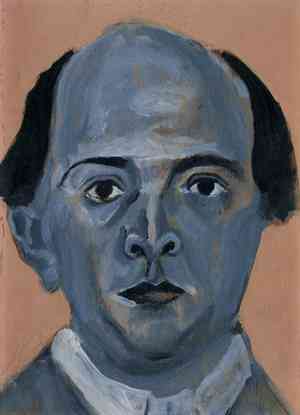 Blue Self Portrait by Schoenberg Source: Wkipedia |
|
Born in Danbury, Connecticut, on 20 Oct 1874, Charles Ives is the earliest American-born composer in these histories. Setting philosophy to music is among the reasons contributing to his notability. Though he made his living as a Wall Street insurance executive, he spent his spare time writing music, also authoring analytical texts. His father served as a bandleader during the Civil War. Ives began performing as youth as a drummer for his father. He is thought to have begun composing about the time he became a church organist at age fourteen. Among his earliest known works is 'Variations on 'America'' written in 1891, an arrangement for organ of 'My Country, 'Tis of Thee' (which was an American national anthem until the official adoption of 'The Star-Spangled Banner' in 1931) [1, 2, 3, 4, 5; audio of Edward Power Biggs at organ; orchestrated by William Schumann: audio of The President's Own Marine Band; live performance by the Victoria Symphony Orchestra conducted by Darryl One]. Ives attended the Hopkins School in 1893, then enrolled into Yale the next year. He began composing 'Symphony No.1' as a graduation project in 1898, though didn't complete its third of four movements until 1902 [1, 2, 3, 4; audio by the Philadelphia Orchestra w Eugene Ormandy or the National Symphony Orchestra of Ireland w James Sinclair; live performance by the Perm Opera & Ballet Theater Orchestra w Valery Platonov]. After Yale Ives took his first employment as an actuary for Mutual Life, later to form his own insurance company in 1907. in the meantime he composed 'Central Park in the Dark' for chamber in 1906, not to see its first performance until 1946. It was paired, however, with 'The Unanswered Question' of 1908 for publishing in 'Two Contemplations' the same year, that also the year he married one Harmony Twichell. ['Central Park in the Dark': 1, 2, 3, 4, 5, 6; audio by the Dallas Symphony Orchestra w Andrew Litton. 'The Unanswered Question': 1, 2, 3, 4, 5, 6, 7, 8, 9; audio of the New York Philharmonic w Leonard Bernstein, the Seattle Symphony w Ludovic Morlot, the Northern Sinfonia w James Sinclair w score; live performance by the Frankfurt Radio Symphony w Andrés Orozco-Estrada.] Ives spent 1908 to 1910 on 'Symphony No.3' ('The Camp Meeting') in B-flat major, though that didn't premiere until 5 May 1947 in New York, the same year it won the Pulitzer Prize [1, 2, 3, 4, 5, 6, 7; audio by Royal Northern Sinfonia Chamber Orchestra w James Sinclair; live performance by the Orchestra Now w James Bagwell]. Another of Ives' contemplations arrived in 1920 per 'Piano Sonata No.2' ('Concord, Mass., 1840–60' or simply 'Concord Sonata'), that paired to his text of the same year, 'Essays Before a Sonata' [1, 2]. ['Piano Sonata No.2': 1, 2, 3, 4, 5, 6, 7; audio w piano by Jeremy Denk; live performance by Stephen Drury.] Ives published his compilation, '114 Songs' in 1922 [1, 2, 3, 4], No.30 of which is 'From 'Paracelsus'' [*; audio sung by Roberta Alexander or Jan DeGaetani]. He wrote his last song, 'Sunrise', in 1926 [audio; live performance by Lucy Shelton]. About that time he began to experience trouble composing. His wife quotes him to say sometime in 1927, "nothing sounds right," apparently his eyes in tears. He left his final symphony, 'Symphony No.6' ('Universe Symphony'), unfinished in 1928, that begun back in 1911. Among performable versions eventually produced were Larry Austin's in '94 and Johnny Reinhard's in '96 [1, 2, 3; audio of Austin version, Reinhard version]. In 1930 Ives retired from the insurance business for reasons of health such as prior heart attacks and diabetes. Excepting revisions and a few improvisations in '38, his life as a composer was over as well. He did, however, attend four recording sessions from 1933 to 1943 [*], those compiled on 'Ives Plays Ives' [1, 2, 3]. Ives died of stroke on 19 May 1954 in New York City. References: 1, 2, 3, 4, 5, 6. Compositions: alphabetical; by genre: 1, 2, 3, 4, 5, Deutsch, Dutch, French, Italiano, Japanese; published works; 'A Descriptive Catalogue of The Music of Charles Ives' by James Sinclair: 1, 2, 3. Authorship published variously: '129 Songs': 1, 2, 3; 'Chips from the Workshop' *; 'Essays Before a Sonata, the Majority and Other Writings' *; 'Forty Earlier Songs' *; 'The Isles of Summer or Nassau and the Bahamas': 1, 2. Editions & scores: 1, 2, 3, 4, France, Germany. Collections Yale: papers, recordings. Sheet music. Song texts: 1, 2, 3. Audio: 1, 2, 3, 4, 5, 6, 7; reading of 'Essays Before a Sonata' by Edmund Bloxam. Recordings of: discos: 1, 2, 3, 4; select: 'Ives Plays Ives'; 'The Symphonies'; 'Universe Symphony': 1, 2. IMDb. Documentaries: 'The Unanswered Ives: American Pioneer of Music' written and directed by Anne-Kathrin Peitz 2018. Iconography. Further reading by source: Charles Ives Forum, John Kirkpatrick, Jan Swafford. Further reading by topic: Mahler and; programming of * (alt); style of. See also the Charles Ives Society. Bibliography: 1, 2; 'Charles Ives: A Bio-Bibliography' by Geoffrey Holden Block (Greenwood Press 1988); 'Charles Ives and His World' by Burkholder & Burkholder (Princeton U Press 1996) *; 'Charles Ives and His Music' by Henry Cowell (Oxford U Press 1955); 'Charles Ives: 'My Father's Song': A Psychoanalytic Biography' by Stuart Feder (Yale U Press 1992) *; 'Ives's '114 [+ 15] Songs' and What He Thought of Them' by Hugh Wiley Hitchcock ('Journal of the American Musicological Society' 1999) *; 'Just What Is Ives's Unanswered Question?' by Hitchcock & Zahler ('Notes' 1988) *; 'Charles Ives: A Research and Information Guide' by Gayle Sherwood Magee (Routledge 2010) *; 'Charles Ives Reconsidered' by Gayle Sherwood Magee (U of Illinois Press 2010) *; 'Ives and Mahler: Mutual Responses at the End of an Era' by Robert Morgan ('19th Century Music' 1978) *; 'A Descriptive Catalogue of the Music of Charles Ives' James Sinclair (Yale U Press 1999) *. Other profiles: Danish; Dutch; English: 1, 2, 3, 4, 5, 6, 7, 8, 9, 10; French; German; Italian; Japanese; Polish; Russian: 1, 2; Spanish. Charles IvesPiano Sonata 2 (Concord Sonata) 1915 Piano: Gilbert KalishSongs of Charles Ives [Selection] Mezzosoprano: Susan GrahamPiano: Pierre-Laurent Aimard 1926 Final composition Piano: Michael Stewart Soprano: Lucy Shelton Violin: Itamar Zorman 1898-1902 4 movements Perm Theatre Orchestra Valeriy Platonov 1897 1901 5 movements New York Philarmonic Orchestra Leonard Bernstein 1901 Revised 1911 B flat major Movement 1: 'Old Folks Gatherin' Northern Sinfonia Conductor: James Sinclair 1901 Revised 1911 B flat major Movement 2: 'Children's Day' Northern Sinfonia Conductor: James Sinclair 1901 Revised 1911 B flat major Movement 3: 'Communion' Northern Sinfonia Conductor: James Sinclair 1910-1924 Detroit Symphony Orchestra & Chorus Leonard Slatkin 'Orchestral Set 1' 1903-14 Revised 1929 3 movements BBC National Orchestra of Wales Nicholas Collon
|
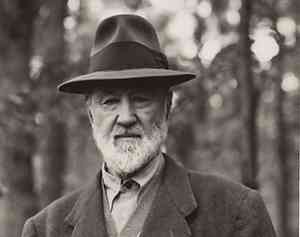 Charles Ives Circa 1946 Photo: Halley Erskine/Yale Music Library Source: Well-Tempered Ear |
|
| Born in Pozsony,
Austria-Hungary, on 22 December 1874,
Franz
Schmidt
was an Hungarian Roman Catholic man of his times who kept abreast with the times.
For Schmidt that would mean not any modernistic musical approach, but the regular
Nazi diet of Romanticism in Nazi-annexed Vienna with a touch of Nazi
mysticism eventually mixed into the brew. Compositions for organ emphasized
amidst
his greater catalogue, Schmidt moved to Vienna with his family in 1888, he
there to enter the Vienna Conservatory toward graduation in 1896. He then
played cello with the Vienna Court Opera Orchestra until 1914 when he became
a professor of piano at the Vienna Conservatory (Imperial Academy of Music
and the Performing Arts at the time). He also played cello with the Vienna
Court Opera Orchestra. In the meantime he had spent 1896 to '99 writing the
first of four symphonies, 'Symphony No.1', that premiering on 25 Jan 1902 in
Vienna [IMSLP;
audio w score of the Malmö Symphony Orchestra conducted by
Vassily Sinaisky].
He spent 1904 to '06 writing the work for which he is best known, his opera,
'Notre-Dame de Paris', though it didn't premiere in Vienna until 1 April 1914
three months before the beginning of WW I. Schmidt had written the libretto
for that along with Leopold Wilk, they inspired by Victor Hugo's 1831 novel,
'The Hunchback of Notre-Dame' [1,
2;
audio:
Part 1,
Part 2;
score: 1,
2].
That had been preceded by the premiere of 'Symphony No.2' in E-flat major by
the Court Opera Orchestra conducted by Franz Schalk on 3 Dec 1913
[IMSLP;
audio of the Chicago Symphony Orchestra w Neeme Jaervi or the
the Malmö Symphony Orchestra w Vassily Sinaisky w score].
World War I resulted in the Weimar Republic in Germany from 1918 to 1933 and the contemporaneous First Austrian Republic
from 1919 to 1934. During the decadent twenties on both sides of the
Atlantic (Roaring Twenties in the States) Schmidt kept a conservative
romantic
posture as he became Director of the Academy in 1825, Rector from 1927 to 1931. He taught
piano, cello, counterpoint and composition. It was a Vienna yet free of
looming troubles in which he had premiered 'Symphony No.3' in A major in
1928 [audio of the Chicago Symphony Orchestra w Neeme Jaervi or the
the Malmö Symphony Orchestra w Vassily Sinaisky;
score].
Hitler was appointed Chancellor of Germany on 30 January 1933 whence
troubles quickly began in Austria that would lead Europe to World War II,
such as the Civil War of '33
that put Engelbert Dollfuss in power first as Austrian Chancellor, then dictator.
Schmidt's 'Symphony No.4' in C major premiered in Vienna on 10 Jan of
1934 [IMSLP;
audio of the Wiener Philharmoniker w Zubin Mehta;
live performance by the Frankfurt Radio Symphony w Paavo Järvi].
That was seven months before the Nazi assassination of Dollfuss for preferring
political competition from nothing and no one. Germany had yet to wholly consume Austria
('38) when Schmidt retired from the Academy in early 1937 for reasons
of health, he now at the fore of his sixth decade. That same year he completed 'The Book with Seven Seals', believed to be the
first oratorio to address the 'Book of Revelation' by John
[1,
2,
3,
4,
5;
live performance of the First Seal by the Monteverdi Choir Würzburg conducted by Matthias Beckert].
Schmidt's final completed compositions arrived in 1938. One was 'Quintet in
A major' for left hand, clarinet and strings [*;
audio w Christopher Ayer
at clarinet;
audio w Karl-Andreas Kolly
at piano]. The other was 'Toccata in D Minor' for left hand
[audio w Stefan Warzycki at piano]. Schmidt died on 11 February of 1939 prior to Hitler's
Holocaust of Jewry from 1941 to '45. Hitler was riding high in the saddle at
the time of Schmidt's death. Six days later on the 17th he opened the annual
Berlin Motor Show when what would become known as the Volkswagen Beetle, a
car for the people, was first introduced. Four days after that on the 21st
Jews were directed to surrender valuables like gold and silver to the state.
Come World War II half a year later in September. As for Schmidt, he may have been more politically
naive than a Nazi. Though said to have given the Nazi salute on at least one
occasion, he wasn't likely Anti-Semitic, as he was of assistance to a number
of Jewish associates including friends and students. Internal argument may have been the reason he
left 'German Resurrection' unfinished while working on other compositions.
That commissioned by Hitler to include a Nazi text, it was likely less the
music with which Schmidt wrestled than its dubitable
theme, thus may have been left incomplete with
intentional noncommittal [1,
2].
References: 1,
2,
3.
Compositions:
alphabetical;
by genre: 1,
2,
3.
Editions & scores: 1,
2,
3,
4.
Audio: 1,
2,
3,
4,
5,
6.
Discos: 1,
2,
3.
Further reading: Gavin Plumley.
Iconography.
Biblio: 'Notre Dame' by Roland Graeme ('The Opera Quarterly' Summer 1990).
Other profiles English: 1,
2,
3;
Russian.
Franz Schmidt Piano Concerto in E flat major 1934 3 movementsWiener Jeunesse Orchester Herbert Böck Piano: Karl-Andreas Kolly 1896–1899 4 movements Malmö Symphony Orchestra Vassily Sinaisky 1911–13 3 movements Wiener Philharmoniker Erich Leinsdorf 1928 4 movements Malmö Symphony Orchestra Vassily Sinaisky 1932-33 4 movements Wiener Philharmoniker Zubin Mehta 1924 For organ Organ: Péter Szeles Variationen über ein Husarenlied 1931 Theme - 15 variations - CodaWiener Philharmoniker Hans Knappertsbusch |
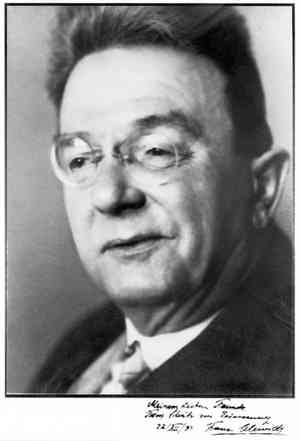 Franz Schmidt Source: Kultur Tirol |
|
| Born on 2 February 1875, the same
year as
Ravel, in Vienna,
Fritz
Kreisler, was a Jewish virtuoso violinist better known during his time
as a highly popular performer than presently as a composer, having faded
into relative obscurity since his death sixty years ago. The modernist in
Kreisler, whose main love was pulling material from out of the past, was a
career strongly given to recording for a span of forty-one years. Better known than his own
compositions are his arrangements of other composers, particularly for
violin and piano. He also "discovered"
numerous compositions by old masters which he later revealed to be his own,
those called his reversely plagiaristic "hoax" compositions which he went
for years content to let it be believed that such were by others than
himself until it was finally suspected that they might be his own. He was age seven when
he was permitted special entrance to the Vienna Conservatory to study under
Anton Bruckner. Wikipedia has him composing a fantasie
for violin and piano as early as 1883, probably age eight. At age 12 he won
the Paris Conservatoire's Prix de Rome in a competition with forty others at
least age twenty. He first visited the United States
in 1888. Some sources place his American premiere w the Boston Symphony in
Boston on 9 November with pianist, Moriz Rosenthal, and Walter Damrosch
conducting. Other place him at Steinway Hall in New York City on 10
November. Howsoever, returning to Austria the next year, he switched from music to
medicine upon inability to obtain a position with the Vienna Philharmonic.
Also spending time in the military, he returned to violin in 1899, whence a
performance in Berlin in December came to such applause as to decide his
career into the 20th century as a performer, returning to the United States
a second time from 1900 into '01. Kreisler made no bones about the poor
sound of early acoustical recording, his popularity beyond the live audience
considerably expanded through a heavy emphasis on recording throughout his
career.
Frank Hoffmann finds him recording five sides in 1904 for G&T
(Gramophone & Typewriter headquartered in the United Kingdom): Tchaikovsky's
'Song Without Words' G&T 2084, Sulzer’s 'Sarabande' G&T 2085, Sulzer's 'Sarabande'
G&T 2085, Schubert's bagatelle, 'The Bee', G&T 2085, Bach's 'Partita No. 3'
(recorded again in 1912) G&T 2087 and Bach’s 'Air on the G String' G&T 2087.
DAHR at ADP finds him on numerous titles for Victor as early as 11 May 1911
including Foster's 'Swanee River' ('Old Folks at Home') toward Victor 64130.
He had composed and published his Opus 2, 'Caprice Viennois', in 1910
[1,
2;
audio by various: 1,
2,
3;
live performance by Tao Lin (piano) & Ayano Ninomiya
(violin)]. An Op 2 implies that there was an Op 1 once upon a time, but
research thus far finds me unable to locate anything at all about it. Among
Kreisler's numerous arrangements for violin and piano gleaned from works by
other composers was 'Negro Spiritual Melody' adapted sometime in 1914 from
the Largo of
Dvorák's 'Symphony No.9' ('New World Symphony') Op 95
[audio of Marcel Gazelle (piano) & Yehudi Menuhin
(violin)]. Kreisler
was drafted into the Austrian Army during World War I, that to bring him to a
brief term of unpopularity with the Allies, notably America where he had the
most to lose.
Upon being wounded and discharged from the army he returned to New York to
publish 'Four Weeks in the Trenches' in 1915
[text: 1,
2,
3,
4,
5;
audio]. In 1924 Kreisler moved
back to Berlin, during which period his hoaxes came to light when on
Kreisler's 60th birthday in 1935 music critic for the 'New York Times', Olin Downes, finally asked Kreisler if some of his "lost classics" were not
actually his own compositions
[1,
2,
3;
list]. Kreisler had made no particular attempt to
make his hoaxes mimic the composers he had posed, and waited not a few years
for someone to guess it. Hyperion estimates his initial hoax to have been
written circa 1905. IMSLP has him publishing numerous of above a dozen as
early as 1910 ["falsely attributed"]. Kreisler had postured even a concerto supposedly by
Vivaldi
since 1927 per 'Concerto in C Major'. He recorded that himself eighteen
years later w the
RCA Victor Orchestra on 2 May of 1945 at the Lotos Club in NYC
[Naxos;
audio w score;
see also audio of Gil Shaham and
live performance by Ilya Kaler].
Kreisler wrote the score for the film, 'The King Steps Out', premiering in the USA on 28 May
1936, that starring Grace Moore
as Elizabeth [1,
2].
Leaving Berlin for France in 1938, the outbreak of World War II found
him back in America to become a U.S. citizen in 1943. Of his several
operettas, 'Rhapsody' arrived to the New Century Theatre in Manhattan on 22
May 1944 [IBDB].
Naxos traces his last recording session to the Lotos Club on 20 December
1946 toward 'Stars in My Eyes' [audio] and the 'Viennese Rhapsodic Fantasietta'
[audio]
issued on RCA Victor 11-9952. He delivered his last
public concert in 1947. During his latter years he involved himself with
charitable causes as his hearing and eyesight worsened. Wikiwand has him
winning a Karl Renner Prize in 1959,
this article
dated 9 April 1960. Kreisler died in NYC in 1962 and was buried in Bronx.
References: 1,
2,
3.
Compositions:
alphabetical: 1,
2;
by genre: 1,
2;
arrangements.
Editions & scores: 1,
2,
3,
4.
Collections: Library of Congress: 1,
2.
Sheet music.
Audio: 1,
2,
3,
4.
Recordings of: discos: 1,
2,
3,
4,
5,
6;
select: 'The Charming Maverick'
*;
'The Complete Recordings':
1,
2,
review.
Documentaries: silent film (date unknown).
Further reading: newspapers;
recordings: 1,
2.
Fritz Kreisler Wettbewerv (FK
Competition).
Iconography.
Other profiles: English: encyclopedic: 1,
2;
musical: 1,
2,
3,
4,
5,
6,
7;
Italian.
Kreisler plays violin on a number of
works below, all composed by him unless otherwise noted. Fritz Kreisler Composer: Tchaikovsky 1867 Op 2:3 Piano piece [arranged with violin] Violin: Fritz Kreisler Recorded 1904 'In the style of Vivaldi' 3 movements RCA Victor String Orchestra 1905 Piano: Franz Rupp Violin: Fritz Kreisler Recorded 1938 1905 Violin: Fritz Kreisler Recording 1: 1930 Berlin Recording 2: 1942 Philadelphia Sarabande for violin and piano Composer: Sulzer Op 8 Published 1888Violin: Fritz Kreisler Recorded 1904 1910 'In the style of Pugnani' For piano & violin Double bass: Catalin Rotaru Isolda Crespi: Piano 1938 'In the style of Pugnani' For piano & violin toshiajapan Viennese Rhapsodic Fantasietta 1948Conductor: Donald Voorhees Violin: Fritz Kreisler |
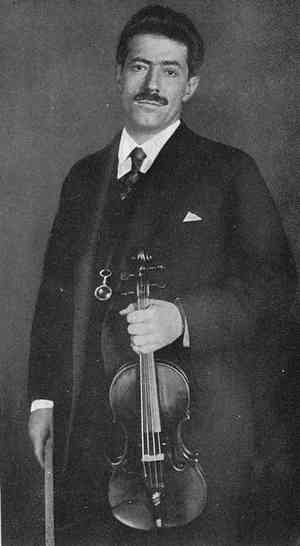 Fritz Kreisler Source: Richard Hacken |
|
| Born on 23 Nov 1876 in Cádiz in
southern Spain,
Manuel de
Falla
began taking formal lessons in piano at age nine. In 1896 he entered the Real Conservatorio de Música y Declamación in Madrid,
also composing his early piece for piano, 'Nocturne', premiered by himself
in Cadiz on 16 August 1896 [*;
audio of piano by
Esteban Sánchez w score;
live performance by Carol Ruiz;
scores: 1,
2].
He composed a lost stage work in 1897 titled, 'El conde de Villamediana',
but his 'Melodia' that year for violoncello and piano remains
[audio of Menchu Mendizábal (piano) & Emilio Mateu (viola)].
He followed that in 1898 w 'Pieza en Do Mayor' [audio of Miguel Zanetti (piano) & Emilio Mateu (viola)].
His 'Mazurka' in C minor for piano arrived in 1899. He began to teach
privately for an income in 1900, another early piano
piece appearing that year in 'Cancion' [audio of piano by
Javier Perianes w score]. It was about that time
that Andalusian
Flamenco became of interest to him. Andalusia is
Spain's southernmost autonomous region. Among his compositions during
that period were a number of zarzuelas, the zarzuela a Spanish form of opera.
He composed 'La Vida Breve' in 1904-05 toward its eventual premiere at the Casino Municipal in Nice
on 1 April 1913. That was revised in December of 1913 [1,
2,
3,
4;
live performances by NEC Philharmonia conducted by
Douglas Kinney Frost;
Tiago Assis Choir & S O of the Theatro da Paz Opera Festival conducted by Miguel Campos Neto].
He began his cuatro 'Piezas Españolas' for piano in 1906, not to premiere until 27
March 1909 in Paris [1,
2;
audio of Garrick Ohlsson;
scores]. In 1907 Falla moved to Paris where
he aligned himself with the more modern composers such as
Ravel. He received a grant
in 1908 from King Alfonso XIII to complete 'Cuatro piezas españolas'. In
1911 he began a tour of London, Brussels and Milan. During World War I he
left Paris for Madrid, there coming something into his own during the War.
He composed the ballet, 'El Amor Brujo' ('The Bewitched Love'), in 1915
toward its premiere in Madrid at the Teatro Lara on 15 April 1915. He later
wrote versions for small orchestra as well as piano before revising it in
1925 [1,
2,
3,
4,
5;
audio of the Spanish RTV Orchestra w Igor Markevitch w score;
live performance Buchmann-Mehta School of Music Chamber Series w
Avi Taler].
The eighth movement of 'El Amor Brujo' is Falla's famous 'Danza Ritual del Fuego' ('Ritual Fire Dance') [*;
audio: Orquesta Sinfónica de Praga w Alirio Diaz;
piano by Joseph Stefanits;
live performance by the Auckland Symphony Orchestra w Peter Thomas]. 'Nights in the Gardens of Spain'
for orchestra and piano premiered at the Teatro Real on 9 April 1916 w
Enrique Fernández Arbós conducting the Orquesta Sinfónica de Madrid
[1,
2,
3,
4,
5;
live performances: Chicago Symphony Orchestra conducted by Plácido Domingo w Daniel Barenboim at piano;
NHK Symphony Orchestra conducted by Charles Dutoit w Yuja Wang
at piano]. Pablo Picasso designed costumes for Falla's ballet, 'The Three-Cornered Hat',
also appearing wartime in Madrid at the Teatro Eslava on 6 April 1917
[1,
2;
audio by the Orchestre de la Suisse Romande w Ernest Ansermet w score;
live performance by the BBC Philharmonic w Juanjo Mena & soprano Clara Mouriz].
Moving to Granada in 1921. He there began working on a cantata called
'Atlántida' in 1926 which grew over the years into the unfinished opera, 'Atlántida'.
Completed by his student, Ernesto Halffter, the concert version
finally premiered posthumously in Barcelona on 25 Nov 1961, the staged
version on 18 June 1961. Falla considered 'Atlántida' to be his best work
[1,
2,
3,
4,
5,
6,
7;
audio of the Orquesta Nacional de España conducted by Rafael Frühbeck de Burgos w soprano Enriqueta Tarrés; live performances:
direction by Jesus Lopez Cobos;
Memorial Pau Casals]. In 1939
Falla
moved to Argentina, Franco having been victorious upon the Spanish Civil
War (1936-39). He was named a Knight of the Order of Alfonso X of Castile
[*] in 1940 before dying of cardiac
arrest on 14 November of 1946 in Alta Gracia, Argentina.
References: Wikipedia.
Chronology.
Compositions: alphabetical: 1,
2;
by genre: 1,
2,
3,
4;
stage works.
Vocal texts.
Documents: 1,
2,
3,
4;
France: 1,
2.
Sheet music: 1,
2.
Used books.
Audio: 1,
2,
3,
4,
5,
6.
Recordings of: discos: 1,
2,
3,
4;
select: 'Musically Speking: Falla'
*;
''Nights in the Gardens of Spain' | 'The 3-Cornered Hat'' by the London Symphony Orchestra w
Gerard Schwarz;
'La Vida Breva':
review.
IMDb.
Iconography.
Further reading: Conservatorio Superior de Manuel de Falla: 1,
2;
Jack Weiner on Francisco Fedriani and;
Jack Weiner on Juan de Tasis and
(alt).
Bibliography: 1,
2;
'Manuel de Falla: His life & Works' by Armero & Persia (Omnibus Press 2012)
*;
'Manuel de Falla and Modernism in Spain: 1898-1936' by Carol Hess (U Chicago Press 2001)
*;
'Sacred Passions: The Life and Music of Manuel de Falla' by Carol Hess (Oxford U Press 2004)
*;
'Manuel de Falla' by Nancy Lee Harper (Greenwood Publishing Group 1998)
*;
'Manuel de Falla: His Life and Music' Nancy Lee Harper (Scarecrow Press 2005)
*;
'Manuel de Falla's Cuatro 'Piezas Españolas'' by Yu-Hsuan Liao.
Other profiles:
English: encyclopedic: 1,
2,
3;
musical: 1,
2,
3,
4;
French;
Italian;
Japanese: 1,
2;
Russian: 1,
2;
Spanish: 1,
2.
Manuel de Falla El amor brujo (Spell-bound Love) 1914–1925 BalletOrquesta de Postsmout/John Rosten Contralto: Dolores Arriaga 1919 For piano to Arthur Rubinstein Piano: Aldo Ciccolini 1915 Three gardens Chicago Symphony Orchestra Piano: Daniel Barenboim Pour le tombeau de Claude Debussy 1920 For guitarGuitar: Julian Bream 1935 For piano Piano piece [arranged with violin] Violin: Fritz Kreisler Recorded 1904 1917 Ballet BBC Philharmonic/Juanjo Mena Mezzosoprano: Clara Mouriz 1899 For piano Piano: Azumi Nishizawa |
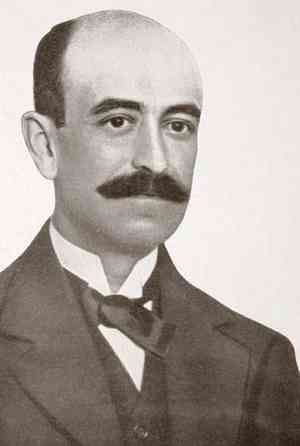 Manuel de Falla Source: Britannica |
|
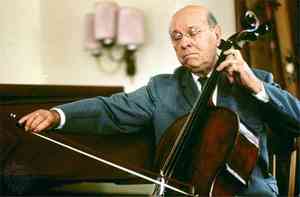 Pau Casals 1965 Source: Britannica |
Born Pau Casals i Defilló
on 29 Decmber 1876 in El Vendrell, Catalonia, Spain,
Pablo
Casals
wasn't so much a composer as conductor, not so much a conductor as a
cello virtuoso, and a load of all three. He began playing violin, piano and
flute at age four. The Pau Casals Fundacio has
him performing in public for the first time in the choir of the church of El
Vendrell on 27 April 1882. Casals' father had been an organist and choir master whom
he helped compose the score to the play, 'Los Pastorcillos en Belén' ('The Little Shepherds in
Bethlehem'), as early as 1883
[*]. Casals
didn't pick
up cello until age eleven.
He entered the Escola Municipal de Música in Barcelona in 1888 and began to perform
regularly at the Cafè Tost in Barcelona in 1889. Titles composed as early as
1892 were
'Concert per a violoncel i piano', 'Minuet per a quintet de corda' and his queix (complaint) for voice and
piano, 'A tu-des de Santes Creus', with text by Joan Ramone. Come 'Romança
per a cant i piano sobre una poesia de Heine' for voice and piano in
1893 along with 'Quartet en mi menor', 'Balade' for piano and 'Pastoral per a violoncel i piano'
for cello and piano [live performance by Peter Schmidt (cello) and Katia Michel (piano)].
Casals had graduated from the Escola Municipal in 1893 toward study of composition at the Real Conservatorio de Música y
Declamación in Madrid the same year. Casals tried working in Paris briefly before
returning to Escola Municipal de Música as a faculty member. He also joined
the orchestra at the Liceu, an opera house in Barcelona. In 1899 Casals
played in London at the Crystal Palace as well as for Queen Victoria at her
Osborne House. He next toured Paris, Spain and Netherlands before his first
trip to America in 1901. He performed for Theodore Roosevelt in 1904 as well
as at Carnegie Hall. In 1905 Casals formed a trio with pianist, Alfred
Cortot, and violinist, Jacques Thibaud, with whom he worked until 1937, they
also recording together. Casals made his first recordings 1915.
DAHR shows
sessions as early as 15 Jan for 'Salut d'amour' issued on Columbia A5679
[audio],
'Largo' (A5649), 'Melody in F' (A5649) and 'Concerto in D minor: Adagio'
(A5654). Most composers
weren't eager to make early acoustic recordings due to their poor fidelity.
Recordings were made more in debt to the new technology that was the gramophone
than wish to disseminate or
preserve for posterity simply because they didn't sound very good. Not until
the development of the microphone and studio electronics in the twenties
did recording become of considerable interest. Casals nevertheless issued
numerously for Columbia, recording electronically later in the twenties for
Victor and Gramophone. Casals didn't begin
conducting until 1919 when he formed the Pau Casals Orchestra. Its first
performance in 1920, it ceased existence upon the outbreak of the Spanish
Civil War in 1936 (Casals a Republican). In 1926 he composed 'La Sardana'
for cello ensemble [audio by the London Cello Sound w Geoffrey Simon].
He began introducing his concerts w the traditional Catalan Christmas song,
'Song of the Birds', in 1939 upon his exile from Spain, never to return to
the Franco regime of 1939-75 [performance
by Casals at the White House 1961]. During World War II Casals settled in Prades in the French Pyrenees.
His 'Nigra Sum'
('I Am Black') arrived in 1942 to verses from 'Song of Solomon' [audio: Elektra Women's Choir;
Voices of Ascension;
live performances: Gondwana Voices;
Georgia Boy Choir;
Paris Boys Choir;
Peninsula Girls Chorus]. In 1950
Casals organized the first Prades Festival over which he would annually preside
until 1966. In 1955 he toured Puerto Rico where the first annual Casals
Festival was inaugurated in 1956. Casals founded the Puerto Rico Symphony
Orchestra [*] in 1958 and the
Conservatory of Music of Puerto Rico [*] in 1959.
It was in Puerto Rico that he appeared in the documentary film, 'Windjammer', in
1958 [1,
2,
3,
4,
5;
Casals performs 'Song of the Birds'].
Casals' oratory, 'El Pessebre' ('The Crib', 'The Manger'),
premiered in 1960 w libretto by Joan Alavedra [*;
audio by the Orquestra Simfònica de Barcelona i Nacional de Catalunya]. A
number of Casals' master classes during the sixties were televised
[1960].
Per above, in 1961 he performed for President, John Kennedy, at
the White House [audio].
Casals premiered his 'Hymn to the United Nations' w libretto by Wystan Hugh
Auden at the United
Nations on 24 Oct 1971 [*;
interpretations: 1,
2].
He that day delivered his famous speech to the General Assembly
[1,
2,
3,
4,
5;
YouTube: 1,
2,
3].
Casals died on 22 Oct 1973 in Puerto Rico from complications
following a heart attack three weeks prior. Not having performed in Spain
since '39, he was there honored
posthumously in 1976 by King Juan Carlos I.
References: 1,
2,
3.
Chronologies: Catalan;
English: 1,
2;
Spanish: 1,
2.
Compositions: alphabetical;
chronological: Catalan: 1,
2;
by genre: Catalan;
English:
instrumental,
transcriptions,
vocal;
Galician.
Documents: 1,
2,
3,
France.
Collections: National Archive of Catalonia
*.
Audio: 1,
2,
3,
4,
5,
6,
7,
8.
Recordings of: discos: 1,
2,
3,
4,
5,
6;
select: 'El Pessebre'.
Interview 1955.
IMDb.
Iconography.
Further reading: education;
PC Festivals: Catalonia: 1,
2;
Puerto Rico;
PC Foundation;
PC Museum.
Bibliography: 1,
2;
'Reflexions de Pau Casals' Albert Eugene Kahn
*;
'Song of the Birds' ed. by Julian Lloyd Webber (Robson Books 1985)
*;
used books.
Other profiles:
Catalan: 1,
2,
3;
Deutsch;
English: encyclopedic: 1,
2,
3,
4;
exhibition;
musical: 1,
2,
3,
4;
Finnish;
French;
Italian;
Portuguese;
русском;
Spanish: 1,
2,
3,
4,
5,
6.
The six Brandenburg concertos (BWV 1046-51)
by
Johann Sebastian Bach below example Casals conducting
the Marlboro Festival Orchestra.
Bach composed them in 1721. Pau Casals Composer: Beethoven 1796 Op 5:1 Piano: Mieczysław Horszowski Violin: Pablo Casals Recorded 1939 Composer: Johann Sebastian Bach 1720? BWV 1012 7 movements Cello: Pablo Casals Concert at the White House Side 1 Recorded 1961 Released 1962Cello: Pablo Casals Piano: Mieczysław Horszowski Concert at the White House Side 2 Recorded 1961 Released 1962Cello: Pablo Casals Piano: Mieczysław Horszowski premiere 1971 United Nations Bolshoj Opera Theatre of Belarus Choirmaster: Nina Lamanovich Conductor: Vyachaslau Bartnouski 1926 For cello Conductor: Geoffrey Simon 'El Cant dels Ocells' Traditional Catalan Christmas lullaby Cello: Pablo Casals Performance: 1971 United Nations |
|
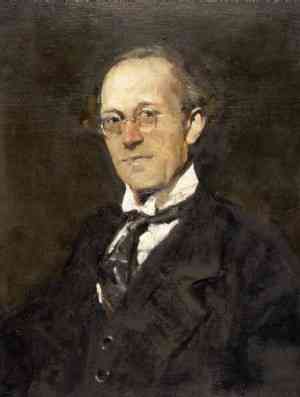 Franz Schreker Source: NAXOS |
Born on 21 March 1878 in Monaco,
Franz Schreker wrote largely operas, orchestral music and songs. He
was a Jew whose father was a court photographer. His family moving to Vienna in 1888, Schreker entered the Vienna Conservatory in 1892 with a scholarship.
As a student of violin and composition, he wrote works listed to as early as 1894 by Johannes Hanstein, the
OREL Foundation and
Spanish Wkikipedia,
those being 'Des Meeres und der Liebe Wellen für Singstimme und Klavier' and
'Die Rosen und der Flieder für Singstimme und Klavier'
[audio of Hermine Haselböck
(mezzo-soprano) & Russell Ryan (piano)]. Schreker began conducting with a group of
associates he called the Dobling Friends of Music in 1895. He composed his
'Symphony' in A minor Op 1 in 1899 before graduating from the Conservatory in
1900 [*;
audio of the Kölner Rundfunkorchester w Peter Gülke;
CD]. He completed his first opera, 'Flammen'
Op 10, in 1902, but it was never
performed in Schreker's lifetime [audio of Kiel Opera Chorus & P O w Ulrich Windfuhr]. He formed the Vienna Philharmonic Chorus
in 1907. Schreker became a professor at the Vienna Music Academy in 1913.
Schreker's greatest work is probably his sixth opera w libretto by himself, 'Der Schatzgräber'
('The Treasure Hunter'). The score dated 12 November 1918, it premiered in
Frankfurt on 21 January 1920 w conducting by Ludwig Rottenberg
[1,
2;
audio of Act 3 of four;
score]. In
1920 he was appointed director of the Hochschule für Musik (Berlin
University of the Arts). Now at the height of his career, works to follow
witness his decline. Schreker's final of ten operas premiered at the
Berlin Städtische Oper on 29 October 1932 w conducting by Paul Breisach,
that apparently troubled by a group finding Schreker's Jewish heritage
disagreeable [1,
2,
3,
4,
5;
live performance by the Chorus & Symphonic Orchestra Opera Ballet Vlaanderen conducted by Alejo Pérez]. The rise of National Socialism in Germany saw Schreker stripped of his teaching posts as of 1933, the year before he died
of stroke in Berlin on 21 March 1934. References: 1,
2,
3,
4.
Chronologies: 1,
2.
Compositions:
alpha: 1,
2,
3;
chrono: 1,
2,
3;
by genre: Deutsch;
English: 1,
2;
Francais;
chamber;
choral;
opera: 1,
2,
3;
orchestral;
orchestrations;
piano solo;
piano & voice;
songs: 1,
2;
stage works.
Song texts.
Editions & scores: 1,
2,
France.
Books & documents: 1,
2,
3,
France,
Germany.
Audio: 1,
2,
3,
4.
Recordings of: discos: 1,
2,
3,
4,
operas;
select:
'Orchestral and Choral Music' w Peter Gülke;
'Overtures' by the Slovak Philharmonic Orchestra w Edgar Seipenbusch;
'Der Schatzgräber' by the Chorus of the Nederlands Opera and the
Nederlands Philharmonic Orchestra w Marc Albrecht: 1,
2.
Iconography: 1,
2.
Further reading: the fin de siècle and;
the Franz Schreker Foundation;
by Christopher Hailey:
'Discovering a Distant Sound' ('Musikblätter' 2011)
*,
'Intermezzo' und 'Scherzo'
*,
songs,
solo klavier.
Bibliography: 1,
2;
'Franz Schreker' by Robert Blackburn ('The Musical Times' 1976).
Other profiles: Czech;
Deutsch: 1,
2,
3;
Dutch;
English: 1,
2,
3;
Espanol;
Francais;
Italiano;
русском;
Swedish.
Franz Schreker 1916 Los Angeles Chamber Orchestra Gerard Schwarz premiere: 1933 Opera 2 acts Kiel Opera Chorus Kiel Philharmonic Orchestra Ulrich Windfuhr 1902 Op 11 WDR Sinfonieorchester Köln & Chor Peter Gulke 1908–1909 WDR Sinfonieorchester Köln Peter Gulke 1913 Gürzenich-Orchester Kölner James Conlon 1932–1933 Melodrama Sprecher: Gerd Westphal 1909 Grupo Encuentros Alicia Terzian |
|
| Born on 9 July 1879 in Bologna,
Ottorino Respighi composed largely chamber, orchestral,
choral and dramatic works. Having a piano teacher for a father, he was more a romantic who composed during
the Early Modern period than a modernist of any sort. Respighi is catalogued
by "P" number per Potito Pedarra's 1985 'Catalog of the Works of Ottorino
Respighi'. His P 001 is 'Piccola Ouverture' of 1893. Graduating from
studies in Bologna in composition, music history, viola and violin in 1900,
Respighi went to St. Petersburg where he became a violist at the Russian
Imperial Theatre. He also studied composition with
Rimsky-Korsakov.
Respighi's first of 12 operas, not all completed, was 'Re Enzo'
P 055 premiering on
12 March 1905 at the Teatro del Corso in Bologna. He
spent a brief time in Germany in 1908 before returning to Italy in 1909. In
1913 Respighi began teaching at the Conservatorio di Santa Cecilia in Rome.
His star finally
began to rise w his best-known work, 'Fountains of Rome' P 106, a symphonic poem
premiering in wartime Rome at the Teatro Augusteo on 11 March 1917
[1,
2,
3,
4,
5;
audio of the Finnish Radio S O w Sakari Oramo;
live performances by the Jacobs School of Music Ad Hoc S O w Danko Daniel Drusko &
the Victoria S O w Darryl One].
His piano four hands version of that, P 115, was also published in 1918 [live performances by Aldo De Crescenzo & Pier Giorgio De Lucia
* or
Marcos Madrigal & Alessandro Stella *].
Come his ballet, 'La Boutique Fantasque' P 120, in 1918
[1,
2,
3;
audio by the National Philharmonic Orchestra w Richard Bonynge or
the Cincinnati Symphony Orchestra w Jesús López-Cobos]. The first performance of his 'Brazilian
Impressions' P 153 was in 1928 in Rio de Janeiro
[audio by the London S O w Antal Dorati or
the Buffalo P O w JoAnn Falletta].
Come 'Gli Uccelli' ('The Birds') P154 the same year
[1,
2,
3;
audio by the Philadelphia Orchestra w Eugene Ormandy]. Though said to be apolitical,
Respighi became a member of the Royal Academy of Italy in 1932, a Fascist
organization of academics, artists and intellectuals (1926-43) in which
atmosphere he worked the remainder of his career. His final opera, 'Lucrezia'
P 180, premiered posthumously on 24 February 1937 at the Teatro alla Scala
in Milan. Left unfinished, it had been completed by student and wife,
Elsa Respighi
[1,
2,
3;
audio by the Slovak Radio Symphony Orchestra w Adriano]. P 181 through P 199 in the Pedarra directory are works with
unknown dates. Respighi died of cardiac infection on 18 April 1936.
References: 1,
2.
Compositions:
alpha: 1,
2;
by genre: 1,
2,
3,
Italian,
Japanese;
Pedarra directory: 1,
2,
Italian;
operas.
Editions & scores: 1,
2,
3,
Germany.
Books & documents: 1,
2,
3.
Sheet music.
Audio: 1,
2,
3,
4,
5,
6,
7.
Recordings of: discos: 1,
2,
3,
4,
5;
select: ''La Boutique Fantasque' | 'Gli Uccelli'' by the Orchestre Sinfonica del Teatro Massimo di Palermo w
Marzio Conti;
''Impressioni Brasiliane' | 'La Boutique Fantasque'' by the Orchestre Philharmonique Royal de Liège w
John Neschling;
'Piano Four Hands' by Giulio Biddau & Norberto Cordisco Respighi:
1,
2,
3.
IMDb.
Iconography.
Further reading: newspaper archives;
the Respighi Prize.
Other profiles: English: encyclopedic:
1,
2,
3;
musical:
1,
2;
French;
German;
Italian: 1,
2;
Japanese.
Ottorino Respighi 1916 P 115 Symphonic poem 4 movements National Youth Orchestra of Canada 1928 P 153 3 pieces 1: Tropical Night2: Butantan 3: Song and Dance The London Symphony Orchestra Antal Dorati Lauda per la Natività del Signore 1930 P 166 SongCity of London Sinfonia Richard Hickox 1917 P 110 Violin: Leonidas Kavakos Piano: Yuja Wang 1927 P 151 3 paintings 1: La primavera 2: L'adorazione dei Magi 3: La nascita di Venere Orpheus Chamber Orchestra 1928 P 154 Prelude - Dove - Hen - Nightingale - Cuckoo Atlanta Symphony Orchestra Louis Lane |
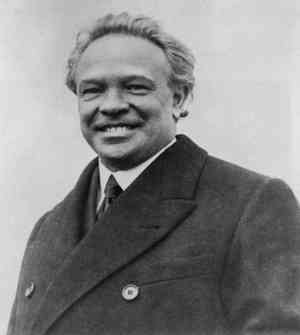 Ottorino Respighi Source: Bach Cantatas |
|
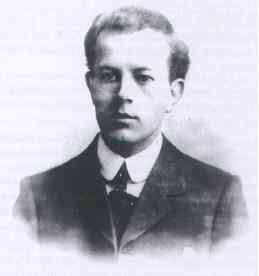 Edgar Bainton Source: Tchaikovsky Research |
Born in London on 14 Feb 1880,
Edgar
Leslie Bainton had composed works for
chamber, chorus, songs, church music and orchestra including symphonies. He
was raised in Coventry, the son of a minister. His first public appearance
at piano was at age nine. In 1896 he won a scholarship to the Royal College
of Music [1,
2,
3]. His earliest extant work is 'Prelude and Fugue' in B minor of 1898, assumed
without certainty
to be listed as 'Variations and Fugue' Op 1 w a date of 5 July at
MusicWeb International.
Bainton
began teaching at the Newcastle upon Tyne Conservatory of Music in 1901. MusicWeb International has his 'Symphony No.1'
('Before Sunrise') dated 16 Dec 1907, winning a Carnegie British Music Award
ten years later in 1917, yet not publicly performed until 6 April 1921 by
the Newcastle and Gateshead Choral Union and Orchestra conducted by himself
at the Newcastle Town Hall. Bainton was in Germany
in 1914 to attend the Bayreuth Festival when World War I began. He was
arrested and interned at a detention camp for the next four years. Returning
to the Conservatory after the War, his 'String Quartet' in A major appeared
in 1919. Among Bainton's best-known works is the
choral setting for John's 'Revelation' 21:1-4, 'And I Saw a New Heaven' in D minor w a date of 13 June 1928
[1,
2;
audio by the Westminster Choir w Joseph Flummerfelt,
the Choir of New College Oxford w Edward Higginbottom
or the Guildford Cathedral Choir w Barry Rose;
live performance by King's Counterpoint w David Acres].Bainton began touring
internationally in 1930, visiting Australia and Canada, then India in 1932.
In 1934 Bainton became director at the New South Wales State Conservatorium
of Music in Sydney [1,
2]. His opera, 'The Pearl Tree', premiered in Sydney
in 1944. In addition to conducting the
Sydney Symphony Orchestra [1,
2,
3], Bainton
also briefly conducted the
New Zealand Symphony Orchestra [1,
2,
3]. He lectured in
Canada for a time, until a heart attack took his life on 8 December 1956 while at the
beach in Sydney. References: 1,
2.
Compositions: alphabetical: 1,
2;
by genre: 1,
2,
3,
chamber;
chorus & orchestra;
church & organ;
piano;
songs.
Books & documents: 1,
2.
Audio: 1,
2,
3,
4.
Discos: 1,
2,
3.
See also The Edgar Bainton Society (UK).
Other profiles: Dutch: 1,
2;
English: 1,
2,
3,
4;
French;
русском.
Edgar Bainton 1928 Guildford Cathedral Choir Barry Rose Into the Silent Land/The Goddess' Glory Adelaide SingersPatrick Thomas BBC Philharmonic Orchestra Paul Daniel 1919 Austral String Quartet 1939-40 Sydney Symphony Orchestra Edgar Bainton 1956 4 movements BBC Concert Orchestra Vernon Handley 1: Elegy 2: Intermezzo 3: Humoresque Sydney Symphony Orchestra Joseph Post |
|
| Born in Parma, Italy, on
28 Sep 1880,
Ildebrando Pizzetti had
composed largely chamber, orchestral and dramatic works (operas). He had a
pianist and piano teacher for a father. Pizzetti enrolled at the entered the
Conservatorium of Parma in 1895. Greene & Green have him writing his initial
opera, 'Sabina', in 1897, libretto for that by Annibale Beggi. Flaminio adds tres
mas titles that year per Riccardo Viagrande (2013):
'Improviso sinfonico', 'Tre cori sacri' and 'Minuetto per quartetto d'archi'. He was Director at the Conservatory of
Florence from 1917 to 1923,. Lending example of a pre-War work is 'L'Annuncio'
para voz y piano in 1913 [live performance by Hanna Hipp (mezzo-soprano) & Emma Abbate (piano)].
Following the War he wrote another piece for voice and piano in 1920 called
'Lamento' to a text by Percy Shelley. Come 'Cello Sonata' in F major in 1921
for violoncello and pianoforte [audio].
Piazetti spent 1922-23 writing the liturgical work, 'Messa Requiem' in five
movements
[1,
2;
audio of the Conspirare Company of Voices
w Craig Hella
performing 'Dies Irae' ('Day of Wrath') 2/5; live performances by the National Youth Choir of Australia w David Hill:
Dies Irae 2/5,
Sanctus 3/5,
Agnes Dei 4/5]. Pizzetti became Director at the Milan Conservatory in 1923. Among works composed during that period was 'Tre intermezzi sinfonici' in
1927 for a staging of ’Edipo Re' written by Sophocles circa 425 BC [1,
2,
3;
Sophocles' 'Edipo Re']. Pizzetti served as Director at the
Academy of St. Cecilia in Rome from 1936 to 1958. In 1939 he became a member
of the Royal Academy of Italy, a Fascist organization of academics, artists
and intellectuals (1926-43) in which climate he worked through World War II.
'Symphony in A' was composed between February and June of 1940 for recording in 1940 in
celebration of 2600 years of Japanese Empire, major ally of Fascist Italy.
Its first public performance was in wartime Milan at the Teatro alla Scala
on 20 October 1941
[1,
2,
3;
Orchestra Sinfonica Nazionale della RAI w Damian Iorio].
Pizzetti's finest work was probably 'Violin Concerto' in A composed in 1944 toward premiere
by
violinist, Gioconda de Vito [1,
2],
at the Teatro Adriano in Rome on 9 Dec 1945
[*;
audio of the Orchestra Sinfonica di Roma della RAI conducted by Ferruccio Scaglia w
Pina Carmirelli at violin or the Orchestra Filarmonica Marchigiana conducted by Daniele Agiman w
Črtomir Šiškovič at violin].
Come the jubilee year of the 20th century with his opera, 'Ifigenia',
premiering on radio from the RAI Auditorium in Turin on 3 Oct 1950 w
libretto by himself and Alberto Perrini [1,
2,
3;
audio extract 1956].
Come his favored opera, 'Assassinio nella Cattedrale', to La Scala in Milan
on 1 March 1958 [1,
2,
3,
4,
5;
audio by various: 1,
2,
3].
That was drawn from T.S. Eliot's 1935 'Murder in the Cathedral' [*]. Come Pizzetti's 'Concert' in E major for harp and orchestra in 1960
[*;
audio of the Orchestra Sinfonica Nazionale della RAI conducted by Damian Iorio w Margherita Bassani at harp].
The opera, 'Clitennestra', premiered at La Scala on 1 March 1965 w
conducting by Gianandrea Gavazzeni [1,
2,
3;
audio of the Orchestra e Coro del Teatro alla Scala di Milano directed by Gianandrea Gavazzeni:
1,
2].
The cantata, 'Filiae Jerusalem' for soprano, female choir and orchestra, was
first performed in Rome on 27 October 1966 [*;
audio extract]. Pizzetti died on 13 February 1968, not well known beyond Italy.
References: 1,
2.
Chronology.
Compositions:
alphabetical: 1,
2;
chronological: 1,
2.
3,
per Riccardo Viagrande (2013);
by genre: 1,
2,
3,
4,
5;
chamber;
operas: 1,
2;
piano;
soundtracks;
stage;
symphonic;
vocal.
Authorship: 1,
2.
Vocal texts.
Editions & scores: 1,
2;
France: 1,
2;
Germany,
publishers of first editions.
Books & documents: 1,
2.
Audio: 1,
2,
3,
4,
5.
Discographies: 1,
2,
3,
4;
select: 'Assassinio nella Cattedrale': 1,
2;
'Ifgenia': 1,
2;
''Symphony in A' | 'Harp Concert'' by the RAI Symphony Orchestra w Margherita Bassani:
1,
2,
review.
Further reading: Gianandrea Gavazzeni (1939).
Bibliography:
'Ildebrando Pizzetti' by Gatti & Baker ('The Musical Quarterly' 1923);
''Assassinio nella Cattedrale'' by John Waterhouse.
Other profiles:
Deutsch;
English: 1,
2,;
Francais;
Italian: 1,
2,
3,
4,
5;
Spanish: 1,
2.
Unless I've missed something somewhere,
'Symphony in A' of 1940 below is the earliest recording by Japanese musicians
to be documented in this
entire history centric to the Western hemisphere. Ildebrando Pizzetti 1958 Opera C & Odel Teatro alla Scala di Milan Gianandrea Gavazzeni 1952 Opera C & OS di Torino della RAI Cagliostro: Aldo Bertocci 1928 Orchestra della Suisse Romande Lamberto Gardelli 1942 Piano: Fabio Rosai 1914 For the silent film 'Cabiria' Baritone: Boris Statsenk Städtischer Operncho Chemnitz Robert-Schumann-Philharmonie Oleg Caetani 1930 Opera 2 acts Coro dell'Oratorio dell'Immacolata C & OS della Rai di Milano Armando La Rosa Parodi 1940 Imperial 2600th-Years Festeval SO Gaetano Komeri Recorded 1940 |
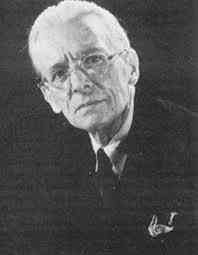 Ildebrando Pizzetti Source: Citazioni |
|
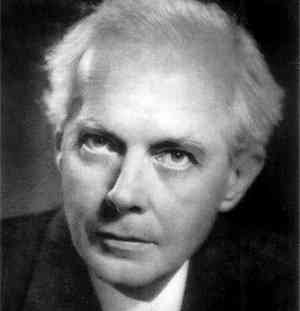 Bela Bartok Source: Pax On Both Houses |
Born on 25 March 1881 in a town in
Hungary (presently Sânnicolau Mare, Romania),
Béla Bartók
was a principal composer of works for chamber, orchestra, stage, piano and voice. He is
catalogued via BB, DD, Sz and Opus numbers. "DD" refers to Denijs Dille who
catalogued Bartok's early period from 1890 to 1904 in his 1974
'Thematisches Verzeichnis der Jugendwerke Béla Bartóks, 1890-1904'. "BB" is
the most recent and ongoing directory published by László Somfai
[1,
2] in
'Composition, Concepts and Autograph Sources' (U of California Press 1996) w
a list of 129 works
[*].
The BB incorporates and improves upon the DD. András Szollosy
[1,
2,
3] published his "Sz" index in 1956 per 'Bartók, sa vie et
son oeuvre'. There are three sets of Op numbers, all created by Bartok. His
first set covers initial works from 'Waltz' Op 1 in 1890 to 'X.Y. for Piano'
Op 31 in 1894. 'Waltz' is also his first work in all catalogues discussed
above (DD 1, BB 1, Sz 1). Bartok's second set was created from 1894 to 1898,
the Op 1 of that being 'Sonata No.1' in G minor for piano. He kept his third
set from 1904 to 1921, the Op 1 of that being 'Rhapsody for Piano'. With
three periods designated by the same opus numbers, requiring set numbers 1-3 to
distinguish them, that scheme was abandoned in the catalogues discussed
above. Bartok had learned to play forty tunes on piano by age four and began formal
training the next year. His father dying when he was seven, Bartok's mother
took him to live in present-day Ukraine, then present-day Bratislava,
Slovakia. He there gave his first public recital at age eleven of a piece he
had composed two years earlier called 'The Course of the Danube'.
Lumen
Learning has that as his first composition. Bartok studied at the Royal
Academy of Music (now the Franz Liszt Academy of Music) in Budapest from 1899
to 1903 where he favored
Richard
Strauss. Toward the end of his early
period he wrote his symphonic poem, 'Kossuth' in spring and summer of
1903 toward its first performance in Budapest on 13 Jan 1904
[1,
2;
audio of the Budapesti Szimfonikus Zenekar w Lehel György;
live performance by the Frankfurt Radio S O w Andrés Orozco-Estrada] Per above, Bartok began his
third set of opuses with 'Rhapsody' Op 1 BB 36a Sz 26 and 'Scherzo' Op 2 BB
35 Sz 28 in 1904. Those commence his mature period with order inverted in
the BB catalogue as written above [Budapest Bartók Archives].
Writing 'Rhapsody' for piano, he scored it for orchestra the next year per
BB 36b [audio of piano by Gabor Gabos or
Tibor Szász w score].
His 'Scherzo' in three movements composed for piano and orchestra didn't see
its first performance until 1961 for Magyar (Hungarian) Rádió és Televízió w Erzsébet Tusa at
piano and György Lehel conducting the Budapest Symphony Orchestra
[audio of the Introduzioni 1/3 and
Allegro 2/3;
CD] Upon graduation
from the Academy in 1903 Bartok had toured Europe until returning to
assume a teaching position in 1907. In
1908 he traveled about Hungary and Romania with
Zoltán Kodály to study and
record traditional folk songs, his musicology of such to exercise a large
influence on his own composing [1,
2,
3]. He wrote his only opera,
the expressionistic 'Bluebeard's Castle', in
1911 w libretto by Béla Balázs, revised in 1917 for its premiere the next year
on 24 May 1918 at the Royal Hungarian Opera House in Budapest
[1,
2,
3,
4,
5,
6;
audio w scores by the BBC National Orchestra of Wales w Mark Elder or
the Berlin Philharmonic w Bernard Haitink].
Bartok's 'Romanian Folk Dances' BB 68 Sz 56 for piano appeared in 1915
[1,
2;
live performance by Perry Mears].
That was orchestrated for small ensemble in 1917 per BB 76 Sz 68. Bartok had been raised
Roman Catholic, became an atheist, then a Unitarian in 1916. His
expressionist one-act pantomime ballet,
'The Miraculous Mandarin' BB 82 Sz 73, was composed between 1918 and 1924
toward its premiere on 27 Nov 1926
[1,
2,
3;
score]. Bartok
assigned that to Opus 19, its later 'Miraculous Mandarin Suite' to Op 19b, the latter
to
considerably greater favor over the stage work [1,
2,
3,
4;
audio of the Boston Symphony Orchestra w Seiji Ozawa].
Another important event in 1926 was Bartok's commencement of 'Mikrokosmos' BB 105 Sz 107,
a project that would grow to 153 progressively difficult piano pieces in six
volumes eventually published by Boosey & Hawkes in 1940
[1,
2,
3,
4,
5;
audio w scores of Vol 1
(easy) by Claude Helffer
and Vol 6
(difficult) by Maria Yudina]. Bartok also later recorded pieces from
'Mikrokosmos' [audio,
review]. In 1938 jazz clarinetist,
Benny Goodman, commissioned Bartok's 'Contrasts' for clarinet, piano and violin,
that premiered by Goodman,
Endre Petri (piano) and
Joseph Szigeti (violin)
at Carnegie Hall in NYC on 9 Jan 1939. As the Nazis rose to power in
the thirties Bartok ceased performing and publishing in Germany, eventually
immigrating to New York City in 1940 where he performed 'Contrasts' at
Carnegie Hall with Goodman and Szigeti on 20 April 1940
[1,
2,
3,
4,
5,
6,
7;
audio: 1,
2;
live performance]. They
recorded 'Contrasts' on 13 May of 1940 [audio]. Bartok became a US citizen in 1945. In
addition to touring and teaching, he continued studying Croatian and Serbian folk
songs with his wife, Ditta, on a fellowship from Columbia University NYC. He
died in NYC on 26 Sep 1945 of leukemia and was buried in Budapest. He had
been working on his 'Viola Concerto' BB 128 Sz 120 for violist, William Primrose. It was finished from sketches by associate, Tibor Serly, in 1949
[1,
2,
3;
live performance by Ladislau Cristian Andris
or
Yuri Gandelsman].
References for Bartok: 1,
2,
3.
Chronology.
Compositions:
alphabetical: 1,
2,
3;
BB directory;
BB, DD, Sz and Opus cross referencing:
English,
Portuguese,
Spanish;
BB, DD, Sz and Opus Sets 1-3;
by genre: English: 1,
2,
3,
4,
5,
6;
Francais;
chamber;
concerti;
orchestral;
piano: 1,
2;
string quartets: 1,
2.
Authorship: correspondence;
'Essays'
trans. by Benjamin Suschoff (U of Nebraska Press);
ethnomusicology.
Song texts.
Autographs & manuscripts: 1,
2.
Editions & scores: 1,
2,
3;
France;
Germany: 1,
2.
Books & documents: 1,
2,
3,
France.
Collections: Budapest Bartók Archives *,
Columbia University *,
Moldenhauer Archives at the Library of Congress *.
Sheet music.
Audio: 1,
2,
3,
4,
5,
6,
7,
8,
essential five;
MIDI files: 1,
2.
Discos: 1,
2,
3,
CDs,
LPs;
select: 'Bluebeard's Castle' by the Bournemouth Symphony Orchestra w Marin Alsop:
review;
'Violin Sonatas Nos. 1 and 2' | 'Contrasts' *.
IMDb.
Interview w David LeVita 1944.
Further reading by source: Greg Cahill,
CLASSIC fM,
Stephen Moss,
Piano Society.
Further reading by topic: analysis per Ernö Lendvai:
axis system: 1,
2,
3,
4,
5,
6;
video: 1,
2;
Fibonacci & the golden ratio (section): 1,
2,
3,
4,
5;
Fibonacci and the Golden Section;
nationalism of;
recordings;
stage works.
Bibliography:
'The Music of Béla Bartók' by Elliott Antokoletz (U of California Press 1984)
*;
'Béla Bartók: A Guide to Research' by Antokoletz & Susanni (Psychology Press 1997)
*;
'Bela Bartok' by David Cooper (Yale U Press 2015)
*;
'Bartók and His World' by Peter Laki (Princeton U Press 1995)
*;
'The new Hungarian art music ... Fibonacci ... structures' by Larry Allen Oubre
*;
'Bela Bartok: Composition, Concepts and Autograph Sources' by László Somfai (U California Press 1996)
*;
'The Béla Bartók Thematic Catalog in Progress' by László Somfai
*
(alt);
'The Life and Music of Béla Bartók' by Stevens & Gillies (Clarendon Press 1993)
*;
'Béla Bartók: A Celebration' by Benjamin Suchoff (Scarecrow Press 2004)
*,
'Béla Bartók: Life and Work' by Benjamin Suchoff (Scarecrow Press 2001)
*;
'Mikrokosmos' by Benjamin Suchoff (1959)
*;
'Bartok and the Piano: A Performer's View' by David Witten (Music Library Association 2013)
*.
Other profiles: Deutsch: 1,
2;
English: encyclopedic: 1,
2,
3,
4;
exhibition;
musical: 1,
2,
3,
4,
5;
Finnish;
Francais;
Hungarian:
exhibition;
Italian;
русском: 1,
2,
3;
Spanish.
Per below,
bagatelles are simply brief and light piano pieces. 'Bluebeard's Castle' and
'Miraculous Mandarin' are examples of Expressionist composing. Béla Bartók 1908 BB 50 SZ 38 Op 6 14 piano pieces Piano: Zoltán Kocsis 1911 Revised 1917 SZ 48 Opera BBC National Orchestra of Wales Mark Elder 1943 BB 123 SZ 116 5 movements Orchestra of the University of Music Nicolás Pasquet 1916 Op 16 Opera 1 act London Philharmonic Orchestra Vladimir Jurowski Soprano (Bianca): Heike Wessels 1945 BB 127 SZ 119 Indiana University Concert Orchestra Scott Sandmeier Piano: Clare Longendyke 1908-1909 BB 52 SZ 40 Op 7 Parker Quartet 1928 SZ 91 C major Quatuor Ebène 1905 Revised 1920? SZ 31 Op 1 Hungarian State Orchestra Janos Farencsik |
|
|
Born on 20 April 1881 in Warsaw, Poland, then part of
Russia,
Nikolai Yakovlevich Myaskovsky
(Никола́й Я́ковлевич Мяско́вский)
was a heavyweight composer of no less than 27 rather standard symphonies,
meaning Soviet sanctioned, none so favored as other of his works. Myaskovsky was the son of an Army officer and engineer. He was in his teens when taken
with his family, minus his mother who had died, to St. Petersburg. Myaskovsky learned piano and violin as a youth but joined the military. He
studied music formally a bit while in the military, then enrolled into the
St. Petersburg Conservatory in 1906. His Op 1 is assigned to
'Meditations' of 1907 consisting of settings to seven poems by Yevgeny
Baratynsky, not published until 1922. His first symphony was
'Symphony No.1' in C minor Op 3 composed in 1908, revised in 1921. Though
Alexander Glazunov
awarded him a scholarship for the work, his fellow student,
Prokofiev, didn't like it. Its first public performance didn't arrive
until 2 June 1914 in Pavlovsk [1,
2;
audio by the USSR Ministry of Culture Symphony Orchestra w Gennady Rozhdestvensky or
the State Academic Symphony Orchestra w Evgeni Svetlanov]. Graduating in 1911, he then taught at
the Conservatory while building a career as a music critic. It was already
World War I when he won the
Glinka Prize in 1916 for 'Piano Sonata No.2' Op 13 first performed by
pianist, Boris Zakharov, on 29 Dec 1916 in Petrograd
[1,
2;
audio by Konstantin Scherbakov;
live performance by Enzo (Lorenzo Medel)].
That had been written in 1912 and revised in 1948. Myaskovsky's 'Symphony No.3' Op 15 had been written just prior to the War
in spring of 1914 toward
premiere in wartime Moscow on 27 Feb 1915 w Emil Cooper conducting
[1,
2; audio of the State Academic S
O of Russia w Evgeny Svetlanov]. Fighting in the Red Army at the Austrian Front during
the War, he developed shell-shock, then worked on naval fortifications
at Talinin (Estonia) where he wrote his fourth and fifth symphonies.
Symphony No.4' Op 17 saw no performance until 8 Feb 1925 in Moscow w
conducting by Konstantin Saradzhev [IMSLP; audio of the State Academic
S O of Russia w Evgeny Svetlanov].
'Symphony No.5' in D major Op 18 premiered in Moscow earlier on 18 August
1920 w conducting by Nikolay Malko
[1,
2;
audio by BBC Philharmonic Orchestra w Sir Edward Downes or
the Moscow Radio S O w Konstantin Ivanov].
Myaskovsky's father, then a Tsarist general, had been killed by Red Army
soldiers during the winter of 1918-19. Upon release from military service in
1921 Myaskovsky became a professor at the Moscow Conservatory. Completing his
'Symphony No.6' in E flat major Op 23
in 1923, that premiered at the Bolshoy Theatre on 4 May 1924
[1,
2,
3,
4,
5;
audio of the Gothenburg S O w Neeme Järvi w score or the
Ural Philharmonic Orchestra w Dmitry Liss].
His 'Symphony No.7' in B minor Op 24 premiered in Moscow on 8 Feb 1925 w
conducting by Konstantin Saradzhev [IMSLP; audio of the Moscow Radio Symphony Orchestra w Leo Ginzburg].
'Symphony No.8' Op 26 premiered in Moscow on 23 May 1926
[1,
2,
3;
audio of the Slovak Radio S O w Robert Stankovsky].
'Symphony No.9' in E minor Op 28 premiered on 29 April 1928 in Moscow w
conducting by Konstantin Saradzhev
[1,
2;
audio of the BBC Philarmonic w Sir Edward Downes].
'Symphony No.10' in F minor Op 30 appeared in Moscow by
the conductorless orchestra, Persimfans
[1,
2,
3], on 29 April 1928
[1,
2,
3;
audio by the Slovak Philharmonic Orchestra w Michael Halasz,
the Radio Symphonieorchester Wien w Gottfried Rabl or
the Orchestra Sinfonica della Federazione Accademica Russa w Evgeny Svetlanov].
'Symphony No.12' in G minor Op 35 arrived to the Bolshoi on 6 January 1932
[IMSLP;
audio of the State Academic S O of Russia w
Evgeny Svetlanov].
'Symphony No.13' in B flat minor Op 36 premiered in January 1934
[1,
2;
audio by the State Academic S O of Russia w Evgeny Svetlanov].
Come 'Symphony No.16' ('Aviation Symphony') in F major Op 39 on 24 Oct 1936
[1,
2;
audio of the State Academic S O of Russia w Evgeny Svetlanov]. Myaskovky's 'Salutation Overture' in C major Op 48 was dedicated to Stalin on the latter's
sixtieth birthday in 1938 [audio of the Moscow New Opera Orchestra w Yevgeny Samoilov].
Myaskovsky completed his 'Symphony No.19' in E flat major Op 46 in January
of '39 toward premiere on 15 Feb that year, dedicated to the 21st anniversary
of the Red Army [1,
2;
audio of the Stockholm Concert Band w Gennady Rozhdestvensky].
With World War II arriving in July of 1939, Myaskovsky completed his 22nd
and 23rd symphonies during that period. 'Symphony No.22' in B Minor Op 54 premiered
in Tblisi on 12 Jan 1942 w Abram Stasevich conducting [1,
2;
audio of the St. Petersburg State Academic S O w Alexander Titov].
'Symphony No.23' in A minor Op 56 arrived to Moscow in July of '42
[IMSLP;
audio of the St. Petersburg State Academic S O w Alexander Titov]. Probably
more favored than any of his symphonies is Myaskovsky's 'Cello Concerto' in
C minor Op 66 written for cellist, Sviatoslav Knushevitsky, who premiered it
in Moscow on 17 March 1945 [1,
2,
3;
audio of Aleksandr Knjazev,
Mstislav Rostropovich
or
Jamie Walton
(CD);
live performance by Shang-Hua Chou].
In 1947 Myaskovsky's work was condemned alongside that of
Shostakovich,
Khachaturian and
Prokofiev for formalism.
To get branded a formalist one needed to compose via Western European rather
than Russian classical methods, experiment with decadent modernism or
express anti-proletariat sentiment (elitism).
Though Myaskovsky had earlier been a member of the Association for
Contemporary Music abolished in 1932 [*], it was elitism for which he drew
fire, that is, not maintaining sufficient simplicity. Myaskovsky had managed to squeeze
into the box of Soviet guidelines since the formal founding of the Soviet
Union in 1922. It was inevitable, however, that he should eventually step
beyond the acceptable standard, as Myaskovsky was no mean composer, pacing
himself to self-compromise to have a career without leaving Russia. Though
he yet spent his last years in refusal to make an appearance of compliance
to the Composer's Union, his last symphony sufficiently conformed to Russian
romantic tradition to win a fifth Stalin Prize awarded posthumously in 1951.
'Symphony No.27' in C minor Op 85 also premiered posthumously in Moscow on 9
Dec 1950, four months after Myaskovky's death on 8 August 1950
[1,
2;
audio of the Russian State S O w Valeri Polyansky;
CD: 1,
2]. His last
Opus was assigned to 'From Many Years'
Op 87, a group of fifteen romances written between 1901 and 1936. Myaskovsky
had left a legacy of influence on an
impressive array of students. Among his chamber works are thirteen string
quartets. Instrumental works include nine piano sonatas. He had also composed
choral music.
References: 1,
2,
3.
Chronology.
Compositions:
alphabetical: 1,
2,
3,
4;
chronological (Spanish);
by genre: 1,
2,
3,
4;
by Opus: 1,
2,
Japanese;
by Opus w WoO;
symphonies: Dutch;
English: 1,
2;
Japanese.
Editions & scores: Czech Republic,
France,
Germany.
Books & documents: 1,
2,
3.
Audio: 1,
2,
3,
4.
Recordings of: discos: 1,
2,
by Opus;
select: 'Symphonies No. 1 & 19' on Russian Disc 1993.
Honors.
Iconography.
Further reading: analysis by Eric Schissel;
extensive на русском;
regimentation of Soviet composition by Patrick Zuk.
Biblio: 'Nikolay Myaskovsky: The Conscience of Russian Music' by Gregor Tassie (Rowman & Littlefield 2014).
Other profiles: Arabic;
Catalan;
Czech;
Deutsch;
Dutch;
English: 1,
2,
BBC radio profile by Donald Macleod;
Georgian;
Italian;
Japanese;
Spanish.
Nikolai Myaskovsky 1911 Revised 1935 Op 12 Cello: Jan-Erik Gustafsson Piano: Graham Jackson 1948 Op 81 Cello: Natalia Gutman Piano: Viacheslav Poprugin 1950 Op 86 Borodin Quartet 1908 Revised 1921 Op 3 State SO of the Ministry of Culture Gennady Rozhdestvensky 1921-1923 Op 23 London Philharmonic Choir Vladimir Jurowski 1927 Op 30 Boston Symphony Orchestra Oliver Knussen 1941 Op 54 'Symphony-Ballad' St. Petersburg State Academic SO Alexander Titov |
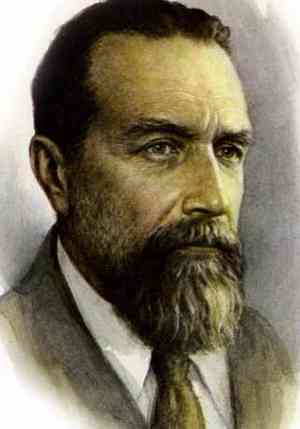 Nikolai Myaskpvsky Source: Belcanto |
|
| Born on 19 August 1881 in Liveni, Romania,
George Enescu composed mostly chamber and orchestral works
strong in violin,
also leaving behind numerous lieder and works for piano.
He was composing at age five, 'Pămînt Românesc' ('Romanian Land')
for piano and violin
among his early pieces. 'Waltz' appeared the next year (1887). He
entered the Vienna Conservatory at age seven in 1888. Students generally required to be at least
fourteen years of age, he was the youngest student to ever attend there. He performed at the Court of Vienna for Emperor
Franz Joseph in 1891. Graduating from the Vienna Conservatory at age twelve
in '95, Enescu then studied at the Paris
Conservatoire from 1895 to '99. His Opus 1 was the symphonic suite, 'Poème Roumaine'
composed in 1897, premiering the next year on 6 February and published in '99 [1,
2;
interpretion by the Romanian Broadcasting Orchestra w Iosef Conta w score
or the Orchestra Philharmonique de Monte-Carlo w
Lawrence Foster;
score].
His Opus 2, 'Violin Sonata No.1' in D major, was also composed in 1897,
published in Paris in '98
[IMSLP;
audio].
Completing 'Violin Sonata No. 2' Op 6 in 1899, that was first performed on
22 February 1900 in Paris by Enescu at piano w Jacques Thibaud on violin
[1,
2;
audio of Valentin Gheorghiu (piano) w Sherban Lupu (violin)
* or
Justin Oprean (piano) w Adelina Oprean (violin)
*;
live performance
by Simona Strungaru (piano) w Fedor Rudin (violin);
score].
'Octet' for strings' in C major Op 7 arrived in 1900 after working on it for a year
and a half, though wasn't performed until 18 Dec 1909 in Paris
[1,
2;
audio w score;
live performance].
Enescu's
Opus 11 consisted of two Romanian rhapsodies completed in 1901,
published in 1909: 'Romanian Rhapsody No.1' in A major
[1,
2,
3,
4;
interpretation by the Romanian Broadcasting Orchestra w Iosef Conta or
the London S O w Antal Dorati]; 'Romanian
Rhapsody No.2' in D major [*;
interpretation by the Romanian National Radio Orchestra w Horia Andreescu or
the Romanian Broadcasting Orchestra w Iosef Conta].
Enescu's first of five symphonies was 'Symphony No.1' in E flat major Op 13,
premiering at the Théâtre du Châtelet in Paris on 21 Jan 1906
[1,
2,
3;
interpretation by the Romanian National Radio Orchestra w Horia Andreescu of the
Hague Philharmonic w Christian Badea;
live performance by the NHK Symphony Orchestra w
Lawrence Foster].
Enescu spent World War I in Romania where activities included performances
for hospitalized War veterans and the composing of 'Symphony No.3' in C
major Op 21 from 1916 to 1918 toward its premiere on 25 May 1919. Enescu soon
revised that in 1921, again thirty years later in 1951
[1,
2,
3;
interpretation by the Romanian National Radio C & O w Horia Andreescu,
the Orchestre National de Lyon w
Lawrence Foster
or
the Tampereen Kuoro & Filharmoninen w Hannu Lintu].
Enescu's first trip to America was to
conduct the Philadelphia Orchestra at Carnegie Hall in New York City on 8
January 1923. He would make future trips to America to conduct and
record. Sessions for what may be his earliest recordings for Columbia were
held w pianist, Edward C. Harris, on 13 and 14 February 1924. They recorded
Alfredo D'Ambrosio's 'Serenade' Op 4 on the 13th and
Fritz Kreisler's 'Aubade
Provencale' on the 14th toward
issue that year on Columbia 20023-D
[1,
2,
3].
Titles with pianist, Sanford Schlüssel, went down in 1929.
Later in the thirties Enescu recorded concerti by
JS Bach
with his student,
violinist, Yehudi Menuhin [1,
2,
3], for
the Victor label
[1,
2]. Recording numerously into the
fifties, Enescu is also found on the HMV, Remington, Continental and
Electrecord labels [see also
*]. Enescu had begun 'Piano Sonata No.1 Op 24
No.1' in 1912, setting it aside for twelve years to be completed in 1924
toward its first performance at the Mic Theatre in Bucharest on 21 Nov 1925
[1,
2;
piano by Cristian Petrescu;
score].
Come 'Violin Sonata No.3' in A minor Op 25 in 1926 toward premiere in Oradea in Jan 1927
by Enescu at violin and Nicolae Caravia at piano
[1,
2;
interpretation by Mihaela Ursuleasa (piano) w Patricia Kopatchinskaja (violin);
live performance by Artur Avanesov (piano) and Movses Pogossian
(violin). Enescu later recorded 'Violin Sonata No.3' Op 25 w pianist, Dinu Lipatti, in 1943 per
olla-vogala (+ audio).
That corresponds to what Rudolf Bruil at Remington Records has issued on LP in Romania on an
unidentified date per Electrecord FCD-95.
Enescu's solitary opera, 'Œdipe', premiered in Paris on 13 March 1936 w
libretto by Edmond Fleg [1,
2,
3,
4,
5,
6,
7,
8,
9,
10,
11;
interpretation by the Wiener Sängerknaben w the C & O der Wiener Staatsoper directed by
Michael Gielen]. During
World War II he worked in Paris and Bucharest, remaining in Paris upon
Soviet occupation of Romania in 1944. Come his 'Chamber Symphony' for 12
instruments in E major Op 33 completed in May of '54 toward premiere on 23
Jan 1955 [1,
2,
3,
4;
State University of Music Freiburg directed by James Avery w Tibor Szász at piano].
Enescu died on 4 May 1955 in Paris, leaving 'Symphony No.5' unfinished, not
to see completion until 1995 by Pascal Bentoiu
[*;
interpretation by the Banatul Philharmonic Orchestra w the Choir of the Arad Philharmonic directed by Peter Ruzicka:
Part 1,
Part 2;
see also
1,
2].
References for Enescu:
1,
2,
3,
4.
Compositions: alphabetical:
1,
2;
chronological;
by genre:
1,
2,
3,
4;
by Opus w WoO;
Romanian Rhapsodies.
Editions & scores:
Canada,
France,
Germany.
Books & documents:
1,
2,
France.
Sheet music.
Audio:
1,
2,
3,
4,
5,
6,
7,
8,
9.
Recordings of: discos
1,
2,
3,
by
Opus;
select: 'The Columbia Recordings' (1929)
*;
'Enescu' by the Romanian Radio & Television Orchestra w Iosif Conta,
review;
'Enescu: Luiza Borac': Vol 1,
Vol 2;
'Enescu: Symphony No. 3' by the Cluj-Napoca Philharmonic Orchestra w Ion Baciu,
review;
'Violin Sonatas' by Adelina and Justin Oprean.
IMDb.
Further reading by source:
Martin Anderson;
Leon Botstein;
Cheniston Roland;
Dominic Saunders;
interview w pianist,
Eduard Stan.
Further reading by topic: Enescu and Céliny Chailley-Richez;
Evan Dickerson on Enescu as a
composer and
performer.
See also: the George Enescu
Foundation;
iconography;
the George Enescu
International Competition;
the George Enescu Philharmonic Orchestra:
1,
2;
the International Enescu
Society.
Bibliography:
'Masterworks of George Enescu: A Detailed Analysis' by Pascal Bentoiu (Scarecrow Press 2010);
'Oedipe' by
Bruce Burroughs ('The Opera Quarterly' 1993);
'Revisiting George Enescu’s 1921 Bucharest Recital Series' by
Elizabeth Layton;
'George Enescu: His Life and Music' by Noel Malcolm (Toccata Press 1990):
1,
2,
3.
Other profiles:
Catalan;
Deutsch:
1,
2,
3;
English: encyclopedic:
1,
2;
musical:
1,
2,
3,
4,
5;
travel;
Espanol;
Francais;
Italian;
Japanese;
Portuguese;
Romanian.
Per below, Enescu plays violin on recordings of 'Albumblatt'
and 'Partita 2'. His two Romanian rhapsodies are listed under
Eugene Ormandy. George Enescu Composer: Wagner 1875 Recorded 1924 Violin: George Enescu 1931 Op 23 Tragic opera 4 acts Chor und Orchester der Wiener Staatsoper Dirigent: Michael Gielen Study Symphony 4 in E flat major 1898 WoO 3 movementsRomanian National Radio Orchestra Horia Andreescu 1900 Op 7 Violin: Ernst Kovacic et al Composer: Bach 1720 BWV 1004 Recorded: 1948-49 Violin: George Enescu 1897 Op 1 Symphonic suite Romanian Radio and Television C & O Iosif Conta 1912-14 Op 17 3 movements Romanian National Radio Orchestra Tiberia Soare 1916–1918 Op 21 Mariinsky Orchestra and Choir Valery Gergiev 1926 Op 25 Piano: Mihaela Ursuleasa Violin: Patricia Kopatchinskaja 1954 Symphonic Poem 3 parts Philharmonic Orchestra & Chorus Conductor: Gennady Rozhdestvensky |
 George Enescu Source: C Muse |
|
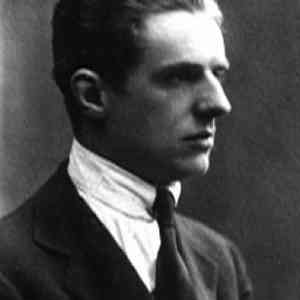 Gian Malipiero Source: NMC Recordings |
Born on 18 March 1882 in Venice,
Gian Francesco Malipiero
composed works for chamber, orchestra, opera, piano and voice. Among
particular interests are his symphonies composed to free them from standard
German forms to approach them in a distinctly Italian manner. The Republic
of Venice had been annexed by Austria in 1815 after the Napoleonic wars and
became part of Italy in 1866 as of the Third Italian War of Independence
from Austria. As for Malipiero, he began studies at the Liceo Musicale, now
the Conservatorio Benedetto Marcello di Venezia, in 1899. His oldest extant
composition is 'Dai Sepolcri' ('From the Sepulchers') of 1904, that the year
he left Venice to study with various in Bologna, returning to Venice in 1906
to graduate from the above Conservatory and go to work as assistant to blind
composer, Antonio Smareglia. He also studied with
Max Bruch
in Berlin on separate visits from 1906 to 1909. It was 1913 that he went to Paris. He there met
with major modernist composers such that he decided everything he'd written
up to that time was worthless with the exception of 'Impressioni dal Vero'
of 1910-11 [interpretation by the Orchestra Sinfonica di Roma diretta da Francesco La Vecchia:
1/3,
2/3,
3/3].
Gian fled Venice for Rome in 1917 upon the Austro-Hungarian
invasion of Caporetto. His symphonic 'Pause del Silenzio' I of II premiered in
Rome on 27 Jan 1918
[*;
interpretation by the American Symphony Orchestra w Leon Botstein;
score].
In 1921 he became a teacher of composition at the
Parma Conservatory. In 1923 he made Asolo his permanent residence. In 1926
he commenced the long project of a complete edition of arrangements of
Renaissance musician,
Claudio Monteverdi, on
which he worked until to 1942. 'Pause del Silenzio' II premiered in
Philadelphia on 1 April 1927
[*;
interpretation by the Orchestra Sinfonica di Roma w Francesco La Vecchia;
score].
Malipierio became
a professor at the Liceo Musicale in 1932, it's Director in 1939. In the
meantime he wrote the film score to 'Steel' premiering on 31 March 1933.
That consisted of 'Seven Inventions' and 'Four Inventions'
[Arthur Baker
(alt)].
'Sinfonia No.1' arrived in 1933 as well
[interptation by the Orchestra Sinfonica di Mosca diretta da Antonio de Almeida].
Malipiero dedicated his opera, 'Giulio Cesare' ('Julius Caeasar') of 1936, to Benito Mussolini,
that with a libretto by himself largely borrowing from Shakespeare's
eponymous tragedy of 1599
[interpretation by the Coro e Orchestra Sinfonica di Milano della Rai diretta da Nino Sanzogno:
1/3,
2/3,
3/3].
Sometime after 1952 he began another long project of arrangements, now of
concerti by Vivaldi [*], upon access to the Istituto Italiano Antonio Vivaldi
in Venice [1,
2].
Malipeiro's last of eleven symphonies was 'Sinfonia No.11' ('Delle Cornamuse'
or 'Of the Bagpipe') as of 1969 [*;
interpretation by the Orchestra Sinfonica di Mosca diretta da Antonio de Almeida].
His final of numerous operas since the premiere of 'L'Orfeide' on 5 Nov 1925
at the Stadttheater in Düsseldorf was 'L'iscariota', arriving in 1971.
Maliperio died on 1 August
1973 in Treviso near Venice. References: 1,
2,
3.
Compositions: alphabetical: 1,
2,
3;
chronological;
by genre: Catalan;
Deutsch;
English: 1,
2,
3;
Italian.
Editions & scores: 1,
2;
Canada; France:
1,
2.
Books & documents international: 1,
2.
Audio: 1,
2,
3,
4,
5.
Recordings of: discos: 1,
2,
3;
select: 'Impressioni dal vero' | 'Pause del silenzio' by the Rome Symphony Orchestra w
Francesco La Vecchia,
review;
'Malipiero' (containing Inventions);
symphonies interpreted by the Moscow Symphony Orchestra w Antonio De Almeida:
Nos. 1 & 2;
Nos. 3 & 4;
Nos. 9 & 10.
Biblio: 'Gian Francesco Malipiero (1882-1973): The Life, Times and Music of a Wayward Genius' by
John Waterhouse (Routledge 2013).
Other profiles: Catalan;
English:
1,
2,
3;
Italian:
Treccani: 1,
2,
3.
Gian Francesco Malipiero 1966 Freon Ensemble Stefano Cardi 1953 Orchestra Sinfonica di Roma Francesco La Vecchia Impressioni dal vero (Prima parte) 1910Orchestra Sinfonica di Roma Francesco La Vecchia Impressioni dal vero (Seconda parte) 1915Orchestra Sinfonica di Roma Francesco La Vecchia 1935 Mystery play C & OS di Milano della RAI Nino Sanzogno 1933 7 pieces for orchestra Orchestra Filarmonica del Veneto Peter Maag Sinfonia del silenzio e de la morte 1908Orchestra Sinfonica di Mosca Antonio de Almeida 1933 Orchestra Sinfonica di Mosca Antonio de Almeida 1936 Orchestra Sinfonica di Mosca Antonio de Almeida 1947 Orchestra Filarmonica Italiana Dario Bisso Sabàdin 1948 Orchestra Sinfonica di Mosca Antonio de Almeida 1969 Moscow Symphony Orchestra Antonio de Almeida 1929 Opera C & O del Teatro dell'Opera di Roma Ettore Gracis |
|
|
An Irish Pole born in London on 18 April 1882,
Leopold Stokowski
wasn't a composer, though he arranged numerous transcriptions of such as
JS Bach
and
Modest Mussorgsky. Among the stronger conductors of the early
modern period, via recording as well as Walt Disney Studios
[1,
2,
3,
4] he brought
classical music to everyman. He entered the Royal College of Music in 1896.
In 1900 he became choirmaster and organist at St Mary's Church, at St. Jame's in 1902. 1905 found him in the same capacities in New York City at
St. Bartholomew's. Stokowski studied conducting in Paris before his
conducting debut in May of 1909 with the Colonne Orchestra, the same
year he became
conductor of the Cincinnati Symphony Orchestra founded in 1872
[1,
2]. His debut as
conductor of the Philadelphia Orchestra [1,
2,
3] was on 11 October of 1912
[1,
2], that
organization founded in 1900 by Fritz Scheel.
Stokowski invested a major portion of his career into recording as a
conductor, his initial
acoustical tracks gone down for Victor on 22 Oct 1917 with the Philadelphia
Orchestra consisting of 93 musicians [1,
2].
One of those was Brahms' 'Hungarian Dance No.5' [audio: 1,
2]. Though he put away 450 recordings, only some 60 saw issue, acoustic
recording being what it was. Fidelity improved considerably in the twenties
with the development of electrical technology. Stokowski's electric debut was
held on 29 April 1925, recording a rendition of Camille Saint-Saëns' 'Danse
Macabre' [audio: 1,
2,
3].
Another of the more amazing websites in musical lore is
Stokowski which
chronicles Stokowski's recordings from 1917-24,
1925-40,
1941-59 and
1960-77
along with recordings made w the Philadelphia Orchestra. Stokowski
ceased conducting with a baton in 1929. He appeared in film in 1937 in
'The Big Broadcast of 1937' [1,
2]. 1940
saw the release of the animation extravaganza, 'Fantasia', by Walt Disney
Studios, for which he was musical director [1,
2,
3,
4;
audio].
Stokowski separated from the Philadelphia Orchestra in 1941 to conduct
the NBC Symphony Orchestra [founded 1937] for the next three years.
It was 1945 that he founded the Hollywood Bowl Symphony Orchestra
[1,
2].
The Leopold Stokowski Symphony Orchestra was created in 1947
to the only purpose of recording with RCA Victor until 1953. Stokowski
returned to the Philadelphia Orchestra as guest
conductor from 1960 to 1969, in the meantime founding the American Symphony
Orchestra in New York in 1962 [1,
2,
3,
4].
The Stokowski website has him conducting in public for the last time on 14
May 1974 at Royal Albert Hall [1,
2] in London w the New Philharmonia Orchestra
[1,
2] for
BBC, performing titles by
Klemperer,
RV
Williams,
Ravel
and
Brahms. He made his last
recordings in London with the now defunct National Philharmonic on 31 May 1977 followed
on 2 and 4 of June 1977, recording
Bizet's 'Symphony in C
Major' of 1855 [audio] and
Mendelssohn's 1833 Italian
'Symphony No.4'. Stowkowski died only three months later on 13 Sep 1977 of heart attack in Nether Wallop,
Hampshire [obit].
Conducting everything from baroque to modern, Stokowski is also
largely responsible for the seating plan that most orchestras use,
experimenting with such until he got the best sound. Though criticized for
his liberal interpretations, his conducting has otherwise become a standard
to achieve. References: 1,
2.
Adaptations & transcriptions: 1,
2,
3,
alphabetical;
JS Bach: 1,
2;
Wagner's 'Tristan and Isolde'.
Books & documents: 1,
2,
France,
Germany.
Collections: U of Maryland;
U of Pennsylvania.
Audio: 1,
2.
Discographies: 1,
2,
3,
4,
5,
6,
7,
Germany;
select: 'Mussorgsky | Stowkowski' (transcriptions) *.
Film: 1,
2.
Iconography.
Further reading by source: Simon Callow;
Colin Eatock; Edward Johnson on Stokowski and
British music,
correspondence,
Ralph Vaughan Williams.
Further reading by topic: concert itinerary:
1909-20,
1921-32,
1933-49,
1950-74;
family;
Greta Garbo and;
interviews;
development of recording: acoustic;
electrical.
Bibliographies: 1,
2.
Other prodiles: Dutch;
English: encyclopedic: 1,
2,
3;
musical: 1,
2,
3,
4;
periodical *;
Finnish;
French;
German: 1,
2;
Italian;
русском: 1,
2,
3.
Spanish.
Per below, 'The Sorcerer's Apprentice' is one of the tracks in the
Disney film, 'Fantasia'. Other tracks from that film under
JS Bach,
Tchaikovsky,
Stravinsky,
Beethoven,
Ponchielli and
Mussorgsky.
Leopold Stokowski 'The Love Witch' Composer: Manuel de Falla 1914-15 Revised 1916-20 Leningrad Symphonic Orchestra Leopold Stokowski Recorded 1958 Composer: Claude Debussy 1890 Philadelphia Orchestra Leopold Stokowski Recorded April 1937 Composer: Vaughan Willams premiere: 1939 Carnegie Hall Conductor: Stokowski Recorded 1954 Composer: Paul Dukas 1896–97 Symphonic poem Philadelphia Orchestra Leopold Stokowski Film: 'Fantasia' 1940 Composer: Shostakovich 1937 4 movements London Symphony Orchestra Leopold Stokowski Recorded 1964 |
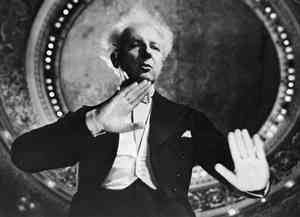 Leopold Stokowski Source: Parterre |
|
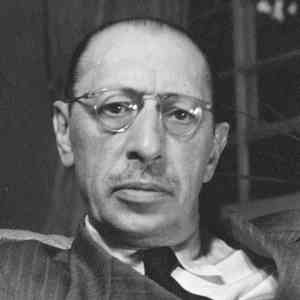 Igor Stravinsky Source: Carnegie Hall |
Born on 17 June 1882 in Saint Petersburg,
Igor Stravinsky
played piano and composed as a young boy early on his way to becoming one of
Russia's most important composers. His career can be divided into three
periods identified as Russian (c 1907–1919) [1,
2,
3], Neoclassical (c 1920–1954)
[1,
2,
3] and Dodecaphonic (1954–1968)
[1,
2,
3]. The Stravinsky Fondation demarcates his
career by national residences being Russia (1902-1914),
Switzerland
(1914-1920), France (1920-1939) and the
U.S. (1939-1971). Stravinsky's father sang bass for the
Imperial Opera of St. Petersburg and his mother played played piano. He
developed an interest in ballet at about age eight followed by piano
lessons. By age fifteen he could play
Mendelssohn's
'Piano Concerto No.1' and had reduced a string quartet by
Glazunov
into a
piece for solo piano. The latter was apparently little impressed by
Stravinsky at the time, thinking him musically common. Stravinsky's
catalogue begins with 'Tarantella' for piano of 1898 as W 1 or CC 1
[audio fragment]. "CC"
numbering is per the 1982 chronological catalogue by Clifford Cæsar.
Igor entered the University of St. Petersburg in 1901 to study law,
but meeting
Nikolai Rimsky-Korsakov the next year resulted in even less interest in a
legal profession than he had had before. He studied beneath
Rimsky-Korsakov from
1905 until the latter's death in 1908, during which period Stravinsky's
oldest son was born in March of 1907, the artist, Theodore Stravinsky
[1,
2,
3]. The "HH"
numbering system in Stravinsky is per Harry Halbreich in 1968 of which HH 1 is also
Stravinsky's Opus 1 assigned to 'Symphony in E-flat' CC 8 W 9, his initial
work for orchestra first performed on 27 April 1907 by the St. Petersburg
Court Orchestra conducted by H. Wahrlich [1,
2,
3;
interpretation by the Russian National Orchestra w Mikhail Pletnev w score]. That
date also included the first
performance of Stravinsky's earlier suite of 1906, 'Faun and Shepherdess' CC 9 W 8 HH 2
Op 2 [1,
2;
sung by Lucy Shelton w the Cleveland Orchestra conducted by Oliver Knussen]. Stravinsky's career began taking
off in a large way in 1909 as of the premiere of his fantasy, 'Fireworks' in
E major Op 4, on 6 February [1,
2,
3,
4,
5,
6;
audio of Stravinsky conducting the Columbia
Orchestra (1961);
live performance by
the Russian National Orchestra w Carlo Ponri]. Though that was only three to four minutes
long, but it gained a commission from Sergei Diaghilev to write the ballet, 'The Firebird', in 1910
toward premiere on 25 June at the Paris Opera. 'The Firebird' also brought
about three Suites for orchestra composed in 1911, 1919 and 1945
[1,
2,
3;
live performance by the New England Conservatory Philharmonia w Hugh Wolff;
'Firebird Suite' of 1945: live performance
by Stravinsky conducting the
NHK Symphony Orchestra in Japan in 1959. Come the premiere of Stravinsky's
ballet, 'Petrushka', at the Théâtre du Châtelet in Paris on 13
June 1911 w libretto by himself and Alexandre Benois [1,
2,
3,
4,
5;
score].
"Petrushka" doesn't translate to "parsley" in the context that Stravinsky
used it, as it's actually a diminutive of "Pyotr" (Peter) in reference to a stock
character in Russian folk puppetry corresponding to Punch in England and
Pulcinella in Naples.
Stravinsky's ballet, 'The Rite of Spring', arrived to the Théâtre des
Champs-Élysées in Paris on 29 May 1913 to cause a theatre riot as a work too
modernistic for its audience which threw vegetables at its dodging
performers. 'The Rite of Spring' is sectioned into Part 1 Nos. 1-8 and Part
2 Nos. 9-14 respectively titled 'L'Adoration de la Terre' and 'Le
Sacrifice' [1,
2,
3,
4,
5,
6,
7;
audio w score of the New York Philharmonic Orchestra w Leonard Bernstein (1958);
live performance by Het Radio Filharmonisch Orkest w Jaap van Zweden;
Part 1 No.2
by the Berliner Philharmoniker w Sir Simon Rattle]. It was 26 May of 1914
when Stravinsky premiered his opera, 'Le Rossignol' ('The Nightingale') at
the Palais Garnier in Paris [1,
2,
3,
4,
5,
6;
live performance
by the Opéra National de Paris w James Conlon and soprano, Natalie Dessay].
He would revise that later in 1962. The outbreak of World War I
prompted a move to neutral Switzerland in 1914, not to return to Russia for
another 48 years. In late 1915 the Aeolian pianola (piano player) company
requested an arrangement of 'Rite of Spring' for piano roll, Stravinsky
responding with two, though only one saw perforation much later in 1921.
Aeolian commissioned 'Étude pour Pianola' from Stravinsky in 1917, though it
didn't see a roll (not made by Stravinsky) until 1921. The War had run its course when Stravinsky premiered his
symphonic poem, 'Le Chant du Rossignol', in Geneva on 6 Dec 1919
[1,
2;
interpretation by
the Seattle Symphony Orchestra w Gerard Schwarz (1986)]. Stravinsky began
arranging scores for the Playela pianola company in 1921, again punched by
unidentified keyboardists. By 1924 his income was sweet enough to
purchase a home in Nice. In January of 1925 he toured to the United States
where he recorded piano rolls for Aeolian's Duo-Art. Stravinsky and his wife became French citizens in
1934. 'An Autobiography' was published by Simon and Schuster
in 1936. Following his wife's death in 1939
Stravinsky lectured for a year at Harvard
University in Cambridge, Massachusetts, marrying again the next year. They
soon after moved to Beverly Hills, then made West Hollywood their home.
Stravinsky's first of four versions of 'The Star-Spangled Banner' arrived in
January 1944, whence a dubitable chord roused authorities to caution
Stravinsky that rearrangements
of the national anthem could be subject to a fine of $100. The law at that
time more correctly forbade the use of the national anthem in dance music,
as an exit march or as part of a medley. Be as may, he wasn't arrested as
urban legend came to claim. 'Three Songs from William Shakespeare'
[*] arrived
in 1953 consisting of 'Musick to heare' [*], 'Full fadom five' and 'When
Daisies pied' [interpretation by Anna Molnár:
live,
w score;
by
Ann Murray]. Upon the death of
Arnold Schoenberg,
devisor of twelve-tone composing, in July of 1951, Stravinsky began to
employ
Schoenberg's
method in his own compositions [see also serialism]. His first entirely dodecaphonic work was 'In
Memoriam Dylan Thomas' in 1954 [1,
2;
audio w conducting by Pierre Boulez;
live w conducting by Dominick DiOrio or
William Kraft].
Stravinsky was recipient of
the Sonning Award by Denmark in 1961, the year before finally returning to
Russia to deliver concerts in Leningrad and Moscow [*].
In 1966 he wrote and premiered his fifteen-minute 'Requiem Canticles' CC 131
W 108 HH 100
[1,
2,
3;
interpretation w score and conducting by Robert Craft or
Oliver Knussen].
His 'The Owl and the Pussy Cat' CC 132 W 109 HH 99 followed the same year
[*;
interpretation by Ildikó Iván (soprano) w István Szakács (piano)
* or
Eva Šušková (soprano) w Ivan Koska (piano)
*].
Stravinsky and wife moved to the Marriott
Essex House in Manhattan in 1969, joined by musical assistant, Robert Craft.
Following recovery from a fight w pneumonia Stravinsky died on 6 April 1971 of heart failure.
He'd written well above 100 works for chamber, chorus, orchestra, stage, piano
and voice. References: 1,
2,
3.
Compositions: Deutsch,
Francais;
alphabetical: 1,
2,
3,
4;
CC HH W & Opus cross reference;
chronological: 1,
2,
3;
Francais: 1,
2;
русском;
by genre: 1,
2,
3,
4,
5,
Deutsch;
Francais: 1,
2,
русском;
ballets;
essential;
operas;
religious.
Editions & scores: 1,
2.
Books & documents: 1,
2,
3,
4.
Song texts: 1,
2.
Sheet music: English,
русском.
Audio: 1,
2,
3,
4,
5,
6,
7.
Discographies: 1,
2,
3,
4,
5,
6.
IMDb.
Further reading by source: Jacques Amblard;
Valery Vasilyevich Smirnov;
Richard Taruskin.
Further reading by topic: account book 1898-03; analysis:
serial compositions (Hughes);
topology (Kuster);
family;
numerology and;
pianola and: McFarland;
Pianola.
See also: performances of Stravinsky on Broadway;
iconography;
interviews: 1957,
c 1960-65.
Bibliography: 1,
2;
'After the Rite' by Maureen Carr (Oxford U Press 2014)
*;
'Structure and Numerology in Stravinsky's In Memoriam Dylan Thomas' by Gauldin & Benson ('Perspectives of New Music' 1985)
*;
'Igor Stravinsky' PediaPress
*;
'Stravinsky's Four Star-Spangled Banners' by H. Colin Slim ('The Musical Quarterly' 2006)
*;
'Stravinsky' by Stephen Walsh
*.
Other profiles: Deutsch;
English: didactic: 1,
2;
encyclopedic: 1,
2,
3,
4,
5,
6;
historical: 1,
2;
musical: 1,
2;
Francais: 1,
2;
Italian;
русском: 1,
2,
3,
4,
5.
Per below, Stravinsky conducts his suite, 'The Firebird'.
He also features on piano rolls of 'Piano Sonata'. His 'Rite of Spring'
below is another version than was featured in the 1940 animation extravaganza, 'Fantasia'. He dabbles in
expressionism with 'Three Japanese Lyrics'. Igor Stravinsky 1910 Ballet 2 tableau Conductor: Igor Stravinsky 1914–17 1919–23 premiere 1923 Ballet Pokrovsky Ensemble Dimitri Pokrovsky 1911 Ballet 4 parts OS de Radiotelevisión Española Sergiu Comissiona 1924 Recorded 1925 3 movements Piano rolls Piano: Igor Stravinsky 1920 Ballet Boulder Chamber 1913 Ballet Radio Filharmonisch Orkest Jaap van Zweden 1913 3 songs Ensemble Intercontemporain Conducting: Robert Craft Sopran: Phyllis Bryn-Julson 1931 4 movements BBC Symphnoy Orchestra David Robertson Violin: Gil Shaham |
|
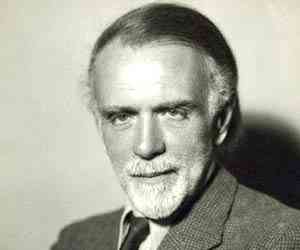 Zoltan Kodaly Source: Famous People |
Born on 16 Dec 1882 in Kecskemét, Hungary,
Zoltán Kodály
was a violinist and pedagogue who wrote larggely chamber, orchestral and
choral works. His father was a railroad station master who
moved his family to Szob in '83, Galánta in '85 and Nagyszombat, now Trnava,
in 1892, the year Kodaly endeavored his first composition, an unidentified
overture. He began formal studies in music in 1900 at the Franz Liszt
Academy of Music in Budapest [*],
also studying at Eötvös College and the
Péter Pázmány University. What is the "K" directory begins with Kodaly's 'Mennuetto'
K 1 in 1897. K numbering is from 'Zoltán Kodály: A Guide to Research' by
Mícheál Houlahan and Philip Tacka (Garland 1998). In 1905 he began traveling about Hungary w
Béla Bartók
to make gramophone recordings of Magyar folk songs sung by local peasants. That
resulted in his 1906 doctoral thesis, 'The Strophic Structure of Hungarian
Folk-Songs' and the publishing w Bartók of 'Twenty Hungarian Folks Songs'
[*].
It was also 1906 when Kodaly premiered his first major work, the symphonic
poem, 'Nyári Este' ('Summer Evening'), on 22 Oct
[1,
2;
audio of Miskolc S O w László Kovács or
the Orpheus Chamber Orchestra w Josef Suk;
live performance: Nino Wrede Master Class;
score].
Studies in Berlin and Paris resulted in his appointment in autumn of 1907 as
a professor of theory and composition at the Liszt Academy. Kodaly's Opus 1
is assigned to 'Énekszó' ('Of Word'), a collection of sixteen Hungarian folk
songs interpreted from 1907 to 1909 though not published until 1921
[1,
2,
scores].
His Op 2 was 'String Quartet No.1' in C minor first performed in Budapest on
17 March 1910 by the Waldbauer-Kerpely String Quartet
[1,
2,
3,
4;
audio by the Chicago Symphony String Quartet *
or the Kodaly Quartet *]. World War I was brewing and just ahead when in 1914 he composed 'Duo for
Violin and Cello' in C minor Op 7, the War yet in contest when it premiered
in Budapest on 7 May 1918 [1,
2,
3,
4;
audio of Janos Starker (cello) w Josef Gingold (violin),
w score;
audio of the U.S. Army Strings;
live performance by Pablo Ferrández (cello) w Stephen Waarts (violin);
live performance by Stéphane Tétreault (cello) w Robert Margaryan (violin)].
The same day (7 May) saw the premiere of 'String Quartet No.2' Op 10
[1,
2,
3;
audio of the Kodaly Quartet w
score].
Come the first performance of 'Psalmus Hungaricus' Op 13 for chorus and
orchestra on 19 Nov 1923 [*;
audio of the Brighton Festival Chorus & London S O w István Kertész;
live performance by the Saint Peter's C & O w Bálint Karosi].
Among Kodaly's most favored works is 'Dances of Galánta' based on folk music
from what is now Slovakia. Commissioned for the 80th anniversary of the
Budapest Philharmonic Society [1,
2], it premiered in Budapest on 23 Oct 1933 w Ernő Dohnányi conducting [1,
2,
3,
4,
5,
6; live performances by
the Berlin P O w Daniel Barenboim
or the
London P O w Vladimir Jurowski;
scores].
In 1935 Kodaly and colleague, Jeno Ádám,
began the long project of creating a new curriculum for teaching music in
lower and middle schools along w what would become known as the Kodaly
Method [1,
2,
3,
4,
5,
6].
Per All Music, though Kodaly began to compose 'Variations on a Hungarian
Folksong' ('Peacock Variations') in 1937 they didn't see performance until
Wartime Amsterdam on 23 Nov 1939, Nazi forces to invade Netherlands six
months later in May [1,
2,
3;
audio of the London P O w Georg Solti
(1954)]. Kodaly's Hungary wouldn't see occupation until March of 1944. In
the meantime he wrote 'Concert for Orchestra' for the Chicago Symphony
Orchestra which performed its premiere in the United States on 6 Feb 1941 w
conducting by Frederick Stock [1,
2,
audio by the Miskolc S O w Laszlo Kovacs].
Kodaly wrote his 'Organ Mass' in 1942, revising it for organ, voice and
choir in 1944 as the liturgical 'Missa Brevis' [1,
2,
3;
organ by Andrew Reid;
organ by Jakub Pankowiak: audio
w score,
live performance]. 'Missa Brevis' saw
revision in 1947 toward an orchestral version in 1948. Kodaly became head
editor of the research journal, 'Studia Musicologica' in 1961. In 1966
he toured the United States including a lecture at Stanford. His 'Laudes Organi' K 186, had been performed in Atlanta during that
tour [1,
2;
audio w organ by Edward Krapp or
Endrew Reid;
live performance w organ by Mattias Wager].
IMSLP lists a final K 187 as 'Magyar Mise' ('Hungarian Mass') composed in
1966.
Kodaly died the next year in Budapest on 6 March 1967.
References: 1,
2,
3,
4.
Chronologies: 1,
2,
3.
Compositions:
alphabetical;
K & Opus cross reference;
by genre: 1,
2,
3,
4,
canons,
chamber,
choral accompanied,
choral unaccompanied,
didactic,
orchestral,
solo instrumental,
solo voice,
stage.
Vocal texts.
Editions & scores: 1,
2,
Germany.
Books & documents: 1,
2.
Sheet music.
Audio: 1,
2,
3,
4,
5,
6,
7,
8,
9.
Recordings of: discos: 1,
2,
3;
select: 'Concerto for Orchestra' by the Buffalo P O w
JoAnn Falletta,
review;
'Kodaly' by the Danish National Radio Choir w Niels Henrik Nielsen at organ; 'String Quartets' by the Kontra Quartet.
Further reading by source:
Anna Dalos;
Kodaly Center at HNU (Holy Names University);
San Francisco Lyric Chorus Program Notes 2017;
Talk Classical.
Further reading by topic: Bartók and: 1,
2,
3;
folk music of by Corinne Kay Ong; pedagogy of by Sean Breen;
Hungarian elements in piano music of by Helga Scheibert;
George Sandor and by Jacques Sagot.
See also:
affiliations & institutions *;
iconography;
filmed interview 1966;
the Kodaly Institute in Kecskemét, Hungary;
the Liszt-Kodaly Society of Spain: education:
1,
2.
Bibliography:
'Zoltan Kodaly's World of Music' by Anna Dalos (U of California Press 2020);
'Zoltan Kodaly' by László Eősze;
'Zoltan Kodaly: A Guide to Research' by Houlahan & Tacka (Routledge 1998/2019);
'Zoltan Kodaly's Disciples' by Ittzés Mihály
(2008).
Other profiles (some w comps):
Deutsch;
Dutch;
English: 1,
2,
3,
4;
Finnish;
Francais: 1,
2;
Hungarian;
Spanish.
Zoltán Kodály 1939-40 Chicago Symphony Orchestra Paavo Jarvi 1933 London Philharmonic Orchestra Vladimir Jurowski 1926 6 movements Frankfurt Radio Symphony Orchestra Juraj Valčuha 1931 Praeludium for organ Cantus Arcis Chor Dániel Dombó Orgel: Romuald Daems 1923 Op 13 Sir Georg Solti 1915 Op 8 B minor 3 movements London Philharmonic Orchestra Vladimir Jurowski Cello: Yo-Yo Ma Variations on a Hungarian Folksong 1939 'The Peacock'Copenhagen Philharmonic Orchestra Phil Weller |
|
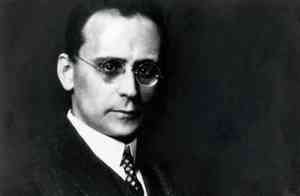 Anton Webern Source: Bach Cantatas |
Born on 3 Dec 1883 in
Vienna, pianist
Anton Friedrich
Wilhelm von Webern
was a Roman Catholic with a civil servant for a father. "Von" was removed
from his name by decree of the Austrian government after World War I to
abolish traces of nobility. His first compositions are commonly catalogued
as a WoO of 1899, 'Zwei Stücke für Cello und Klavier' in 1899
[Petrucci;
interpretation w score
by Daniel McDonough (cello) & Gilbert Kalish (piano)]. Webern attended Vienna University
in 1902. He studied twelve-tone composition under
Arnold Schoenberg
before the appearance of his orchestral Op 1 in 1908: 'Passacaglia'
[1,
2,
3,
4;
autograph;
interpretation w score by the Dresden Staatskapelle w Giuseppe Sinopoli;
live performance by the WDR Sinfonieorchester Köln w Jukka-Pekka Saraste;
score: 1,
2].
Webern's Op 2 was assigned to the choral piece of 1908, 'Entflieht auf
Leichten Kähnen' ('Escape in Light Boats') with lyrics by Stefan George
[*;
interpretaions by the BBC Singers,
the Choir Aidija (live),
the John Alldis Choir,
various;
score: 1,
2,
3].
'Fünf Lieder' for voice and piano Op 3 was completed in 1909
[*;
as atonal expressionism;
interpretation
by Heather Harper (soprano) w Charles Rosen (piano)]. Upon receiving his
doctoral degree in
Vienna in 1906 he conducted at various theatres in what are now the Czech Republic
and Poland. His mother had also died in 1906. It was 1913 when 'Five Pieces
for Orchestra' Op 10 arrived
[1,
2,
3;
autograph;
interpretation by the Berliner Philharmoniker w Pierre Boulez;
live performance by the Ensemble Intercontemporain w Matthias Pintscher;
score].
'Funf Geistliche Lieder' Op 15 was written from 1917 to 1922 w texts by
Peter Rosegger [Petrucci;
live performance by Laura Aikin
(sopran);
score;
'Mein Weg geht jetzt vorüber' Op 15 No.4:
LOC;
autograph;
interpretation by Halina Lukomska]. From 1918 to 1922 he assisted
Schoenberg
with the Society for Private Musical Performances, then conducted the Vienna
Workers Symphony Orchestra until 1934. On May 1 1936 he conducted the
premiere of
Alban Berg's 'Violin Concerto' in
London, that for the BBC which recorded it. Webern's work was banned from the
Nazi regime as degenerate in 1938, the year Germany annexed Austria
[the Anschluss: 1,
2,
3,
4]. Webern yet remained in Vienna, not able to publish and hardly
eking a living in a complex situation shared by others of the populace, the
generality of which was the welcome w mixed feelings of National Socialism until its realities gradually became more apparent.
Webern himself was friendly w Jews and is known to
have assisted them. As for composing, he attended the premiere of his
'Variations for Orchestra' Op 30 in Switzerland in February of
1943 where his music was legal as compared to not
[1,
2;
interpretations by Berliner Philharmoniker w Pierre Boulez
& the Staatskapelle Dresden w Giuseppe Sinopoli w score].
His last composition was 'Cantata No.2' Op 31 for voice, choir and orchestra
written between 1941 and 1943
{1,
2;
autograph;
interpretation by the BBC Singers and the Berliner Philharmoniker w Pierre Boulez}.
Webern preferred silence to distraction from a musical path that he'd not
compromise, composing nothing for the Nazi regime. He yet worked for the police in
an air raid capacity until leaving Vienna for Salzburg upon Russian forces
nearing Austria in 1945. Webern's death shortly afterward was
ironic as well, shot by accident by an American GI upon stepping out of his house to
smoke a cigar on September 15, 1945, three months after the Allies had
assumed authority in Europe (June) and thirteen days after
Japanese surrender had put an end to World War II.
References: 1,
2.
Chronology.
Compositions: Deutsch,
Francais;
alphabetical: 1,
2.
3;
arrangements: English,
Francais;
chronological: 1,
2;
by genre: 1,
2.
3,
Francais;
by Opus: 1,
2,
Deutsch,
Espanol,
Francais;
WoO: 1,
2,
Deutsch,
Espanol,
Francais;
Opus, WoO and arrangements: 1,
2;
songs.
Editions & scores: 'Anton Webern Gesamtausgabe';
Canada;
Germany.
Books & documents: 1,
2,
France; Germany:
1,
2.
Song texts: 1,
2.
Sheet music: 1,
2.
Audio: 1,
2,
3,
4,
5,
6,
7.
Recordings of: discos: 1,
2,
3;
select: 'Complete Works Opp.1-31' conducted by Pierre Boulez;
'Schönberg | Webern | Berg' by the London Symphony Orchestra w Antal Dorati; 'Vocal and Orchestral Works' by the Philharmonia Orchestra w Robert Craft,
review.
Further reading: Karlheinz Essl (analysis);
Russell Platt ('New Yorker').
See also:
Iconography;
WebernUhrWerk music generator.
Biblio: 'The Twelve-Note Music of Anton Webern: Old Forms in a New Language' by
Kathryn Bailey (Cambridge U Press 1991); 'The Anton Webern collection: early vocal music, 1899-1909' by
Carl Fischer (L.L.C. 2004); 'Anton Webern: A Research and Information Guide' by
Darin Hoskisson (Taylor & Francis 2017).
Other profiles: Deutsch: 1,
2,
3;
English: 1,
2,
3,
4,
5,
6,
7,
8;
Espanol;
Finnish;
Francais: 1,
2;
Luxembourgish.
Per below '5 Pieces for Orchestra' is an example of Expressionistic composition. Anton Webern 1911-13 Op 10 Berliner Philharmoniker Pierre Boulez Fugue 2 (Ricercata) 1934-35 WoO London Symphony Orchestra Pierre Boulez 1904 WoO Idyll Cole Conservatory Orchestra Johannes Müller-Stosch 1908 Op 1 Passacaglia London Symphony Orchestra Pierre Boulez 1906 WoO Cuarteto Quiroga 1936-1938 Op 28 3 movements Juilliard String Quartet 1928 Op 21 2 movements Berliner Philharmoniker Pierre Boulez 1936 Op 27 Piano: Paola Visconti |
|
|
Born on 9 Feb 1885 in Vienna,
Alban Berg
began writing songs about 1900. He is traced to 86 songs, most tonal as
compared to atonal, and 16 canons along
with works for string quartet and piano. Petrucci (IMSLP) has early songs
composed from 1901 to 1904 posthumously published on an uncertain date in
'Jugendlieder' Vol 1
[lyrics].
He acquired formal training under
Arnold Schoenberg,
in 1904, that quite prior to Schoenberg's twelve-tone method of 1923. His Opus 1 was 'Piano Sonata' possibly composed in 1909, published in
1910, its first performance in Vienna on 24 April 1911 by pianist, Etta Werndorff [1,
2,
3,
4,
5;
interpretations by Nikolai Demidenko
or
Мария Юдина (Maria Yudina);
live performances by
Glenn Gould
or
Laurence Manning].
'Vier Gesange' Op 2 arrived in 1910 in which early atonal composing appeared
via 'Warm die Lüfte' ('The Warm Air') No.4 ['Vier Gesange': 1,
2,
3,
4;
interpretation by Dietrich Fischer-Dieskau (baritone) w Aribert Reimann (piano);
live performance by Irena Troupová (soprano) w Jan Dušek (piano) * or
Brittany Lasch (trombone) w Thomas Weaver (piano) *;
lyrics;
scores: 1,
2];
'Warm die Lüfte' Op 2 No.4 sung by Anna Hofmann or
Elisabetta Lombardi].
His 'String Quartet' Op 3 composed in 1910 premiered at the Vienna
Musikverein on 24 April 1911 [1,
2,
3,
4;
interpretations by the Artis Quaret * or
the New Zealand String Quartet * w score;
live performance by the Linden String Quartet].
'Fünf Orchesterlieder' ('Altenberg Lieder') for voice and orchestra Op 4
premiered on 31 March 1913 [1,
2,
3,
4;
interpretation by Halina Lukomska (soprano) w the Sinfonieorchester des Südwestfunks diretta da Ernest Bour;
score]. From 1915 to 1918 Berg served in the Austro-Hungarian army, then began
teaching in Vienna. Though he'd composed 'Vier Stücke' Op 5 for clarinet and
piano in 1913 it didn't see performance until 1919
[1,
2,
3,
4,
5;
clarinet interpretations by Luis Fernandez (live),
Miha Kosec w score,
various]. Berg's music found little, even hostile, audience until
the premiere of the first of his two operas, 'Wozzeck', in 1925. To preface
that a little, in
1923
Schoenberg had
introduced his twelve-tone method w 'Fünf Klavierstücke' Op 23 along with
its formal introduction in a letter to Josef Matthias Hauer that December. A
firm student of
Schoenberg, though Berg
had begun to write 'Wozzeck' back in 1914 he late included twelve-tone
technique. 'Wozzeck' premiered at the Berlin State Opera on 14 December 1925
[1,
2,
3,
4,
5,
6,
7,
8;
audio
of Act I by
the New York Philharmonic w Dimitri Mitropoulos;
live performance under
musical direction by Claudio Abbado
(CD);
film
directed by Joachim Hess w conducting by Bruno Maderna]. Berg employed
dodecaphonic method the remainder of his career. The first movement of his
'Chamber Concerto' of 1910 contains five twelve-tone variations titled 'Thema
scherzoso con variazioni' ['Chamber Concerto':
1,
2,
3,
4,
5;
interpretation w score by the Chamber Ensemble of the Moscow Conservatory w Yuri Nikolaevsky;
score;
Thema scherzoso con
variazioni' 1/3: live performance
by the U of Florida Wind Symphony w David Waybright]. Berg spent 1929 to 1935
writing his second opera about a prostitute, 'Lulu', to incompletion. It
didn't arrive to the Zurich Opera in unfinished form until 2 June 1937, a
year and a half after Berg's death on Christmas Eve of
1935 from blood poisoning caused by an insect sting that developed into a
carbuncle on his back. His modernism had by that time gotten him labeled
entartete (degenerate)
by the Nazi government in September 1935, more specifically, a Cultural
Bolshevist. For music sanctioned by the National Socialist regime see Reichsmusikkammer. Having composed
numerous lieder for piano with voice,
Berg also left behind works for chamber and orchestra.
References: 1,
2.
Chronology.
Compositions: 1,
2,
3,
Deutsch,
Espanol;
alphabetical: 1,
2;
chronological;
by genre: 1,
2;
published by year of composition.
Song texts.
Editions & scores.
Books & documents: Canada;
France;
international: 1,
2.
Sheet music.
Audio: 1,
2,
3,
4,
5,
6.
Recordings of: discos: 1,
2,
3;
select: 'Berg: Complete Songs': 1,
2;
'Jugendlieder' by Julia Bentley (mezzo-soprano) w Kuang-Hao Huang (piano).
IMDb.
Further reading: twelve-tone composing:
Headlam;
New World.
Iconography.
Bibliography:
'Berg's Wozzeck' by Patricia Hall (Oxford U Press 2011)
w review by David Headlam;
'The Music of Alban Berg' by Dave Headlam (Yale U Press 1996);
'The Berg Companion' by Douglas Jarman:
1,
2.
Other profiles: Deutsch: 1,
2;
English: British Library;
encyclopedic: 1,
2,
3,
4;
musical: 1,
2,
3,
4;
Espanol;
русском: 1,
2,
3,
4.
Per below, 'Lulu' and 'Wozzeck'
contain example of expressionist
composition. Alban Berg 1914-15 Op 6 3 movements Hungarian State Symphony Orchestra Claudio Abbado 1929–35 Opera 3 acts O du Théâtre National de l'Opéra Paris Lulu: Teresa Stratas 1907–1909? Op 1 Piano: Helene Grimaud 1929 premiere 1930 Aria Vienna Philharmonic/Pierre Boulez Soprano: Dorothea Roeschmann 1935 2 movements North German Radio S O Conducting: Thomas Hengelbrock Violin: Ivry Gitlis 1914–22 Op 7 Opera Chorus of the Hamburg State Opera Hamburg Philharmonic State Orchestra Bruno Maderna Wozzeck: Toni Blankenheim |
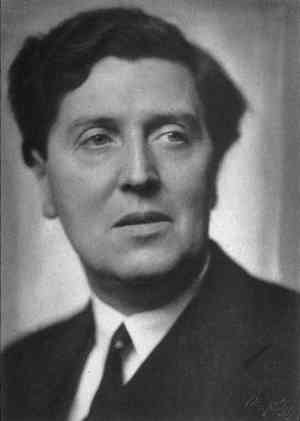 Alban Berg Source: Mariinskiy |
|
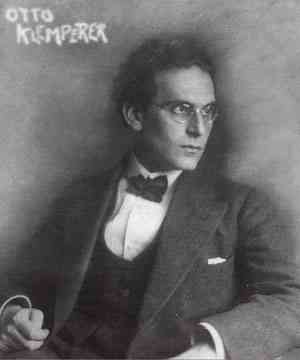 Otto Klemperer Source: More Than the Notes |
Born on 14 May 1885 in Breslau, Germany (now Wrocław,
Poland),
Otto Klemperer
never attained to reputation as a composer as he would have preferred, but as a conductor his name
looms as large as any other classical musician of the twentieth century. His
compositions are little known and not well documented. The singular
exception on the internet is Klemperer where Cynthia Remmers is able to
provide a date on only one work as early as 1901, that a song for voice and
piano called 'Begegnung' ('Encounter') set to the eponymous poem of 1841 by
Heinrich Heine [text].
Klemperer
studied at several institutions before becoming conductor at the German
Opera in Prague in 1907. His first of several neglected operas of his own
was 'Wehen' in 1915. More popular were his concert tours to Moscow, his
first of multiple over the years in 1924. Considerably more successful
beyond that was his career as a recording
artist, conducting numerous
important sessions. Klemperer joins
Stokowski
as one of the earliest composers in this history to live
long enough to record extensively with magnetic tape technology. Per Bruggeman
& Unger at
Archiphon,
Klemperer's first acoustic tracks
went down in November of '24 with the Berlin State Opera Orchestra only
slightly before the development of electrical recording. Those were
performances of
Beethoven's
Symphonies Nos.1 & 8,
Schubert's ‘Unfinished’ and the Adagio from
Bruckner’s
'Symphony No.8'. He worked for several German opera houses before
leaving for the United States in 1933 upon the rise of National Socialism,
he being Jewish. Come his recording of
Bruckner's 'Symphony no.9' in D minor
in
1934 [audio]. He became director of the Los Angeles Philharmonic, then
a U.S. citizen in 1937. Klemperer was diagnosed with a large brain tumor in
1939, resulting in partial paralysis and loss of his position with the Los
Angeles Philharmonic. In 1947 he returned to Europe to work at the Budapest
Opera, also working as an itinerant conductor. He recorded
Mozart's Symphony
No.38 in Berlin w the RIAS Symphony Orchestra in 1950 [audio].
In 1951 he traveled to Israel to conduct the Jerusalem Radio Orchestra in
Tel Aviv and Jerusalem, returning to Jerusalem often over the years to visit
his sister who resided there. Bruggeman & Unger have him appointed principle conductor of the Philharmonia
Orchestra
(founded 1945) in 1954, making Switzerland home base the same year
[Wikipedia has '59 for those events, probably a typo]. Come the taping of
Beethoven's 'Symphony No.3' ('Eroica') in 1955
[audio].
It was Mozart's 'Symphony No.38' again in 1956, now w the Philharmonia Orchestra
in London [audio].
Among his own compositions was 'Joyeuse Valse' for orchestra in 1959
[interpretation by
Stokowski w the New Philharmonia at Royal Hall on 14 May 1974].
Klemperer had resurrected 'Merry Waltz' from his 1915 opera, 'Das Ziel', the latter
revised in 1970 fifty-five years later to apparently as little note as the
original.
JS Bach's 'Brandenburg Concertos' went down w the Philharmonia
Orchestra in 1960 to considerably greater success [audio].
Come his interpretation of
Mahler's 'Symphony No.7' ('Nachtlied') in 1968 for EMI
[audio].
Klemperer became an Israeli citizen in 1970, the same year he last performed in
Israel, conducting the Israel Broadcasting Orchestra in a version of
Mahler's 'Symphony No.9' [audio: 1,
2].
Retiring from the liffe of an orchestra director the next year, he died in
Zurich on 6 July 1973.
References: 1,
2,
3.
Chronologies: 1,
2,
3.
Compositions by genre.
Books & documents: Canada;
France;
international: 1,
2.
Collections: Library of Congress: 1,
2.
Audio: 1,
2,
3,
4,
5,
6;
orchestral: 1,
2;
piano & voice: 1,
2;
string quartets: 1,
2;
symphonies: 1,
2.
Recordings of: discos: 1,
2,
3,
4,
5,
6,
7,
8,
9;
select: 'Beethoven: Fidelio': 1,
2;
'Beethoven: Missa Solemnis'
*;
'Mozart: The Last Six Symphonies'
*.
Klemperer in film: 1,
2,
3,
4.
Documentaries: 1,
2.
Further reading: George Fries
(Deutsch);
GMG;
newspaper archives;
Peter Quantril.
Iconography.
Bibliography:
'Otto Klemperer' by Peter Heyworth (Cambridge U Press 1996):
Vol 1 1885-1933,
Vol 2 1933-1973.
Other profiles: Deutsch: 1,
2;
Dutch;
English: encyclopedic: 1,
2,
3;
musical: 1,
2,
3;
Espanol: 1,
2;
Francais;
Italian;
русском: 1,
2,
3.
Otto Klemperer Merry Waltz (Lustiger Waltzer) 1915 From 'Das Ziel'Staatsphilharmonie Rheinland-Pfalz Alun Francis Fuga (Moderato) Philharmonia Quartet Scherzo (Vivace) Philharmonia Quartet Intermezzo (Alla marcia) Philharmonia Quartet Adagio Philharmonia Quartet 1914-15 Op 6 3 movements New Philharmonia Orchestra Otto Klemperer 1914-15 Op 6 3 movements New Philharmonia Orchestra Otto Klemperer |
|
| Born on 28 Jan 1887 in Łódź, Congress Poland (part of Russia at the time),
Arthur
Rubinstein wasn't a composer, but a
virtuosic pianist without mention of whom would leave a large gap in a
history of classical music in the early 20th century. Confuse not with
the earlier
Anton Rubinstein
or later Arthur B. Rubenstein. His father, probably
as Jewish as Rubinstein was, owned a small textile factory, and was well
aware that he had a kid who liked to play piano by the time Rubinstein gave
his first public performance in 1894. In 1897 he was sent to Berlin to
study, performing with the Berlin Philharmonic in 1900. His first
performance in America was at Carnegie Hall in NYC in 1906. He also
attempted to hang himself that year, experiencing financial desperation. He
thereafter toured the States, Austria, Italy and Russia. On an unidentified
date in 1910 he made his first recording
for the Polish label, Favorit,
Franz Liszt's 'Hungarian
Rhapsody No.10' followed by 'Hungarian Rhapsody No.12' in 1910 date unknown [audio].
Like most other classical musicians, Rubenstein wasn't a big fan of early
acoustic recording. Albeit the preceding audio is 110 years old at this
writing, poor fidelity brand new yet made it an unfit medium. Rubinstein
wouldn't record again until the advent of the electric microphone. His debut
in London in 1912 came w conditions to which he could glue, spending World War
I in London. Giving his last performance in Germany in 1914, he thereafter
severed all ties with that nation. Commencing a tour of Spain and South
America in 1916, he thereafter toured Great Britain and the United States.
From 1919 to 1924 Rubinstein made 22 piano rolls for Aeolian's Duo-Art label
in America [1,
2;
audio].
Ates
Orga has him making nine rolls for Ampico as well, estimating dates
between 1916 and 1925. Three of those were Barcarolles Nos.3-5 by
Anton Rubinstein
[audio: 1,
2,
3].
Viljanen at SoundCloud [1] gives No.3 a date of October 1919. Piano rolls
sounded far better than acoustic recordings with the caveat of the nuances
of live performing lost. Nor could many households afford a player piano
like they could a gramophone (record player). Rubenstein's main man was
Chopin, he nigh a Chopin II as a performer. His first electrical recordings
were of
Chopin, the latter's 'Valse Brilliante' from Op 34 gone down on 9
March of 1928 followed by 'Barcarolle for Piano' in F sharp major on 18
April [audio
both]. Rubenstein recorded the latter piece five times to as late as 1964.
Though far from the only woman in his life, Rubenstein waited until the age
of forty-five to marry a 24 year-old ballerina named Nela Młynarski
[1,
2]
in 1932. In 1934 he ceased giving concerts for several months in order to practice
and analyze technique that he'd been freewheeling thus far. Rubenstein spent
World War II in California where he became
a U.S. citizen in 1946. While on the West Coast he recorded for film soundtracks. He himself appeared in 'Carnegie Hall' in 1947 [1,
2;
film;
performance
including a Polonaise by Chopin and
Manuel de Falla's 'Ritual Fire
Dance']. He also appeared in 'Of
Men and Music' in 1951 [*].
'The Love of Life' premiered on 17 June 1969, a
documentary about Rubinstein directed by Gérard Patris w François
Reichenbach and produced by Bernard Chevry [see ref]. Rubinstein's autobiography, 'My Young
Years', appeared in 1973 [reviews: 1,
2,
3].
He gave his last performance at London's Wigmore Hall in 1976, his eyesight failing. His next memoir, 'My Many
Years', was published in 1980 [reviews: 1,
2,
3].
He died in his home in his sleep in Geneva, Switzerland, on 20 December 1982
[obits: 1,
2]. Rubenstein played music largely by composers of the
Romantic period. He had much in common with
Sergei Rachmaninoff in
that he possessed a remarkable memory. He was fluent in eight languages as
well. Both agnostic and a notable philanthropist, amidst his counsel to
young pianists was to practice no more than three hours a day, it better to
pretend that you know what you're doing than risk revealing the blood, sweat
and tears, so to speak, that one might put into something. His approach to
making performances look easy was apparently to lighten up to prevent
beating a tired horse. He himself called a
long work day about six to nine hours, and that was only for several months
in 1934 as mentioned above.
References for Rubinstein: 1,
2.
Audio: 1,
2,
3,
4,
5,
Top Ten per Gramophone.
Recordings of: discographies: 1,
2,
3,
4,
5,
6,
7;
select: 'The Chopin Recordings' 1928-39 including
Mazurkas;
'Chopin: Scherzos & Polonaises' 1928-35.
Film.
Documentaries: 'Warsaw' 1965;
'The Love of Life' 1969;
interview w Robert MacNeil 1977;
Marie-Claire Margossian for ARTE-Television 2010:
Part 1,
Part 2,
Part 3,
Part 4.
Further reading: piano rolls:
Peter Phillips;
Welte-Mignon Catalog;
recordings: 1,
2,
3;
students of.
Books & documents: 1,
2,
3,
Canada,
Germany.
Collections: Library of Congress: 1,
2.
See also: iconography;
the Arthur Rubenstein Society.
Other profiles: Catalan;
Deutsch;
English: 1,
2,
3,
4,
5,
NPR;
Espanol;
Hebrew;
Hungarian: 1,
2;
Italian;
Polish: 1,
2.
Arthur Rubinstein Composed 1809-10 Op 15 3 movements Philharmonic Orchestra Conductor: Eugene Ormandy Composed 1854-59 Op 15 3 movements Concertgebouworkest Amsterdam Bernard Haitink Live in Amsterdam 1973 Composed 1841-42 Op 50:3 3rd of 3 movements Composed 1841 Op 48:1 1st of 2 movements Chopin Piano Concerto 2 in F minor Composed 1829-30 Op 21London Symphony Orchestra André Previn Live 1975 Grieg Piano Concerto in A minor Composed 1868 Op 16 3 movementsLondon Symphony Orchestra André Previn Published 1850 R 211 S 541 Live 1954 Composed 1853 3 movements Recorded 1965 Great Hall of the Moscow Conservatoire 1964 Composed 1839 Op 49 D minor Movement 1 of 4 Molto Allegro agitato Cello: Gregor Piatigorsky Violin: Jascha Heifetz Composed 1839 Op 49 D minor Movement 3 of 4 Scherzo (Leggiero e vivace) Cello: Gregor Piatigorsk Violin: Jascha Heifetz Composed 1900–01 Op 18 3 movements Chicago Symphony Orchestra Fritz Reiner Recorded 1956 'Rhapsody on a Theme of Paganini' 1934 Op 43 A minor Filmed live 'Rhapsody on a Theme of Paganini' 1934 Op 43 A minor Chicago Symphony Orchestra Fritz Reiner Recorded 1956 Composed 1868 Op 22 G minor London Symphony Orchestra André Previn Live performance Composed 1827 Op 90 |
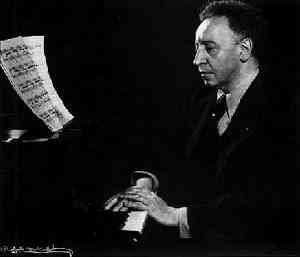 Arthur Rubinstein Source: Find a Grave |
|
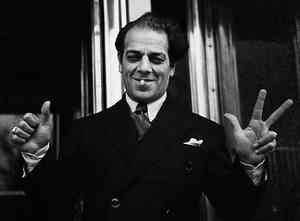 Heitor Villa-Lobos Source: Bach Cantatas |
Born on 5 March 1887 in Rio
de Janeiro,
Heitor Villa-Lobos
is the first classical composer from South America to find these histories, and glad
is he to the near. Portuguese Brazil had declared itself an independent
nation in 1822, becoming a republic in 1889. Hector's father was a civil servant
as an assistant librarian at the National Library when forced to leave Rio
de Janeiro and take his family into hiding in order to publish conservative
political views. Able to return to Rio sometime later, Heitor's father was
also an amateur musician at whose home assembled others likewise, from which
gatherings Heitor gleaned enough to teach himself to play cello, clarinet
and guitar w assistance from his father. He also played in
street bands toward eventually becoming young Brazil's first representative
classical composer. His first composition as of 1899 yet exists in
manuscript though has never been published, 'Os Sedutores' ('The Seducers'),
a piece for voice and piano written for his mother after the death of his
father of malaria the same year. Heitor had not yet learned to perform at
piano at the time. Also called 'Cançoneta' (short song), 'Os
Sedutores' is catalogues as W001. "W" numbers in Villa-Lobos are per 'A
Bio-Bibliography' by David Appleby (Greenwood Press 1988). W002 is assigned
to a piece now lost for solo guitar called 'Panqueca' ('Pancake') written in
1900. W003 is another piece for voice and piano titled 'Dime Perché'
composed in 1901 [audio of arrangement for guitar by Andrea Bissoli:
1,
2].
Heitor became a student at Pedro II College in Rio in 1901. He made the first
of multiple trips into the interior of Brazil to study folk music in
1905, after which he attended the Instituto Nacional de Musica in 1906 and '07. His initial one-act opera, 'Aglaia'
W021, was composed in 1909, later incorporated into his opera of 1912-14, 'Izaht'
W055, all four acts of which wouldn't see performance until November 1958
[Overture by the Orquestra Sinfônica Nacional da UFF
conducted by Tobias Volkmann]. Having yet to learn to perform
at piano, he composed 'Piano Trio No.1' in C minor W042 in 1911 for piano,
cello and violin [audio by the International Chamber Artists Trio;
live performance by the Reverón Piano Trio]. Already earning his living as a cellist in various orchestras, in 1912 he
married pianist, Lucília Guimarães, who finally taught him to play piano
[1,
2,
3]. Heitor's first major distinctive work was a ballet, his symphonic poem, 'Amazonas'
W118, in which European composition met with his studies of Brazilian folk
music. Though composed in 1917, it didn't see performance until 1929 in
Paris. Another tone poem for ballet was completed the same year,
'Uirapurú' ('Enchanted Bird') W133, that not to premiere until 25 May 1935 at
the Teatro Colón in Buenos Aires
[1,
2;
audio by Bulgarian RSO w Ricardo Averbach or
the Orquestra Sinfônica da Paraíba w Eleazar de Carvalho;
live performance by the Hungarian National Philharmonic w Zoltán Kocsis]. In 1918 he met one of his most important musical associates,
Arthur Rubinstein,
moving him to greater interest in writing for piano, such as his modernistic
character pieces, 'A Prole do
Bebê' ('The Baby's Family'), No.1 of which was composed in 1918, though Rubinstein didn't premiere
'As Bonecas' ('The Dolls') until 5 July 1922 at
the Teatro Municipal in Rio [audio w piano by Marc-André Hamelin]. 'A Prole do Bebê No.2' was written in 1921
titled 'Os Bichinhos' ('The Little Animals') [live performance w piano by Lucas Gonçalves]. No.3 titled 'Esportes'
('Sports') arrived in 1926 but is now lost. Along the way Villa-Lobos had
begun his 'Choros' ('Cries') for guitar composed between 1920 and 1929
consisting of Nos. 1-14 arising of his interest in choro, a popular
street music originating in Rio in the nineteenth century
['Chôros No. 1' W161: 1,
2,
3,
4,
5;
live performances by Kyuhee Park
(w score) &
David Russell;
score].
IMSLP has 'Douze Etudes' composed in Paris in 1929 though they wouldn't
premiere by
Andrés Segovia until 5
March 1947 at Wellesley College in Massachusetts. They saw publishing in
Paris by Max Eschig in 1952 w dedication to Segovia
[1,
2;
audio of guitar by Leonora Spangenberger;
live performance by Young Seo;
scores: 1,
2,
3,
4;
live performance of 'Etude No.1' by
Xingye Li].
Villa-Lobos began the project of his nine 'Bachianas Brasileiras' in 1930,
completing that series of baroque w a Brazilian twist in 1945 [1,
2]. Prominent among those is the first
movement of No.5 that is 'Aria' written in 1938 [1,
2;
soprano by Arleen Augér w score;
live performance by Barbara Hannigan]. In
1932 Villa-Lobos became Director at Superintendência de Educação Musical e Artística
(SEMA) in São Paulo. Though he never divorced his wife, Guimarães, he left
her in 1936 for Arminda Neves d’Almeida (aka Mindinha) to whom he dedicated
his 'Choros No.6'
W219 of '26
[audio] and w whom he remained
the rest of his life. Villa-Lobos wrote the soundtrack for Humberto Mauro's
1938 film, 'Descobrimento do Brasil' ('Discovering Brazil'). Albeit his 'Cinq Préludes'
for guitar of 1940 were originally
dedicated to Segovia, they were published by Eschig in 1954 w dedication to
Mindinha [interpretation by Christoph Denoth]. in
1942 Villa-Lobos founded both the National Conservatory and the Brazilian
Academy of Music. Heitor toured internationally after World War II including Paris,
the United States, Great Britain and Israel. He composed the score for the film, 'Green
Mansions', that premiered in 1959 adapted for the screen by Bronislau Kaper
[1,
2,
3,
4].
As Kaper had much altered Villa-Lobos' original composition, 'A Floresta do
Amazonas' W551, to make a soundtrack of it, Villa-Lobos wrote a couple of
symphonic suites
[audio] along with other versions the same year to his greater
satisfaction. 'A Floresta do Amazonas' contained songs with lyrics by Dora
Vasconcellos grouped as 'Quatro Canções da Floresta do Amazonas'
[*;
interpretation by
Rosana Lamosa (soprano) w Nahim Marum (piano)]. Heitor died in Rio de Janeiro on 17 Nov 1959.
Having
been a prolific composer notable in stepping beyond classical forms, he
manufactured
above 1000 works [2000 Wikipedia] for guitar, piano, voice, chamber and orchestra.
References: 1,
2,
3.
Compositions: BNF,
Klassika;
alphabetical: 1,
2,
extensive;
by Appleby (W number);
by genre: 1,
2,
3,
4,
5,
extensive,
German;
choros;
string quartets;
symphonies: 1,
2.
Song texts.
Editions & scores (Germany).
Books & documents: Canada;
France; international:
1,
2.
Sheet music.
Audio: 1,
2,
3,
4,
5,
6,
7,
8.
Recordings of: discos: 1,
2,
3,
4;
select: 'Floresta do Amazonas'
by the Sau Paulo C & O w John Neschling featuring Anna Korondi (soprano);
guitar by Andrea Bissoli: 'Complete Guitar Manuscripts' 1,
2,
3,
4;
'The Guitar Manuscripts 1': 1,
2,
review;
'The Guitar Manuscripts 2': 1,
2,
review;
'The Guitar Manuscripts 3': 1,
2,
review.
IMDb.
Further reading by source: Estudios de Villa-Lobos; Paulo Renato Guérios:
English,
Portuguese;
Villa-Lobos Magazine;
Stanley Yates.
Further reading by topic: Estudos (Eduardo Meirinhos);
guitar music of: by Richard Kevin DeVinck;
by Orlando Fraga: 1
(alt);
by Eduardo Meirinhos;
Villa-Lobos and Antonio Carlos Jobim;
and orpheonic singing.
See also: iconography;
the Heitor Villa-Lobos Website.
Bibliography.
Other profiles: English: cultural;
encyclopedic: 1,
2,
3,
4;
musical: 1,
2;
French: 1,
2;
German;
Portuguese: 1,
2,
3,
4;
русском:
1.
2.
Heitor Villa-Lobos 1938 W 388 For piano 4 movements Orquestra Sinfônica Brasileira Isaac Karabtchevsky Piano: Nelson Freire For piano 1930–41 W 264 For orchestra 1941 W 424 4 movements Orquesta Sinfónica Simón Bolívar Roberto Tibiriçá Roberto Tibiriçá Movement 1: 1938 Movement 2 1945 W 389-391 For voice Nardo Poy Soprano: Nancy Allen Lundy 1915 Victor Pablo Pérez Cello: Antonio Meneses 1920 W 161 For guitar Guitar: David Russell 'Rasga o coração' ('It Tears Out the Heart') 1926 W 209 Sinfónica de la Juventud Venezolana Isaac Karabtchevsky 1944 'The Mountains of Brasil' Hungarian State Symphony Orchestra Claudio Abbado 1917 premiere 1935 Buenos Aires W 133 Ballet 1 act Orquesta Sinfonica de RTVE Carlos Kalmar |
|
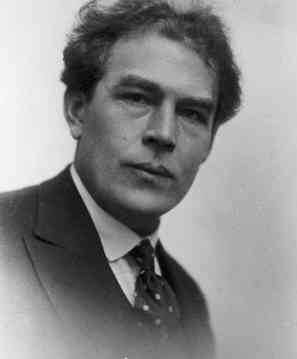 Heino Eller Source: Kino Soprus |
Heino Eller would
have to have been a large baby to have been born on Tartu in Estonia on 7
March 1887. Little known beyond the Baltic region, he played in several ensembles and as a solo violinist before entering
the St. Petersburg Conservatory in 1907. Documentation of his compositions
generally begins with three pieces for piano in 1909: 'Allegro Moderato' in
C minor, 'Larghetto in A' and 'Sostenuto' in G minor. He graduated in 1920 after Saint
Petersburg was renamed the Petrograd Conservatory. 'Piano Sonata No.1' in A
minor was
one his graduation requirements. He also married Jewish pianist,
Anna Eller (nee Fenrich),
in 1920. They were wed until 1927, Fenrich to eventually be executed in a Nazi
concentration camp in Poland in 1942. Eller taught composition and
music theory for the next couple decades at the Tartu Higher School for
Music [1,
2,
3]. During that period one of his more famous pieces for piano, 'Die Glocken' ('The Bells'), was written in 1929
[interpretation by Aleksandra Juozapénaité-Eesmaa or
Jaak Sikk;
live performance by Sten Lassmann
or
Marko Martin]. In 1940 he switched
from the Tartu School to the Tallinn Conservatory
[1,
2]. He also taught
composition privately as an alternative to the school of Artur Kapp. Eller's career put
Estonia on the map of classical music, among
his pupils, another Estonian composer, Arvo Pärt.
Having written a couple hundred works, Eller died on 16 June
1970 leaving his 'Violin Sonata No.3' begun in 1969 unfinished. References: 1,
2.
Compositions:
alphabetical;
by genre: 1,
2,
3,
Francais,
Italian,
русском.
Editions & scores: 1,
2.
Audio: 1,
2,
3,
4,
5,
Symphonies Nos.1-3.
Recordings of: discos: 1,
2,
3;
select: 'Complete Piano Music' w Sten Lassmann at piano:
Vol 1,
Vol 2,
Vol 3,
Vol 4,
Vol 5,
Vol 6;
'Symphonic Poems' by the Estonian National Symphony Orchestra w Olari Elts:
1,
2;
'Thirteen Piano Pieces on Estonian Motifs' by Aleksandra Juozapénaité-Eesmaa.
See also: Tartu Music College.
Other profiles: Deutsch;
Dutch;
English: 1,
2,
3;
Estonian: 1,
2;
Finnish;
Francais;
Romanian;
русском: 1,
2.
Heino Eller 1953 Ostrobothnian Chamber Orchestra Juha Kangas 1961 For piano Recorded 1962 Piano: Heljo Sepp 1929 Piano: Sten Lassmann 1915-18 1920 Tone poem Estonian State Symphony Orchestra Neeme Jarvi 1924 For orchestra Direction: Peeter Lilje 1928 Direction: Toenu Kaljuste 1921 Piano: Sten Lassmann |
|
| Born in Paris on 16
Sep
1887,
Juliette Nadia Boulanger
was a pianist and violinist more a teacher than composer. Though composing
occupied only the earlier portion of her life she is the first female
classical composer to see these histories. Nadia Boulanger was six years the
elder of her sister,
Lili Boulanger.
Her father was composer, Ernest Boulanger. She entered the Paris
Conservatoire in 1896, quite young at age nine, and became a Catholic at age
twelve. Boulanger began playing professionally about 1903 and studied
composition under
Gabriel Fauré before
beginning her pedagogical career in 1904, teaching at her apartment. In 1908
she began performing duets with pianist, Raoul Pugno. She began conducting
in 1912, leading the Société des Matinées Musicales orchestra. During World
War I she and her sister,
Lili, organized
the Comité Franco-Américain du Conservatoire National de Musique et de
Déclamation, a charity providing relief to soldiers who had been musicians.
She ceased composing in 1918 to concentrate on teaching. Her sister,
Lili, also died
that year. After the War she taught at the new École normale de musique de
Paris and began contributing articles to 'Le Monde Musical'. She began
instructing at the American Conservatory at Fontainebleau in Paris in 1921
[1,
2] where
Aaron Copland
was among her students.
Her first tour of the United States began in late 1924 where in 1925 she
lectured at Rice University in Houston, Texas [text]. BBC [1,
2,
3] began recording
her lectures and recitals in 1936. The following year in February on
unidentified dates Boulanger recorded six
discs of madrigals by
Monteverdi
for HMV (His Master's Voice),
thought to be the first
Monteverdi compositions to see recording [audio]. One of
those was
Monteverdi's 1614 'Lamento d'Arianna', a setting to a sonnet called 'Zefiro
Torna' ('Zephyr Returns') by Petrarch (1304-74) [*;
audio
(alt)].
Bryan at Shellackophile supplies a session date of 9 Feb for Boulanger's
conducting of Jean Françaix's 1936 'Concerto' [audio].
Those were first issued on French HMV, then Victor 15114 and 15115. The Dinu
Lipatti
website supplies a date of 20 Feb for
Brahms'
1868 'Liebeslieder Waltzes'
Op 52 performed with Lipatti [audio]. On 25 Feb they recorded
seven of Brahms' sixteen 'Waltzes for
Piano Four Hands' Op 39 of 1866 [audio: No.5,
No.15]. Boulanger's return to
America in 1938 saw her touring and broadcasting for NBC [1,
2], also conducting the
premiere of
Stravinsky’s 'Dumbarton Oaks'
concerto in Washington DC. She fled the German invasion of
France in November of 1940, arriving to Massachusetts to teach at Cambridge
and conduct various orchestras in the States.
Boulanger was back in France in January of 1946 to teach at the Paris
Conservatoire. In 1950 she was appointed Director of the American
Conservatory of Music at Fontainebleau [1,
2]. In 1956 she handled the music for the wedding of actress,
Grace Kelly, and Prince Rainier of Monaco. 1958 saw her back in America
visiting the Institute for Contemporary Arts in Washington DC. She
toured to Turkey in 1962 on unidentified dates. On 17 February that year she
conducted the New York Philharmonic in a rendition of
Fauré's 1900 'Requiem'
at Carnegie Hall [audio]. She also visited the White House on an unidentified date in 1962 to dine w
John and Jacqueline Kennedy. Jérôme Spycket has her returning to the States
once more in 1965. In 1966
Boulanger visited Moscow. She died in Paris on 22 Oct 1979
[obits: 1,
2]. The greater number of
her compositions for the brief period she had committed herself to that had
been for voice, though she also wrote chamber, orchestral and keyboard
works. References: 1,
2,
3.
Chronology.
Compositions: alphabetical;
by genre;
Francais.
Editions & scores.
Books & documents: France;
Germany;
international: 1,
2.
Collections: Loeb Music Library Harvard.
Sheet music.
Audio: 1,
2,
3.
Recordings of: discos: 1,
2,
3,
4;
Monteverdi arrangements;
select: 'Oeuvres de Monteverdi' by the
Boulanger Ensemble;
'A Tribute to Nadia Boulanger'
*.
IMDb.
Further reading by suthor: Diana Ambache,
Don Campbell,
Elaina Cherry,
Matthew Guerrieri,
Paul Hume,
Josh Jones,
FD Leone,
AA Owen,
Ned Rorem.
Further reading by topic: students of: 1,
2,
русском.
See also: the Boulanger Initiative
*;
the Centre International Boulanger
*;
the Fondation Internationale Nadia & Lili Boulanger
*.
Iconography.
Biblio: 'The Musical Work of Nadia Boulanger: Performing Past and Future Between the Wars' by
Jeanice Brooks (Cambridge U Press 2013);
'Nadia Boulanger' by Jérôme Spycket (Pendragon Press 1992).
Other profiles: Deutsch: 1,
2;
English;
Espanol;
русском.
Nadia Boulanger 1914 Cello: Dora Kuzmin Piano: Petra Gilming 1912 Piano: David Greilsammer 1911 Piano: Emile Naoumoff 1911 Organ: Dragan Trajer |
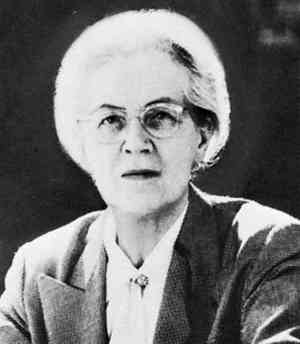 Nadia Boulanger Source: Britannica |
|
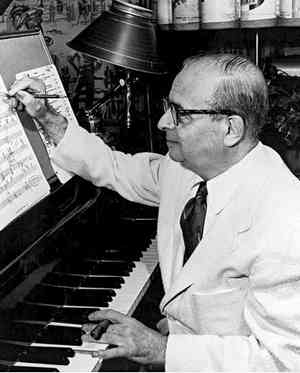 Max Steiner Source: Wikipedia |
Born on 10 May 1888,
Maximilian
Raoul Steiner
personifies classical music transformed into early film soundtracks. These
histories are lacking a section for composers who wrote for the new media of film and television as genres all to
themselves. Thus, as a limb of classical music, strongly
popularizing the same, scoring for the screen wants mention in this chapter,
particularly Steiner. Other scoring for the screen in its early phases
is followed in Modern Popular. After Hollywood, perhaps Italian composers have produced some of the most
notable work in that genre of spectacle, having 300 years worth of practice
with opera.
Howsoever, generally described as the "father" of film music, Steiner had been
born in Vienna, Austria. His own father, Gabor Steiner, was a Viennese
impresario and carnival manager who developed the 'Venice in Vienna' amusement
park in 1895 where in 1897 he had the famous Riesenrad Ferris wheel
installed
[1,
2].
Maximilian's godfather was
Richard
Strauss
of powerful influence throughout his youth. Max conducted his first operetta at age twelve
before his first journey to London to conduct the Blue Vienna Band at the
People's Palace on April 1902 [Edward Leaney]. In April
1903 he composed his initial one-act operetta, 'Ein Kosestundchen' ("A
Cuddle'). Not long after, now age fifteen, he conducted his first
professionally performed operetta, the slightly pornographic 'Das Hubsche
Griechenmadel' ('The Beautiful Greek Girl')
['Max Steiner' by Peter Wegele (Rowman & Littlefield 2014)].
Steiner studied at the Vienna University of Technology before entering the Imperial
Academy of Music in 1904 to study instrumentation, particularly piano,
harmony, counterpoint and composition. He there completed his four-year
program two years later w a gold medal. In 'Music by Max Steiner' Steven
Smith questions that
Gustav
Mahler was a teacher of Steiner, though they likely met and associated
[nor does the Mahler Foundation
mention Steiner as a student]. Upon graduating from the Academy Steiner
worked for his father at 'Venice in Vienna' until taking his one-act operetta,
'Der Kristallpokal' ('The Crystal Cup') of 1906, to Russia. He moved to
London the same year upon invitation by impresario, George Edwards, to
there conduct Franz Lehár's 'The Merry Widow' [Tony Thompson].
Steiner worked in England conducting at various theatres until he ended up
moving to the
United States upon responding to Florenz Ziegfeld Jr.'s invitation to conduct the
'Ziegfeld Follies'. Arriving to New York City
in December 1914, after the 'Ziegfeld Follies' Steiner set his sights on Broadway theatres,
leading
to a career as a musical director on Broadway throughout the Roaring
Twenties. Things changed big time for Steiner upon silent film finally
getting dressed with sound in the latter twenties. After directing an
eight-month run of John Frederick Coots' 'Sons O' Guns' into August of 1930
Steiner forever left Broadway for Hollywood to become Musical Director at
RKO Studios. He had already scored, uncredited, 'Rio Rita' based
on Harry Tierney's Broadway musical by the same title, the film premiering
on 15 Sep 1929. Having spent $678,000 to make the film, RKO grossed
$2,400,000 from box office sales [1,
2,
3]. A
few films followed in 1930 until Steiner's first screen credit that year per the
orchestration of 'Dixiana' on which RKO spent $747,000, to gross only
$780,000 [1,
2;
film: 1,
2].
Thirty-four films later, not all credited, arrived 'Symphony of Six Million'
to its premiere on 14 April 1932. Concerning the perils of a Jewish doctor,
"Six Million" refers to the population of New York City [1,
2,
3,
4,
5,
6,
7;
audio
excerpt]. Six films later 'King Kong' premiered in
March 1933. Budgeted at more than $672,000, 'King Kong' earned Radio
Pictures $5.3 million [1,
2,
3;
soundtrack].
Twenty-two films later arrived John Ford's 'The Informer'. Released on 9 May
1935, Steiner's film score was the first to receive an Academy Award
(Oscar)
[soundtrack suite].
Ford spent $273,000 to make the film which grossed $950,000. Steiner scored
five more films for RKO before testing waters at Warner Brothers w 'Charge of the
Light Brigade' premiering on 20 Oct 1936 at a cost of well above a million
dollars, though to double that at minimum in box office earnings
[1,
2,
3,
4,
5;
soundtrack suite].
Thirty-two films later came Victor Fleming's 'Gone with the Wind' on 15
December 1939. Wikipedia has Metro-Goldwyn-Mayer investing $3.85 million
toward returns eventually exceeding $390 million [1,
2;
soundtrack suite].
Twenty films later Michael Curtiz' 'Casablanca' arrived to its public
premiere in January 1943 [1,
2,
3,
4;
soundtrack suite].
Come Steiner's second Oscar five films later for 'Now, Voyager' released to
the public in Oct of 1942 [1,
2,
3,
4,
5,
6;
final scene conducted by
Leopold Stokowski;
soundtrack suite].
His third and last Academy Award arrived nine films later for John
Cromwell's 'Since You Went Away' premiering on 20 July 1944 w screenplay by
David Selznick [1,
2,
3,
4;
soundtrack suite].
Come a Golden Globe [1,
2] Award 19 films later for Curtiz' 'Life with Father'
arriving to theaters on 14 August 1947 [1,
2,
3;
film].
Twenty-six more film scores filled the forties followed by sixty-one throughout
the fifties to 'A Summer Place' premiering on 18 Nov 1959
[1,
2,
3,
4;
audio].
Wikipedia has Steiner scoring fifteen further films in the sixties to as
late as 'Two on a Guillotine' [1,
2,
3;
trailer] and 'Those Calloways'
[1,
2;
soundtrack suite], both premiering in
January of 1965. Having contributed scores to above 300 films, Steiner died of congestive heart failure on 28 Dec 1971 in Hollywood [obit].
Further references: 1,
2,
3,
4.
Filmographies: 1,
2,
3,
4,
5,
Deutsch,
Finnish,
Francais.
Books & documents international: 1,
2.
Audio: 1,
2,
3,
4,
5.
Discographies: 1,
2,
3,
4,
5.
IMDb.
Video presentations: 1,
2.
Audio interviews:
1945
w George Fisher;
1957
w Walter Ducloux.
Further reading by various.
Bibliography: 'Music by Max Steiner' by Steven Smith (Oxford U Press 2020):
1,
2.
Other profiles: English: 1,
2,
3,
4,
5,
6;
Finnish;
Italian: 1,
2;
Japanese;
русском;
Spanish.
Max Steiner 1942 Soundtrack suite Recorded 1993 Westminster Philharmonic Orchestra Kenneth Alwyn 1939 Soundtrack suite MGM Studio Orchestra/Max Steiner 1956 Soundtrack suite Recorded 1993 Westminster Philharmonic Orchestra Kenneth Alwyn 1933 Soundtrack 1961 Soundtrack suite Conductor: Max Steiner 1944 Soundtrack suite 1942 Soundtrack suite 1965 Soundtrack suite Conductor: Max Steiner |
|
| Born on 27 May 1888 in
Paris,
Louis Durey
was an obscure composer of some 116 works for
chamber, orchestra, stage, piano and voice. Drawn more
to theory in politics than music, his major claim to fame is the brief time that he was
associated with
Les Six [1,
2,
3,
4,
5].
The son of a businessman, Durey didn't pursue a career in music until he
was nineteen,
Debussy
his major early influence. After obtaining a business degree (Hautes
Etudes Commerciales) in 1908 he studied counterpoint and fugue under Leon Saint-Requier,
then attended the Schola Cantorum de Paris from 1910 to 1914. Russian
Wikipedia demarcates Durey's career into three periods: early atonal
1908-14, Satie 1917-37 and socialist 1944-74. His Opus 1 is assigned to 'Two
Choirs' as of 1914 with music set to texts by Henri de Rainier and Charles
d'Orléans. Opus 2 of 1914 is assigned to 'Three Poems by Verlaine', Opus 3
to 'Five poems by Francis Jamm'. Opus 4 of 1914 is his 'L'Offrande Lyrique',
consisting of settings to six poems by Rabindranath Tagore. 'L'Offrande
Lyrique' witnesses what is thought to be the first twelve-tone composition preceding those of
Arnold Schoenberg, the
latter generally credited as the originator of dodecaphony in 1921. World
War I had put Durey into the army in 1914 for a year and four months. His
Opus 5 of 1916 was a setting to Andre Gide's 1893 'Le Voyage d'Urien'. That
was followed by the lost 'Trio avec Piano' Op 6. Durey's association w Les Six, an important group
of avant-garde composers who rallied about
Érik Satie, began with his dedication to Satie of
his four-hands 'Carillons'
('Bells') Op 7 No.1 composed in 1916 and first performed the next year. Op 7
No.2 is 'Neige' ('Snow') composed in 1918, Op 7 being 'Deux Pièces' pour
piano a quatre mains [interpretation by Julian Jacobson w Mariko Brown]. Perhaps
best-known among Durey's works is 'Le Bestiaire' for voice & piano Op 17 composed in 1919 [1,
2,
3,
4;
interpretations by
François Le Roux (baritone) w Graham Johnson (piano)]. That consisted of settings to Guillaume Apollinaire's 1911
'Le Bestiaire ou Cortège d'Orphée' [1,
2].
Francis Poulenc
happened to be composing his 'Le Bestiaire' per Apollinaire at the same time, neither aware
of the other's project. Durey's 'Le Bestiare' Op 17 became Op 17a in 1958 when he
wrote a version for voice and chamber orchestra assigned as Op 17b. Also
arriving in 1919 was his 'Romance Sans Paroles' pour piano Op 21 dedicated
to Spanish pianist, Ricardo Vines
[IMSLP;
interpretation by Françoise Petit;
live performance by Maroussia Gentet]. Durey dropped
away from
Les Six before the premiere
of their collaborative ballet, 'Les mariés de la tour Eiffel', at the
Théâtre des Champs-Élysées on 18 June 1921. With libretto by
Jean Cocteau
and costumes by Jean Hugo, it was choreographed by Jean Börlin
[1,
2;
interpretation
by the Philharmonia Orchestra w Geoffrey Simon]. Durey composed his solitary opera,
the one-act 'L'Occasion' Op 34, in 1923 at his home in Saint-Tropez. In 1929 he married
one Anne Grangeon before returning to Paris the next year to become a member
of the Communist Party. He worked with the French Resistance
during World War II, after which arrived 'Long March' for chorus and
orchestra Op 59a in 1949, set to text by Mao Zedong.
Durey became a music critic for a Communist newspaper in
1950 before composing 'Two Poems by Ho Chi Minh' Op 69 in 1951
[Ho Chi Minh]. Vietnam had been French Indochina from 1945 to 1954. Being less than
sympathetic with the
Vietnam War of 1955-75, Durey composed 'Six Poems of the Children of Vietnam'
Op 113 in 1969. In the meantime he had written 'Autoportraits' in 1967, that
16 pieces for piano Op 108 (108a). Durey's final assigned Opus was also his
last of twenty autoportraits, that being 'Poeme' for piano Op 116 of 1974. He died at Saint-Tropez on 3 July 1979.
References: 1,
2,
3.
Compositions: Deutsch,
Francais;
alphabetical;
chronological;
by genre;
by Opus:
Espanol;
by period (русском);
unpublished song cycles.
Song texts.
Editions & scores (Canada).
Books & documents: France; international:
1,
2.
Audio: 1,
2,
3,
4.
Recordings of: discos: 1,
2,
3;
select: 'Durey Rediscovered' by Jocelyn Dueck (piano);
'L'Album des Six' by Emily Beynon (flute) w Andrew West (piano);
'Songs by Louis Durey' by François Le Roux (baritone) w Graham Johnson (piano).
Bibliography:
Frédéric Robert;
Marc Wood.
Other profiles: Dutch;
Espanol;
Francais: 1,
2,
3;
Italian;
русском: 1,
2.
Louis Durey 1921 Op 29 Piano: Françoise Petit Deux Pièces pour piano à 4 mains Carillons (à Erik Satie) Op 7:1Piano: Madeleine Chacun & François Petit Deux Pièces pour piano à 4 mains Neige (à Maurice Ravel) Op 7:2Piano: Madeleine Chacun & François Petit 1928 Op 40 Piano: Gustavo Díaz-Jerez 1929 Op 25 Flute: Daniela Dottori Piano: Luca Moscardi Trio per Oboe Clarinetto e Fagotto 1: Animé 2: Lento 3: Très animéParis Opera Ballet Arundo-Donax Ensemble |
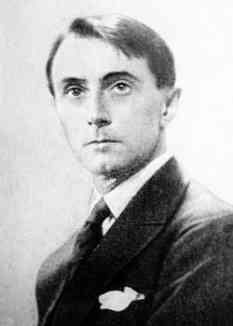 Louis Durey Source: Find a Grave |
|
| Born on 3 March 1891 in
Madrid,
Federico Moreno Torroba
was the son of an organist who taught at the National Conservatory of Music.
Torroba there studied, as well as at the Real Conservatorio de Música.
Though one of the more obscure composers in these histories, Torroba wrote a
load of works for piano, such as 'Apetits Pas' in 1913. He also composed
numerously for guitar, such as 'La Ajorca de Oro' in 1918.
Among Torroba's most important musical associations was guitarist,
Andrés Segovia, who added
Torroba's' 'Sonatina' in A of 1924 to his repertoire that year
[live performances by Polivios;
Ana Vidovic;
Joakim Zelmerlööw].
Though he also composed operas and ballets, most of Torroba's works for
stage were zarzuelas, a Spanish form of opera. His first of eleven listed at
Wikipedia arrived in 1925 as 'La Mesonera de Tordesillas'. Another work for
solo guitar arrived in 1926 per 'Nocturno' [interpretation by Andrés Segovia;
live performance by Matt Kaplan;
score]. His
'Suite Castellana' ('Castilian Suite') for solo guitar also arrived in 1926,
that consisting of three movements: 'Fandanguillo', 'Arada' and 'Danza'
[interpretation by Enno Voorhorst;
live performances by Pepe Romero 1,
2;
Victor Snuverink;
score: 1,
2;
arranged for marimba by David Wingerson].
His fourth zarzuela, the romantic 'Luisa Fernanda', premiered at the Teatro
Calderón in Madrid on 26 March 1932
[1,
2,
3,
4;
live w musical direction by Antoni Ros Marba].
Included in the second act of 'Luisa Fernanda'' is the popular 'Mazurka of
the Umbrellas' [interpretation
by the Orquestra de Conciertos de Madrid;
live performance by
the Jarvis Conservatory 30 Piece Orchestra. Into the thirties Torroba began
to manage opera houses. He would at one time run four at once, including his own.
Also recording as a conductor, 'Mosaico Andaluz' saw issue by Hispavox in
'58 on 45 rpm. Torroba wrote the soundtrack for 'El mejor tesoro' premiering
in B&W in 1966. During the seventies he applied himself to multiple works
for guitar with orchestra and guitar quartets. Among his last compositions was his sonatina for
guitar and orchestra, 'Trianera', of 1980
[interpretation by Dagoberto Linhares;
live performance by Irina Kulikova].
Torroba is believed to have written a version of 'Trianera' for four guitars
and castanets as well [interpretation by Los Romeros].
Also arriving in 1980 was 'Fantasía Castellana' ('Castilian Fantasy') for
piano and orchestra [fragment of Humberto Quagliata
backed by the Valencia Municipal Orchestra conducted by Manuel Galduf]. Torroba
died in Madrid on 12 Sep 1982. References: 1,
2.
Compositions: English,
German;
alphabetical;
by genre.
Editions & scores (Germany): 1,
2.
Books & documents: France;
international: 1,
2.
Sheet music.
Audio: 1,
2,
3,
4,
5,
6,
7.
Recordings of: discos: 1,
2,
3,
4,
5;
select: 'Guitar Music · 1' by Ana Vidović:
reviews: 1,
2.
IMDb.
Bibliography: 'Federico Moreno Torroba: A Musical Life in Three Acts' by Clark & Krause (Oxford U Press 2013):
1,
2;
'The Life and Works of Federico Moreno Torroba' by William Krause.
Other profiles:
Catalan;
Czech;
Deutsch;
English: 1,
2;
Espanol;
Francais;
Norwegian;
Polish.
Federico Torroba Concerto de Castilla Movement 1 1960 Recorded 1962Adagio: Allegro moderato Orquestra de Conciertos de Madrid Jesús Arámbarr Guitar: Renata Tarragó Concerto de Castilla Movement 2 1960 Recorded 1962Andante Orquestra de Conciertos de Madrid Jesús Arámbarri Guitar: Renata Tarragó Concerto de Castilla Movement 3 1960 Recorded 1962Andante: Allegro moderato Orquestra de Conciertos de Madrid Jesús Arámbarri Guitar: Renata Tarragó 1932 Zarzuela Performance unknown 1976? Guitar: Álex Sánchez 1924 Guitar: Edel Muñoz 1926 1: Fandanguillo 2: Arada 3: Danza Guitar: Pepe Romero |
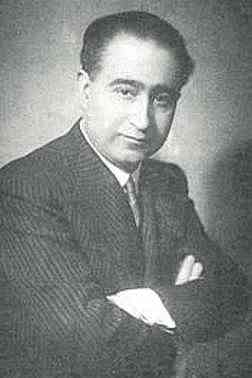 Federico Torroba Source: Maestros of the Guitar |
|
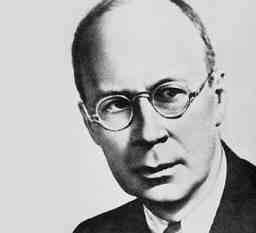 Sergey Prokofiev Source: Britannica |
Born on 27 April 1891 in Sontsovka in what is now eastern
Ukraine,
Sergei Sergeyevich Prokofiev
(Сергей Прокофьев)
had an agronomist for a father. Learning piano from his mother, he began
experimenting with composition at age five. He wrote the libretto to his
first opera, 'The Giant', at age nine, his mother helping him with the
music [1,
2].
Come 'Bagatelle No.1' ('Багатель No.1') in 1901 nad 'Bagatelle No.2' in
1902. Prokofiev's first series of five of 'Little Songs' ('Песенки') arrived
in 1902 along w his first symphony (Симфония) in G major (WoO). Beginning formal studies in 1902,
he entered the Saint Petersburg Conservatory in 1904. Prokofiev gave his
first professional performances at age seventeen for the St Petersburg
Evenings of Contemporary Music. He had assigned his Opus 1 to 'Piano Sonata No.1' in F minor composed in
1907, revised in 1909, published in 1911 by Jurgenson. Prokofiev performed its
premiere on 6 March 1910 in Moscow [*;
interpretations w scores by Boris Berman
or
Bernd Glemser;
live performance by Melanie Chae]. Prokofiev was a revolutionary
composer from the begin, a delight to modernists all the more because he
left pianos smoking when he performed. He completed his 'Piano Concert No.1'
in D-flat major Op 10
in 1912, performing it in Moscow on 25 July w conducting by Konstantin Saradzhev. His performance of 'Piano Concerto No.1' a
couple years later at his graduation concert on 18 May
1914 at the Saint Petersburg Conservatory won him an
Anton Rubinstein
Prize
and a Schroeder [1,
2,
3] grand piano
[Wikipedia bio; see also 1,
2,
3;
piano w score by Yevgeny Kissin backed by the Berliner Philharmoniker w Claudio Abbado;
score].
A victory of another sort arrived on 29 May 1914 when Prokofiev, a chess
master, dunked Cuban master, José Capablanca [1,
2,
3,
4,
5,
6], in St. Petersburg
[moves;
Prokofiev and chess: 1,
2,
3,
4,
5]. Prokofiev had toured to Paris and London before graduating
from the Conservatory, after which he returned to London to begin work with
impresario, Sergei Diaghilev, on his first ballets. During World War I Prokofiev enrolled into the
Conservatory again, studying organ to avoid conscription into the army.
He had begun to write 'Violin Concerto No.1' in D major Op 19 in
1915, put it away for finishing in 1917, though didn't premiere it until 18 Oct
1923 at the Paris Opera w violinist, Marcel Darrieux, backed by the Paris
Opera Orchestra conducted by Serge Koussevitzky
[1,
2,
3,
4,
5,
6;
audio w score of Julia Fischer;
live performances by Hilary Hahn: 1,
2].
The Russian Revolution of 1917 had flared up on 8 March to endure until 6 June
1923 [1,
2,
3,
4,
5,
6].
Prokofiev completed his 'Symphony No.1' in D major Op 25 on 10 Sep 1917, intentionally classical
after
Haydn and
Mozart, thusly named 'The Classical'. It premiered the next year
in Petrograd on 21 April conducted by Prokofiev
[1,
2,
3,
4,
5,
6,
7;
live performances by the Orchestral Academy of the Czech Philharmonic w Ondřej Vrabec or the Israel Chamber Orchestra w
Ariel Zuckermann].
(St. Petersburg was named Petrograd from 1914 to 1924, Leningrad from '24 to
'91.)
Completing 'Piano Sonata No.3' Op 28 in 1917, its premiere arrived on 13
April 1918 (prior to 'The Classical") during a festival of Prokofiev's music held by the St. Petersburg
Conservatory [1,
2;
interpretations w scores by Boris Berman or
Andrei Gavrilov;
live performances by Tiffany Poon, or
Daniil Trifonov;
score]. Prokofiev visited America in 1918,
beginning in San Francisco. Not so well received in the United States as in
Europe, he left for Paris in 1920. Prokofiev finished his 'Piano Concerto
No.3 in C minor Op 26 in 1921 to premiere it in Chicago on 16 December
w the Chicago Symphony Orchestra conducted by Frederick Stock
[1,
2,
3,
4;
interpretation w score by Gary Graffman
backed by the Cleveland Orchestra w George Szell conducting;
live performances by
Martha Argerich backed by the Singapore Symphony Orchestra w Darío Alejandro Ntaca conducting or
Yuja Wang backed by the Royal Concertgebouw Orchestra conducted by Daniele Gatti]. In 1922
Prokofiev
moved to the Bavarian Alps with his mother before his marriage in 1923 to
Spanish singer, Lina Prokofiev [nee Carolina Codina: 1,
2,
3,
4,
5,
6].
Returning to Paris, Prokofiev
became a Christian Scientist in 1924 [*; Christian Science: 1,
2,
3,
4,
5; Mary Baker Eddy: 1,
2,
3,
4,
5,
6,
7].
In 1927 Prokofiev toured the Soviet Union. He premiered his opera,
'The Gambler' ('Игрок') Op 24, in 1929. He had long since written the score
for piano in 1915-16 and completed its orchestration in Jan 1917
[1,
2,
3,
4,
5;
Mariinsky Theatre directed by Laurent Gentot]. In 1930
Prokofiev toured the States
again. He made his first recording in
June
1932 for HMV with the London Symphony Orchestra, that his 'Piano Concerto No.3' Op
26 [audio]. In 1933
he composed the score to the Soviet film, 'Lieutenant Kijé' ('Поручик
Киже'). As the primary purpose of film scores is to assist a visual rather
than musical spectacle, music in soundtracks were (are) often not up to par
as works of music in themselves. Thus they often came with suites more
satisfactory as musical works. Likewise, Prokofiev also composed the
'Lieutenant Kijé Suite' Op 60 [1,
2,
3;
interpretation by Chicago Symphony Orchestra w Claudio Abbado or
the Slovak State Philharmonic Orchestra w Andrew Mogrelia;
live performance by the Boston Civic Symphony w Konstantin Dobroykov;
score: 1,
2]. Settling in
Moscow in 1936, he that year premiered what is likely his most famous work,
his classical symphonic poem for children, 'Peter and the Wolf' Op 67, at the Nezlobin
Theatre in Moscow on 2 May [1,
2,
3,
4,
5,
6;
narration by David Bowie,
Itzhak Perlman
or
Bramwell Tovey (live)].
In 1937 Prokofiev defeated
chess master and violinist, David Oistrakh
[1,
2;
moves].
Come World War II on 1 September 1939. Prokofiev was yet able to premiere
'Piano Sonata No.6' in A major Op 82 in Moscow on 8 April 1940
[1,
2,
3;
interpretation by Nikolai Lugansky or
Sviatoslav Richter;
live performance by Ilya Rashkovskiy;
score]. The German siege of Moscow in 1941 prompted the evacuation of Prokofiev and
other composers eastward to the Caucasus, his wife, Lina, and two sons
choosing not to join him. He there composed his symphonic suite, 'The Year
1941' Op 90 toward its premiere on 21 Jan 1943 in Sverdlovsk (now
Yekaterinburg) [interpretation by the São Paulo Symphony Orchestra w Marin Alsop or St. Petersburg State Academic S O w
Alexander Titov].
Also composed in the Caucasus in 1941 was the opera, 'War and Peace' Op 91,
after the eponymous 1869 novel by Tolstoy. That eventually premiered after
the War at the Maly Theatre in Leningrad on 12 June 1946
[1,
2,
3;
live performance].
Also arriving from the Caucasus in 1941 was 'String Quartet No. 2' in F
major Op 92 first performed in Moscow by the Beethoven Quartet on 5
September 1942 [1,
2,
3;
interpretations by the Coull Quartet,
the Escher String Quartet,
the Pacifica Quartet,
the
Pavel Haas Quartet,
the
State Borodin Quartet]. Composing in the Soviet
Union presented Prokofiev the problem of writing music to the greater glory
of a Stalin he didn't especially like. His first of six
Stalin Prizes arrived in 1943
for 'Sonata No.7' ('Stalingrad') Op 83 first performed on 18 January 1943 in
Moscow by Sviatoslav Richter [1,
2,
3;
interpretations by Maurizio Pollini,
Sviatoslav Richter ou
Grigori Sokolov;
score].
On 30 December 1944 Prokofiev premiered 'Piano Sonata No.8' Op 84 in Moscow
[1,
2,
3,
4,
5;
interpretations w scores by Vladimir Ashkenazy and
Boris Berman; live performance by
Evgeny Kissin].
WW II drawn to its close in both theaters as of September 1945, come Prokofiev's ballet, 'Cinderella' Op 87, to the Bolshoi Theatre in
Moscow on 21 November 1945
[1,
2;
interpretation by the USSR Radio & TV Symphony Orchestra w Gennadi Rozhdestvensky;
score].
Though the War which Prokofiev weathered well saw him composing more
to his liking than before, he paid the price when in 1948 the Politburo
banned eight of his modernistic works. Those included three works
mentioned above ('The Year 1941', 'Piano Sonata No.6', 'Piano Sonata No.8'),
'Thoughts' Op 62 of 1933-34, 'Ballad of an Unknown Boy' Op 93 of 1942-43,
'Ode to the End of the War' Op 105 of 1945, his festive poem, 'Thirty Years'
Op 113, of 1947 and a cantata. Prokofiev's wife, Lina, had meanwhile fared less
well. Arrested for
espionage on 20 February 1948 upon having attempted to send money to her mother in Spain,
she was
released in 1953 upon Stalin's death, eventually leaving the Soviet Union in 1974. In
the meantime, Prokofiev had written his final compositions, notably
'Symphony No.7' in C-sharp minor Op 131. premiering on 1 October 1952 at the
Trade Union Hall of Columns in Moscow by the All-Union Radio Orchestra
conducted by Samuil Samosud, that was awarded a posthumous Lenin Prize in
1957 [1,
2,
3,
4,
5;
interpretation by the New York Philharmonic w Mstislav Rostropovich;
live performance by the London Symphony Orchestra w Valery Gergiev].
Leaving multiple late works incomplete, Prokofiev died in Moscow on the same
day as Stalin on March 5, 1953 [obit]. Having worked ill for the last eight years,
the cause of his death is generally given as cerebral hemorrhage. Prokofiev
had written largely orchestral and
piano works. He also composed a
strong number of operas, ballets and film scores in addition to pieces for
chamber and voice along w a few marches. He remains one of Russia's greatest composers
both overall and as a modernist. References: 1,
2,
3,
4.
Compositions:
alphabetical;
by genre: 1,
2,
3,
4,
5,
Espanol,
Russian;
by Opus: 1,
2,
3,
1907-32,
1933-52,
Russian;
concertos: 1,
2;
piano sonatas;
sonatas;
symphonies: 1,
2.
Song texts: 1,
2.
Editions & scores.
Books & documents: Canada;
France;
United States;
international: 1,
2.
Collections: Columbia University.
Sheet music.
Audio: 1,
2,
3,
4,
5,
6,
7,
8,
9.
Recordings of: discos: 1,
2,
3,
4;
select: 'Peter and the Wolf': Sergei Prokofiev Foundation:
1,
2,
3,
4;
'String Quartets Nos. 1 & 2' by the Aurora String Quartet:
review;
''Symphony No.5' | 'The Year 1941'' by the São Paulo Symphony Orchestra w Marin Alsop.
IMDb.
Documentaries: 'Гении' ('Geniuses') directed by Galina Ogurnaya 2003;
unknown.
Film interview 1944.
Further reading by source: Anna Galayda;
Ian MacDonald;
Project 1917 (Russian);
RadioBlago (Russian).
Further reading by topic: analysis: compositional vision;
musical education;
Stalin and: 1,
2;
trivia.
See also: iconography;
the Sergei Prokofiev Foundation;
the S.S. Prokofiev Museum.
Bibliography:
'Leben und Wichtige Werke: Portfolio-Arbeit' by Elias Häfele (BoD Books on Demand 2019).
Other profiles: English: encyclopedic: 1,
2,
3,
4,
5,
6;
musical: 1,
2,
3,
4,
5,
6;
Espanol;
русском: 1,
2,
3,
4.
See also Prokofiev's 'Concerto No.2' under
Eugene Ormandy. Sergey Prokofiev 1944 Op 87 Ballet 3 acts USSR Radio & TV S & O Gennadi Rozhdestvensky 1911–13 Op 13 Opera 1 act Rostov-on-Don State Musical Theatre C & O Maddalena: Ekaterina Krasnova 1945 Op 105 UNT Wind Symphony & Harp Ensemble Eugene Corporon 1936 Op 67 Symphonic poem 15 sections Philadelphia Orchestra/Eugene Ormandy Narration: David Bowie 1917-21 Op 26 3 movements Russian National Orchestra Andrey Rubtsov Piano: Daniil Trifonov 1907 Revised 1917 Op 28 Allegro tempesto Hungarian State Symphony Orchestra Piano: Tami Lin 1939–40 Op 82 4 movements Piano: Yuja Wang Piano Sonata 7 in B flat major 1939–42 Op 83 3 movementsPiano: Glenn Gould 1941 Op 92 3 movements Emerson String Quartet Eugeniy Drucker 'The Classical' 1916–17 Op 25 4 movements Dresdner Philharmonie Kurt Masur 1933–8 Op 125 3 movements Orchestra of the University of Music Nicolás Pasquet Cello: Emanuel Graf 1935 Op 63 3 movements New Philharmonia Orchestra Conducting: Rafael Frühbeck de Burgos Violin: Nathan Milstein 1946 Op 80 4 movements Violin: Jana Ozolina Piano: Agnese Eglina 1915–17 Op 22 20 piano pieces Piano: Ilan Tsikman |
|
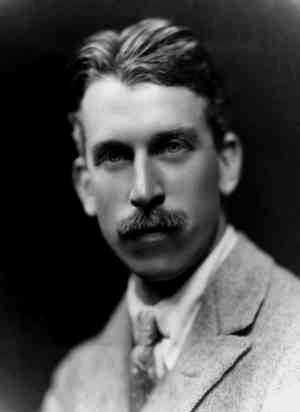 Arthur Bliss 1922 Source: University of Cambridge |
Born on 2 August 1891 in London to an American businessman
and English mother who died in 1895,
Arthur Bliss
was to become one of Great Britain's finest romantic composers. He was raised with
two brothers toward attending Pembroke College, then Cambridge where he
studied antiquities (Greece, Rome) while training under composer, Charles
Wood. He had composed 'Trio for Piano, Clarinet and Cello' as early as 1909. 'May Zeeh' for
piano F 142 arrived in 1910. "F" numbering in Bliss is per the thematic
'Catalogue of the Complete Works' by Lewis Foreman (Novello 1980). Foreman
begins Bliss with ballets, F 1 being 'Adam Zero' of 1946 [below]. F numbers
have no chronological bearing in this column. As well, events which occur
during the same year in the narrative below aren't necessarily chronological
by the order mentioned. In 1912 Bliss
wrote 'Intermezzo' F 129 and 'Suite' F 147 for piano. 'String Quartet
in A Major' F 23 arrived in 1913 [*;
interpretation by the Maggini Quartet: 1,
2].
'Valse Fantastiques' for piano F 152 also arrived in 1913, the year Bliss graduated
from Cambridge to attend the Royal Academy of Music in London. But World War
I (1914-18) intervened, whence he joined the British Army as an officer.
Bliss had set Alfred Houseman's 'Tis time, I think, by Wenlock Town' F 181 to voice and piano in 1914
[interpretation by Toby Spence (tenor) w Kathron Sturrock (piano)].
'Violin Sonata' F 192 also arrived in 1914, though was left incomplete
[interpretation by Tasmin Little (violin) w Piers Lane (piano)]. 'Piano Quartet in A Minor'
F 18 arrived in 1915 [interpretation by Chamber Domaine;
live performance by Chamber Domaine: 1/3,
2/3,
3/3]. 'The Hammers' for voice and piano
F 173 also surfaced
in 1915. Come 'Fugue for String Quartet' F 17 in 1916 along w 'Pastoral' for
clarinet and piano F 92. The latter is the only composition preceding 1918
that Bliss found acceptable as a mature work [interpretation by John Bradbury (clarinet) w James Cryer (piano)]. 'The Tramps' for voice and piano
F 182 also emerged in 1916. World War I coming to a close in 1918, Bliss
that year became a Roman Catholic, also the year by which Bliss demarcated
juvenile from mature works beginning w 'Madam Noy' for voice and ensemble F 160 [interpretation by Jennifer Vyvyan w the Wigmore Ensemble; live performance by Irene Maessen
w the Ebony Ensemble]. Come 'Piano Quintet' F 22 in 1919 along with
incidental music for 'As You Like It' F 85 and 'Rhapsody' for voice and ensemble
F 161. He also that year conducted Pergolesi's opera, 'La Serva Padrona', at
the Lyric Theatre [*].
Another work of incidental music arrived in 1924 per 'King Solomon' F 86. In
1925 Bliss married one Gertrude (Trudy) Hoffmann in California during his first visit to the United
States. Come his pastoral, 'Lie Strewn the White Flocks' F 33 in 1928. His
'Viola Sonata' F 91 arrived in 1933
[interpretation by Roger Chase (viola) w Michiko Otaki (piano);
live performance by Matan Noussimovitch (viola) w Tal-Haim Samnon (piano)].
Of Bliss' numerous film scores, his first is thought to have been for
'Things to Come' premiering on 20 February 1936, that based on HG Wells'
1933 novel, 'The Shape of Things to Come' [1,
2]. Anticipating that his music would
get sacrificed to the primary needs of the film, Bliss also wrote the
'Things to Come Suite' to greater musical satisfaction as a whole,
premiering that for the BBC [founded 1922: 1,
2] in September of 1935 prior to the film's release
[*].
Bliss also recorded it in '35 for Decca [*;
London Symphony Orchestra conducted by
Arthur Bliss].
His fourth of ten ballets was 'Checkmate' F 2 premiering on 15 June 1937 at
the Théâtre des Champs-Élysées in Paris, that w characters as pieces on a
chessboard [1,
2;
interpretation by the English Northern Philharmonia w David Lloyd-Jones: 1,
2].
Bliss attended the premiere of 'Piano Concerto in
B Flat' F 108 at the World's Fair in New York in June of '39 [*;
interpretation by Peter Donohoe backed by the Royal Scottish National Orchestra w David Lloyd-Jones]. He was vacationing
afterward in California when World War II ignited. He thought to stay in America
to teach at Berkeley, but instead left his family in CA and returned to
Great Britain to work for the BBC. His last composition for a period during the
War was 'String Quartet No.1' in B Flat major F 25 in 1941
[interpretation by the Maggini Quartet: 1,
2]. Upon his family's return to England in 1944 he
resumed composing such as the ballet 'Miracle in the Gorbals' (slum in
Glasgow) [1,
2,
3] to which he added a Suite.
Bliss' 'Birthday Fanfare for Henry Wood' F 57 arrived in 1944 along with
'Peace Fanfare for Children' F 75. Come his march,
'The Phoenix: Homage to France' F 94 in August 1944 to premiere in Paris on
11 March 1945. The ballet, 'Adam Zero'
F 1, premiered at the Royal Opera House,
Covent Garden, on 8 April 1946 [Suite: *;
interpretation by
the Royal Liverpool P O w Vernon Handley]. Bliss was knighted in 1950,
then appointed aster of the Queen's Music in 1953. His duties in that post
included such as ceremonial music and musical delegations to the Soviet
Union. Alfredo Campoli premiered
Bliss' 'Violin Concerto' F 111 of 1953 in
1955. Come Bliss' ballet, 'The Lady of Shallot' F 5, in '58 [BBC Symphony Orchestra
conducted by Sir Arthur Bliss].
Come Bliss' third and last opera, 'Tobias and the Angel' F 98, in 1960 [1,
2].
Bliss was above eighty years old when he composed his choral works, 'Shield
of Faith' F 22 [*;
audio] and 'Sing, Mortals' F 53.
Also appearing in '74 were his fanfare, 'Lancaster Prelude' F 73, and
'Wedding Suite' for piano F 153. Bliss died at his home in London on 27 March of 1975, having
written 'Spirit of the Age' for brass ensemble F 130
for television that year. References: 1,
2,
3,
4.
Compositions: alphabetical:
1,
2;
by genre: 1,
2,
3,
4,
5.
Song texts.
Authorship: 'Bliss on Music' (Oxford U Press 1991).
Editions & scores: Canada,
France.
Books & documents: France;
international: 1,
2.
Audio: 1,
2,
3,
4,
5,
6.
Recordings of: discographies: 1,
2,
3,
4;
select: ''Checkmate' | 'Mêlée Fantasque'' by the Royal Scottish National Orchestra w David Lloyd-Jones:
1,
2,
review;
''A Colour Symphony' | 'Adam Zero'': *,
reviews: 1,
2;
'The Complete Piano Music of Sir Arthur Bliss Volume 1' by Mark Bebbington (piano):
1,
2,
3;
'The Complete Piano Music of Sir Arthur Bliss Volume 2' by Mark Bebbington (piano):
1,
2,
3,
4;
'The Sacred Choral Music' by the Collegiate Singers and the New London Orchestra directed by Andrew Millinger w Richard Moorhouse at organ:
*,
review.
Further reading by Roderic Dunnett: 1,
2,
3.
See also:
the Arthur Bliss Archive;
the Arthur Bliss Society.
Bibliography.
Other profiles: 1,
2,
3.
Per
below, the original author of 'God Save the Queen' is unclear. It may have
developed through a string of musicians as much as it might have been
composed by any singular person. The period, however, was the early
17th century and things would seem to point to Scotland. It was first
published in 1744\ in the 'Thesaurus Musicus' and became Great Britain's
National Anthem during the early nineteenth century [1,
2].
Arthur Bliss 1946 F 1 Ballet English Northern Philharmonia Director: David Lloyd-Jones 1970 F 107 English Northern Philharmonia Director: David Lloyd-Jones Violoncello: Tim Hugh 1937 F 2 Ballet Royal Scottish National Orchestra Director: David Lloyd-Jones 1921/1932 F 106 English Northern Philharmonia Director: David Lloyd-Jones 1969 This recording: 1972 F 29 London Philharmonic Royal Choral Society 1958 F 5 Ballet 1918 F 160 For voice Ebony Ensemble Conducting: Michel Havenith Soprano: Irene Maessen 1910 F 142 Piano: Mark Bebbington 1945 F 121 Film score 1972 F 122 Bournemouth Symphony Orchestra Director: David Lloyd-Jones 1935 F 123 English Northern Philharmonia Director: David Lloyd-Jones 1916 For clarinet & piano Clarinet: John Diamanti Piano: Francesco Maria Moncher 'Poco adagio e espres' 1915 F 18 3 movements This Filmed performance: 2007 Chamber Domaine 1933 F 91 Filmed performance Piano: Tal-Haim Samnon Viola: Matan Noussimovitch 1915 F 23 1934 F 131 Film score London Symphony Orchestra Conducting: Arthur Bliss 1920 F 133 English Northern Philharmonia Director: David Lloyd-Jones 'Allegretto Amabile' 1913 4 movements F 152 Piano: Mark Bebbington |
|
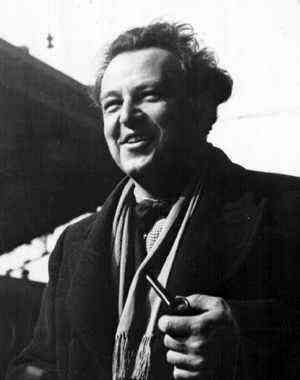 Arthur Honegger Source: Bach Cantatas |
Born to Swiss parents in Le Havre, France, on 10
March
1892,
Arthur
Honegger
(pronunciation) studied harmony and violin as
a youth in Le Havre. His H I is assigned to an opera, 'Philippa', written as
early as 1903. "H" numbering in Honegger is per Harry Halbreich's 'L'Oeuvre
d'Arthur Honegger' (Fayard 1994). Juvenile works are catalogued w Roman
numerals through 'Sonatas' VI consisting of a set of six in 1908. His H 1 is
assigned to 'Pieces' for piano as of 1910 consisting of 'Scherzo',
'Humoresque' and 'Adagio'. The date indicates that it was composed while he
was a student at the Zurich Conservatory where he attended for a couple of years until enrolling into the Paris
Conservatoire in 1911. The earliest audio sample of music by Honegger that
I've discovered is provided by Classical Archives, that his 'Trio' in F
minor H 6 for violin, cello, and piano of 1914 [interpretation by the Prospero
Trio]. He completed the ballet, 'Le dit des jeux du monde'
H 19 the year that he graduated from the Conservatoire in 1918
[*;
interpretation by the Orchestre Philharmonique du Luxembourg w Arturo Tamayo]. In 1920 he was named one of
Les Six, a group of
avant-garde composers who rallied about
Éric Satie [1,
2,
3,
4,
5]. Les Six were named after
The Five, an earlier group of Russian romantic composers whose interest
had been a breakaway from conservatory standards. The work that brought
Honegger's
career about was 'Le Roi David', an oratorio/psalm composed in two months in
1921 as incidental music to a play by René Morax, that premiering on 21
June [1,
2,
3,
4;
live performances: 1,
2,
3].
Honegger's is a major name as it comes to the application of classical music to
early films. His first for Abel Gance was for the silent film, 'La Roue'
('The Wheel') (H 44), premiering on 17 February 1923 w its main character a
railway engineer [1,
2,
3,
4].
His modernistic symphonic poem about a steam locomotive, 'Pacific 231' H 53
was published in 1924 [1,
2,
3;
interpretations w scores by
the Utah Symphony Orchestra w Maurice Abravanel &
the Danish National Radio Orchestra w Neeme Jarvi].
'Pacific 231' is the first 'Mouvement Symphonique'
of three, the others arriving in 1928 and '33 per below. Russian director, Mikhail Tsekhanovsky, later used
'Pacific 231'
in a 1931 film.
Come 'Pacific 231' directed by
Jean Mitry in 1949
[film:
Part 1,
Part 2].
Honegger's incidental music for 'Judith' came to H 57a. 'Judith' 57b got
assigned to his fifth of six operas that was 'Judith' first performed in Monte
Carlo on 2 Feb 1925 w libretto by René Morax
[1,
2;
interpretation by the Coro e Orchestra della Fondazione Gulkenkian w Michel Corboz].
'Judith' 57c of 1927 was an oratorio. Honegger wrote the score to accompany Gance's epic silent spectacle of
five hours, 'Napoleon' [1,
2],
in 1927. That premiered in Paris on 7 April w the Suite (H
64) published that year. 'Napoleon' included the seventh of eight pieces, 'Les
Ombres' ('Les Shadows') [audio].
The symphonic poem, 'Rugby' H 67, arrived in August to Sep of 1928
[1,
2,
3,
4;
interpretations by the Hague Philharmonic Orchestra w Ernest Bour &
the Orchestre de Chambre de la Radiodifusion-Television Française w Michel Plasson]. 'Rugby'
is the second 'Mouvement Symphonique' of three introduced above per 'Pacific
231'. Honegger is thought to have conducted a recording of 'Rugby' for Decca
in 1929, perhaps '30. His 'Cello Concerto' in C major H 72 saw its
first performance in Boston on 17 Feb 1930 [1,
2,
3;
cello by Mstislav Rostropovich
backed by the London Symphony Orchestra w Kent Nagano]. Honegger's third
'Mouvement Symphonique', the least regarded of the three, arrived to no
more descriptive a title than 'No.3' in C♯ minor H 83 in 1933 [interpretation
by the Orchestre National de la Radiodiffusion Française w Georges Tzipine].
Come the score to the film, 'Les Misérables' H 88 premiering on 9 February
1934 [Slovak Radio Symphony Orchestra w Adriano].
Drawn from the 1862 novel by Victor Hugo, the orchestral 'Suite' was assigned to 88a
[Slovak Radio Symphony Orchestra w Adriano].
Come the premiere of 'L'Aiglon' ('The Eagle') at the Opéra de Monte-Carlo on
11 March 1937, that a project w Jacques Ibert who composed the first and
last acts of five [1,
2,
3
; interpretation
by the Choeur & Orchestre Symphonique de Montréal w Kent Nagano]. Upon the Nazi invasion of Paris
Honegger was unable to
flee and joined the French Resistance. His career was otherwise largely
unaffected by the Nazi occupation of Paris begun on 14 June of 1940. He taught composition at the École
Normale de Musique de Paris with German uniforms on the streets and composed
numerously such as
his 'Saluste du Bartas' H 152 in 1941 consisting of six pieces for voice and
piano [interpretations by various: 1,
2].
His ballet, 'Le Mangeur de Rêves' ('The Dream Eater') H 154 appeared in
1941. It was after the War that 'Symphony No.3' ('Symphonie Liturgique') H
186 arrived to its first performance in Zurich on 17 Aug 1946
[1,
2,
3,
4; interpretations by
the Berliner Philharmoniker w Herbert von Karajan &
the Leningrad Philharmonic Orchestra w Yevgeny Mravinsky].
Honegger recorded a version of his third symphony for Decca circa 1947 that
won the French Grand Prix du Disque in 1949
[audio].
Come his 'Romance' for flute and piano H 211 in 1953 toward publishing in 1954
[live performance by Leonard Garrison (flute) w Roger McVey (piano)].
That was followed by Honegger's final composition the same year ('53), 'Une Cantate de Noël'
('A Christmas Cantata') H 212 [*;
live performance
by the Göttinger Stadtkantorei & S O w Bernd Eberhardt]. The Halbreich
directory continues w compositions of earlier or unknown dates to 'La nuit
est si profonde' for voice and orchestra H 222 composed sometime before 1920
and never published. Honegger died of heart attack at his home in
Paris on 27 Nov 1955. Among the stronger French composers, along with other works of the
sort mentioned above he composed several especially for radio such as
'Christopher Columbus' H 140 in 1940 and 'La Rédemption de François Villon'
H 209 in 1951. References: 1,
2,
3,
4.
Compositions:
alphabetical;
by genre: 1,
2,
3,
4;
by Halbreich: 1,
2,
French,
Japanese;
chamber;
film & radio;
lyrical;
operas;
orchestral;
symphonic poems;
symphonies.
Song texts: 1,
2.
Editions & scores: 1,
2.
Books & documents: France: 1,
2;
Switzerland;
United States;
international: 1,
2.
Sheet music.
Audio: 1,
2,
3,
4,
5,
6.
Recordings of: discos: 1,
2,
3,
4,
5,
6,
7;
select: 'Une Cantate de Noël' by the BBC National Orchestra of Wales w Thierry Fischer
1,
2;
'Arthur Honegger: Film Music' Slovak Radio Symphony Orchestra conducted by Adriano:
1,
2;
reviews: 1,
2;
'Arthur Honegger: Symphony No. 3' by the New Zealand Symphony Orchestra w Takuo Yuasa;
review;
'Le Roi David' by the Orchestre de la Cite w
Michel Piquemal;
review;
'Rugby' (Honegger performing Honegger).
IMDb.
Iconography.
Further reading: contemporaries;
film music.
See also Leslie Sprout ('New York Times').
Bibliography:
'I Am a Composer' (St. Martin's Press 1966): such as interviews and quotes by Honegger translated by Wilson Ober Clough & Allan Arthur Willman;
'Rhythmic and Contrapuntal Structures in the Music of Arthur Honegger'
by Keith Waters (Routledge 2019).
Other profiles: English: encyclopedic: 1,
2,
3;
history;
musical: 1,
2,
3,
4;
Finnish;
Francais: 1,
2;
Russian: 1,
2,
3;
Spanish.
Arthur Honegger 1924-17 H 65 Opera Tragedy Choeurs de la RTF/René Alix Orchestre National de France Maurice Le Roux Antigone: Geneviève Serres 'A Christmas Cantata' 1953 H 212 Oratorio Göttinger Stadtkantorei Göttinger Symphonie Orchester Organ: Maria Mokhova Concertino for Piano and Orchestra 1924 H 55 1 movement 3 sectionsOrchestra Sinfonica della Radio di Praga Zdeněk Košler Piano: Boris Krajný 1925 H 57B Opera Mezzosoprano (Judith): Brigitte Balleys C & O della Fondazione Gulkenkian Michel Corboz 1920 H 28 Viola: Karel Spelina Piano: Josef Hala 1941 H 153 For strings Orchestre National de l'ORTF Jacques Houtmann 1950 H 202 3 movements Czech Philharmonic Orchestra Serge Baudo |
|
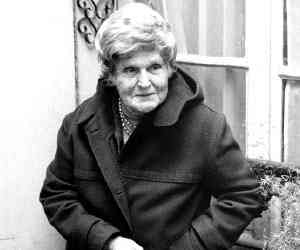 Germaine Tailleferre Source: Classique News |
Born Marcelle Taillefesse
in the southeast suburbs of Paris on 19 April 1892,
Germaine Tailleferre
is the fourth female classical composer to see these histories, preceded by
Kassia (9th century
Constantinople),
Hildegard (12th
century Germany) and
Nadia Boulanger
(five years her senior). Tailleferre changed her name from Taillefesse as a
young woman to distinguish herself from her father who didn't support her
musical ambitions. She played piano and composed short pieces with her
mother while young. Tailleferre won early entry to the Paris Conservatoire
in 1904 and had been a highly distinguished student for several years before
meeting other members of the future
Les Six
in 1913. Wikipedia commences its list of her oeuvre with an 'Impromptu' for
piano in 1909. Tailleferre premiered her piano four-hands, 'Jeux de Plein Air', in 1917
[*;
interpretation by Nicole Carboni w Marc Clinton]. That so impressed
Érik Satie that he invited her to
join his group of avant-garde composers, the Nouveaux Jeunes, which Satie
rather quickly left, the group then redubbed The Six [1,
2,
3,
4,
5].
Exampling her work in the early twenties is 'Le Marchand d’Oiseaux' ('The
Bird Merchant') premiering at the Théâtre des Champs Elysées on 25 May 1923
w libretto by Hélène Perdriat and choreography by Jean Börlin [*;
audio].
In 1926 Tailleferre
married the mentally troubled American artist, Ralph Barton, and moved to Manhattan for a couple of years.
Having returned to France, Tailleferre was pregnant when Barton suggested
abortion by gunshot to the womb in June of '29, adding that she could be treated without
paint. Germaine got the idea, miscarried as she fled and never saw Barton
again, the latter to kill himself in 1931. Not long later in August of '29 Germaine
had finished 'Six Chansons Françaises' [1,
2;
interpretation by Noelle McMurtry (soprano) w Jack Dou (piano);
texts]. The thirties brought her to
remarkable success before forced to flee to Philadelphia upon the outbreak
of World War II. Returning to France in 1946, she enjoyed a flourishing
career, including operas and scores for film and television. In 1976 she
became an accompanist at a children's private school, arthritis giving her
troubles by then. 'Suite Burlesque' of 1980 was among her latest
compositions, another piano four-hands
[interpretations by Nicole Carboni w Marc Clinton * and
Philippe Corre w Edouard Exerjean *;
live performances by the Duo Vela * and
Bengt Forsberg w Oliver Triendl *].
Tailleferre's last composition of a certain date was '20 Lécons de Solfege' for voice and piano in 1982, dying the next
year in Paris on 7 November 1983.
References: 1,
2.
Compositions: 1,
2;
chronological: Catalan,
English,
Espanol,
Picard,
Russian.
Song texts.
Editions & scores: Germany,
Switzerland.
Books & documents: Canada;
France: 1,
2; international:
1,
2.
Audio: 1,
2,
3,
4,
5.
Recordings of: discos: 1,
2,
3;
select: 'String Quartets' by the Leipziger Streichquartett.
IMDb.
Further reading: Tailleferre & Ralph Barton: 1,
2;
Charlotte Saulneron.
See also: Canopé (video).
Bibliography: 'Germaine Tailleferre: A Bio-bibliography' by Robert Shapiro (Greenwood Press 1994).
Other profiles: Catalan;
Czech;
Deutsch;
Dutch;
English: 1,
2,
3,
4;
Finnish;
Francais: 1,
2,
3,
4;
Italian;
Russian;
Spanish: 1,
2,
3.
Germaine Tailleferre Ballade pour piano et orchestre 1926-27Direction: Arthur Benjamin Pianiste: Lamar Crowson Concertino for harp and orchestra 1926-27Direction: Arthur Benjamin Pianiste: Lamar Crowson 1926-27 Direction: Arthur Benjamin Pianiste: Lamar Crowson 1926-27 Direction: Arthur Benjamin Pianiste: Lamar Crowson Pancarte pour une porte d'entrée 1926-27Direction: Arthur Benjamin Pianiste: Lamar Crowson 1926-27 Direction: Arthur Benjamin Pianiste: Lamar Crowson 1926-27 Direction: Arthur Benjamin Pianiste: Lamar Crowson |
|
| Born on 4 Sep 1892 in
Marseilles,
Darius
Milhaud
was a violinist before turning to composition at the Paris Conservatoire in
1909 where he met
Arthur Honegger and
Germaine Tailleferre,
future members of
Les Six [1,
2,
3,
4,
5]. His Op 1 was
two sets of
'Poèmes de Francis Jammes', composed for piano and voice from 1910 to '12.
Milhaud would set numerous texts by Jammes during his career.
His Op 2 was
assigned to '3 Poèmes de Léo Latil' written between 1910 and 1916. Op 3 is
'Violin Sonata No.1' composed in Aix in 1911 toward its first performance in
Paris on 3 May 1913
[IMSLP;
interpretation by the Gran Duo Italiano;
score]. During World War I Milhaud was secretary to dramatist, Paul Claudel, French
ambassador to Brazil at the time. It was while in Rio de Janeiro that he
wrote 'Violin Sonata No.2' Op 40 in 1917 toward its premiere that year in
Rio [IMSLP;
interpretation by Frédéric Pelassy (violin) w Eliane Reyes (piano);
score].
While in Brazil he picked up the
Carnival tune, 'The Bull on the Roof', of
which he composed 'Le Bœuf sur le Toit' Op 58 which translates as 'The Ox on
the Roof'. He premiered that back in Europe at the the Théâtre des
Champs-Élysées in February 1920 [1,
2,
3,
4;
interpretation by the Orchestre de L’Opéra de Lyon w Kent Nagano or
the Ulster Orchestra w Yan-Pascal Tortelier;
live performance by L'Orchestre de Paris w Alondra de la Parra]. The famous Parisian cabaret, Le Bœuf sur
le Toit [1,
2,
3], was named after Milhaud's surrealist [1,
2,
3,
4,
5,
6,
7] ballet.
Excepting
Durey, he collaborated with
Les Six on the ballet, 'Les Mariés
de la Tour Eiffel', premiering at the Théâtre des Champs-Élysées on 18 June
1921 [1,
2; interpretations: 1,
2]. Milhaud visited Harlem in 1922, his
ballet, 'La Création du Monde' Op 81a, incorporating jazz elements. That
premiered at the Théâtre des Champs-Élysées on 25 October 1923
[1,
2,
3,
4,
5,
6,
7,
8;
interpretation by the Prague Symphony Orchestra w Václav Neumann
or
The U.S. Marine Band President's Own].
Earsense has the 'Suite'
81b written for piano and string quartet. Being
Jewish, Milhaud had a good reason to emigrate to the States in 1940, the
year Nazi Germany invaded France. He there landed employment teaching at
Mills College in Oakland, CA. Both jazz pianist,
Dave Brubeck and popular pianist and
vocalist,
Burt Bacharach, studied at Mills beneath Milhaud. He began
teaching at the Paris Conservatoire in 1947, thereafter at Mills and the
Conservatory in alternating years. Come 'Le Globe-Trotter' for piano Op. 358
in 1956 to which he added the orchestral 'Suite' of six movements. He conducted a recording of
the latter for Decca on 17 June 1957 [DAHR; audio].
'Ecoutez Mes Enfants' ('Listen to My Children') for voice and organ Op 359
arrived the same year. He followed that w 'Les Charmes de la Vie' ('Homage to Watteau') for piano
Op 360 in '57 which orchestral 'Suite' of six movements he recorded as conductor on 18 June 1957
[audio: 1,
2].
Milhaud composed a solitary work for guitar in 1957 called 'Segoviana'
[interpretations by Oscar Ghiglia &
various;
live performances by Andrea Caballero &
Steve Cowan].
He died some years later in Geneva, Switzerland, on
22 June 1974 [obit], having composed above 440 works including ballets, operas and
symphonies in particular. He also composed a strong list
of concertantes, chamber works, pieces for keyboard or voice, incidental
music, film scores and radio scores.
References: 1,
2.
Chronologies: 1,
2.
Compositions:
alphabetical: 1,
2;
by genre: 1,
2,
3,
4,
5,
6,
7,
ballets,
operas;
by Opus.
Editions & scores: Germany,
Internet Archive,
Switzerland.
Books & documents: Canada,
international.
Collections: Cleveland Memory.
Audio: 1,
2,
3,
4,
5,
6.
Recordings of: discographies: 1,
2,
3;
select: 'Complete Violin Sonatas | Complete Viola Sonatas' w Mauro Tortorelli at violin and viola w Angela Meluso on piano
*;
'Early String Quartets" by the Fanny Mendelssohn Quartet
*;
'Les Mariés de la Tour Eiffel' by the Erwartung Ensemble w arrangement by Marius Constant and conducting by Bernard Desgraupes
*,
review.
IMDb.
Further reading: Russell Platt
('New Yorker');
Hyejeong Seong (Latin influences).
Bibliography:
'Darius Milhaud' by Paul Collaer w Jane Hohfeld Galante (Springer 1988).
Other profiles: Deutsch: 1,
2;
English: 1,
2,
3,
4,
5;
Finnish;
French: 1,
2;
Italian;
Russian;
Spanish.
Darius Milhaud Concerto 5 for piano and orchestra 1955 Op 346SWR Rundfunkorchester Kaiserlautern Alun Francis Piano: Michael Korstick 1923 Op 81 Orquesta Nacional de Francia Leonard Bernstein Divertissement for wind quintet 1958 Op 299bAfter the film score 'Gauguin' Op 299 The Athena Ensemble 1956 Op 351 For clarinet and piano Clarinet: Andrea Wilger Piano: Nathan Froese Les Six 1921 Ballet Philharmonia Orchestra Geoffrey Simon 1920 Op 58 Ballet Lille National Orchestra Jean-Claude Casadesus 'Rurale' 1961 Op 390 Radio-Sinfonieorchester Basel Alun Francis 'Rurale' 1961 Op 390 Radio-Sinfonieorchester Basel Alun Francis |
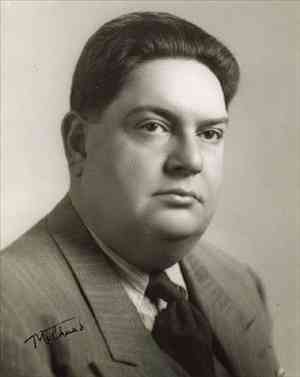 Darius Milhaud Source: All Music |
|
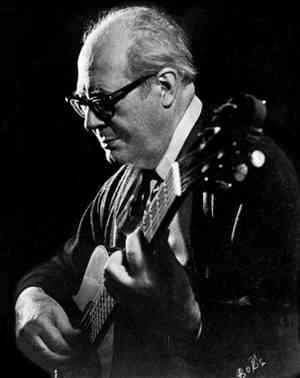 Andres Segovia Source: Bach Cantatas |
Andrés
Segovia
was born on 21 Feb 1893 in Linares, Spain, the latter owning the distinction
of producing fine guitarists like olives. Though neither a conductor nor
well-known as a composer, he requires mention as the
preeminent force during the
early Modern period that has arrived to Spanish classical guitar, ever romantic, as
it is known today. Segovia first played violin but soon came to prefer
guitar. Self-taught, he gave his first public performance in 1909. His first
professional concert arrived in Madrid in 1912, the same year he composed 'Estudio'
for guitar in E major [All Music]. He performed at the Paris Conservatory in
1915 and Barcelona in 1916, making his
first tour abroad in 1919 to South America. Segovia toured to Mexico for the
first time in 1923. Joaquin Turina dedicated his 1925 'Fandanguillo'
Op.36 to Segovia who also transcribed it [IMSLP;
score].
Segovia first arrived to the United States in 1928. From the
early thirties until World War II he largely toured South America. Segovia
arranged and transcribed numerous works by other composers for guitar. One
such was Bach's difficult 'Violin Partita No. 2' ('Chaconne') first performed in 1939
[recording 1959].
After the War he spent a few decades touring Europe and America. In the
meantime he copyrighted '5 Anecdotes' in 1947
[*;
No.1 by Lawrence Johnson,
No.2 by Lawrence Johnson,
No.3 by Pablo Sainz-Villegas;
scores].
From about that time to 1977 Segovia recorded about 40 albums, one of
which was 'Andrés Segovia Plays'
on Decca DL 9734 in 1954. He also appeared in
'The Paris Film' in 1954 in
which he played his rearrangement of
Fernando Sor's 1821
'Variations sobre un Tema de Mozart' (Op 9) [performance;
score]. He composed 'Estudio Sin Luz' ('Study without Light')
in 1955
[live performance by Jan Depreter].
Come his composition, 'Recordando a Deli', in 1960. His album, 'Music for
the Guitar' on Decca DL 10046 saw release in the United States in 1962. Come
'La Guitarra y Yo' ('The Guitar and I')
in 1970 on which Side A is an autobiographical narration w music on Side B.
GSI
has Segovia's final album, 'Reveries' (RCA
ARL1-1602), recorded in 1977 toward release in '78. He was made
an hereditary Marqués by King Juan Carlos I in 1981 before dying in Madrid on 2 June
1987 [obit]. Segovia's largest rival in classical guitar had
arrived during his latter career per the much younger Australian
guitarist, John Williams, born in 1941 [1,
2].
References:1,
2,
3,
4.
Chronology.
Compositions.
Books & documents: France;
international: 1,
2.
Databases: ISNI.
Audio: 1,
2,
3,
4,
5,
6,
7,
8.
Recordings of: discos: 1,
2,
3,
4,
5;
select: 'Original Compositions' by Agustin Maruri;
'Segovia' by Alberto La Rocca;
'The Segovia Sessions' by Scott Tennant: 1,
2,
3.
IMDb.
Documentaries: 'The Song of the Guitar' by Christopher Nupen 1977.
Interview w Jack Pfeiffer 1961.
Further reading by source: ASF Facebook tribute;
Vasilios Avraam;
Antonio Iglesias;
newspapers:
1927-28,
1987;
Alberto Poveda.
Further reading by topic: guitars of: 1,
2,
3.
See also: the Andrés Segovia Archive;
the Andrés Segovia Fundación.
Other profiles: English: encyclopedic: 1,
2,
3;
musical: 1,
2,
3,
4,
5.
Francais;
Italian;
Nynorsk;
Spanish: 1,
2.
Andrés Segovia Composer: Isaac Albéniz Composer: Niccolò Paganini Composer: Isaac Albéniz 1: Prelude for Lute (Bach) 2: Variations on a Theme of Mozart (Sor) 3: Sonatina (Toroba) Live performance Album Released 1975 Composer: Francisco Tàrrega Composer: Isaac Albéniz Recorded 1955 |
|
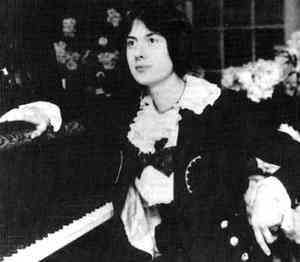 Lili Boulanger Source: L'Art Lyrique Francais |
Born on 21 August 1893 in Paris,
Marie-Juliette Olga Lili Boulanger
was six years younger than her sister, the pedagogue,
Nadia Boulanger.
Lili is the fifth female composer to find these histories of
classical music, preceded by
Kassia (9th century
Constantinople),
Hildegard (12th
century Germany), Lili's sister and
Germaine Tailleferre.
Boulanger's father was composer, Ernest Boulanger.
As
Nadia began studies at the Paris Conservatoire at the early
age of nine, Lili was able to accompany her older sister to classes by the
time she was five. Also receiving formal training, she played piano, violin,
cello and harp. Her first complete composition is thought to be 'La lettre
de mort' for soprano written sometime between 1904 and 1906. Perhaps relevant to the death of
her father in 1900, she may have destroyed it as too young an endeavor, that
one of numerous compositions that disappeared by her hand. in 1911 she wrote
'Nocturne' for violin and piano [1,
2,
interpretation by Lorraine McAslan (violin) w Nigel Clayton (piano);
live performance by Savitri Grier (violin) w Richard Uttley (piano)]. In 1912 she competed
for the Prix de Rome awarded by the Conservatoire, the most prestigious of French
musical scholarships. Unfortunately she collapsed of
ill health during her performance. The next year, however, she became the
first woman to win the prize with her cantata, 'Faust et Hélène'
[1,
2,
3,
4;
interpretation w score by the BBC Philharmonic w Yan Pascal Tortelier;
live performance by the Royal Stockholm
P O w Alan Gilbert]. Lili did
study in Italy per the Prix de Rome but was forced back to Paris, again by
ill health. She wrote 'Cortege' in June of 1914 about a month before the
start of World War I [*;
interpretation by Lorraine McAslan (violin) w (Nigel Clayton (piano);
for solo piano: Keiko Nishizu;
Judith Pfeiffer]. During World War i Boulanger and sister,
Nadia, organized the
Comité Franco-Américain du Conservatoire National de Musique et de
Déclamation, a relief effort for soldiers who were musicians. Lili died,
however, of Crohn's disease at only age 24 on 15 March of 1918 about eight months
before the end of the War, leaving her opera set to a text by Maurice
Maeterlinck, 'La Princesse Maleine', unfinished.
References: 1,
2.
Compositions: Deutsch,
Francais;
alphabetical;
chronological;
by genre: 1,
2,
Catalan,
Deutsch,
Francais.
Editions & scores: 1,
2,
Canada,
France,
Germany.
Books & documents international: 1,
2.
Sheet music.
Audio: 1,
2,
3,
4.
Recordings of: discos: 1,
2,
3,
4;
select: 'Clairières dans le ciel & other works' by the New London Chamber Choir w Martyn Hill (tenor) & Andrew Ball (piano)
*.
Further reading by author: Diana Ambache;
Anya Holland-Barry;
Michael Beek;
Justin Davidson;
Natalie Kazaryan;
Mary Moran;
Heidi Staub.
See also: the Boulanger Initiative
*;
the Centre International Boulanger
*;
the Fondation Internationale Nadia & Lili Boulanger
*.
Iconography.
Biblio: 'Lili Boulanger's 'La Princesse Maleine'' by Annegret Fauser ('Journal of the Royal Musical Association' 1997):
1,
2,
3.
Other profiles: Catalan;
Deutsch;
English: 1,
2;
Francais: 1,
2,
3,
4;
Italian;
русском;
Spanish.
Lili Boulanger 'On a Spring Morning' 1917-18 'Trio Anfalia D’un soir triste (On a Sad Night) 1917-18 Trio Anfalia 1913 CantataFaust: Jacques le Roux Hélène: Marianne Andersen Méphistophélès: Boris Grappe Pour les funérailles d’un soldat 1912-13 Coral Zíper na BocaO S da Unicamp 1916 The Monteverdi Choir London Symphony Orchestra John Eliot Gardiner Psaume 130 (Du fond de l'abîme) 'From the Depths of the Abyss'1914–1917 Chorale Elisabeth Brasseur Orchestre de la Société des Concerts Lamoureux Igor Markevitch Contralto: Oralia Dominguez Tenor: Raymond Amade 1913 USC Thornton Chamber Singers 1911-14 Piano: Ariane Gray Hubert |
|
| Born on 18 Sep 1893 in Sydney,
Arthur
Benjamin
is the first Australian composer to visit these histories. He was raised
after age three in Brisbane where he first played piano in public at age
six. Among the more obscure composers in these histories, he began formal training with a church organist at age nine, then won a
scholarship to the Royal College of Music [1,
2,
3,
4] in London in 1911, there to study
composition, harmony, counterpoint and piano. During World War I he joined
the Officer Training Corps in 1914, took his commission as 2nd Lieutenant in
the infantry, then joined the Royal Flying Corps in 1917. It just so happens
that his plane was shot down in 1918 by future Nazi leader, Hermann Göring,
he also a pilot during the First War. He spent the remainder of his service
as a prisoner of war with
Edgar Bainton,
having been interned since 1914. After the War he returned to Sydney to work
as a piano professor, composing 'Three Impressions für Stimme und
Streichquartett' in 1919. He left for London in 1921 to teach at the Royal College of
Music where he taught a nice list of students
as he continued to focus on chamber works. His first published work, a string quartet
called 'Pastorale Fantasia', appeared
in 1924 to win a Carnegie Prize
[not listed]. 1932 found him conducting the BBC Orchestra, 1935 touring Europe.
It was a visit to the West Indies (not to perform) that resulted in his most
famous work, 'Two
Jamaican Pieces' for two pianos in 1938 consisting of 'Song' and 'Jamaican
Rumba' for which the Jamaican government rewarded him a free barrel of rum
each year as a gesture of thanks. A version for solo piano arrived in 1945.
Benjamin also wrote a version for violin and piano,
and the piece would see numerous arrangements by various for different
instruments
[various versions
of 'Jamaican Rumba']. David Hermann appears to have
a version arranged for viola and recorded by violist,
William Primrose, on
22 May 1945 toward issue on Victor 11-8947
[1,
2]. Hyperion has
Primrose publishing his
arrangement in 1954 [viola by Lawrence Power or
William Primrose;
live performance
by Christopher Lowry (viola) w Shelby Flowers (piano)]. Benjamin had
spent World War II in Vancouver, Canada, becoming conductor of the new
Canadian Broadcasting Corporation Symphony Orchestra in 1941
[CBC: 1,
2]. He also worked for radio in
the United States and Reed College in Portland, Oregon. Largely unaffected by World
War II, it was one his most productive periods. He returned to England after
the War in 1946 to teach at the Royal College of Music. He then fulfilled a
commission from the Australian Broadcasting Corporation [ABC:
1,
2] and toured
his homeland in 1950. Of latter mature works, come his ballet, 'Orlando's Silver Wedding', in 1951
followed in 1953 by 'Harmonica Concerto' which Benjamin composed for harmonica
player, Larry Adler,
who included it in his repertoire and recorded it multiple times
[audio of Adler
1968?]. Benjamin's 'Tombeau de Ravel' of valse-caprices for clarinet and
piano arrived in 1957 [1,
2;
interpretations by Stephen Clark (clarinet) w Shalah Smothers (piano)
* &
Jenny Maclay (clarinet) w Orlando Bass (piano)
*;
live performance
by Julian Hernandez (clarinet) w Jackson Yam (piano)]. Benjamin died on 10 April 1960 of either cancer or hepatitis in
London. He had finished the piano score to his opera, 'Tartuffe', leaving
its orchestration to be completed by Alan Boustead for premiere the same
year. Benjamin had written largely for chamber and orchestra. His dramatic
works include operas and film scores. References: 1,
2.
Compositions: 1,
2;
alphabetical;
by genre;
films.
Books & documents (France).
Song texts.
Audio: 1,
2,
3,
4.
Recordings of: discos: 1,
2,
3,
4,
5;
select: ''Violin Sonatina' | 'Viola Sonata'' by Lawrence Power (viola) w Simon Crawford-Phillips (piano)
*.
IMDb (film).
Further reading: Carolyn Watson (operas);
various.
Other profiles: Deutsch;
English: 1,
2,
3,
4,
5,
6;
Espanol;
French.
Arthur Benjamin Concertino pour piano et orchestre 1926-27Direction: Arthur Benjamin Pianiste: Lamar Crowson 1953 Direction : Morton Gould Harmonica : Larry Adler 1938 For 2 pianos Pianos: Richard Bosworth & Laura Fernando 1934 Film score Conductors: Louis Levy & Wynn Reeves premiere 1938 RCA Victor Symphony Orchestra Izler Solomon |
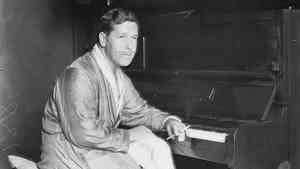
Arthur Benjamin 1929 Source: Sydney Morning Herald |
|
| Born circa 11 Dec 1893 in Kremenchuk, Ukraine (under Imperial Russian Rule until 1917), Jewish
modernistic pianist
Leo Ornstein
studied at the Imperial School of Music in Kiev before enrolling at the St.
Petersburg Conservatory in 1904. He emigrated with his family to NYC's Lower
East Side in 1906, then enrolled in the Institute of Musical Art of which Juilliard [1,
2,
3] was founded in
1906. Sometime in 1911 he composed 'At Twilight' S 2 and 'Six Lyric Fancies'
S 9 [IMSLP;
score,
(alt)]. Ornstein's catalogue is more commonly referred to by "S" rather than
Op number. The IMSLP database by Petrucci is a foremost authority in
classical music on the internet. References to "alt" in this column refer to
Poon Hill Press
coupled to the Ornstein website created by Severo (son) and David (grandson)
Ornstein. Ornstein's professional debut in
1911 in New York was a successful rendition of works by
Bach,
Beethoven,
Chopin and
Schumann. The S directory
begins w '7 Moments Musicaux' in 1913 as 000 deprived of an S designation
[score
(alt)].
S 1 is a 'Nocturne' of unknown date. About 1913 he finished his violent tone cluster, 'Danse
Sauvage' [1,
2;
interpretation by Marc-André Hamelin: 1,
2;
score
(alt)].
DAHR has Ornstein recording early flat discs for Columbia in 1913 consisting
of twelve piano solos beginning with
Edvard Grieg's
1886 'Butterfly' gone down on 10 May toward issue on Columbia A1445.
fJeremy Nicholas has him recording additional tracks in 1914 including
Chopin’s ‘Black Keys’,
Grieg's 'Papillon' and Poldini’s 'Marche Mignonne'. Ornstein
began getting labeled a "futurist"
in 1914 regardless that he himself had nothing to do with that movement, the term of
which would come to more broadly refer to simply modernistic music.
Concerts given in London that year proved his dissonant compositions
controversial enough to include objects thrown at him which weren't flowers
during one of his performances. It isn't known what such accolades Ornstein
received, but it had long since been fairly common for people to pack such
as vegetables to concerts when they suspected they might not like the show.
On undetermined dates in 1916 Ornstein visited New Orleans to experience
some jazz. He also made 25 piano rolls for Ampico, at least one of those
going down in 1916 per
Anton Rubinstein's 1858 'Melody in F' Ampico
450665-H [*;
see also Feustle at UNT]. An enormously popular
performer whilst at once notorious, he packed concert halls with people like
he did compositions w beautiful little surprises until the early
twenties when he began to teach at the Philadelphia Musical Academy. Come his 'Prelude Tragique' for piano S 69 in 1924
[IMSLP;
interpretation w score by Gamma1734;
score
(alt)].
'Prelude Tragique' S 827 for orchestra followed in 1927
[score
(alt)]. Though he continued composing privately,
Ornstein made his
last public performance in the thirties during which he wrote '6 Preludes
for Cello and Piano' S 611 from 1930 to 1939, eventually published in 1975
[IMSLP;
interpretations by Taco Koontra (cello) w Nick de Vente (piano): 1/6 & 2/6,
3/6 & 4/6,
5/6 & 6/6;
score
(alt)].
Anne Midgette at the 'New York Times' has the Ornstein
School of Music founded in Philadelphia by Ornstein and his wife, Pauline,
in 1935, which they ran above a score of years until retiring to New
Hampshire in 1958 before purchasing a mobile home with which to take off to
Texas [David Stearns].
Come 'A Morning in the Woods' for piano S 106a in 1971
[IMSLP;
piano interpretations by Sarah Cahill,
Marthanne Verbit,
Janice Weber w score;
score
(alt)].
Though Ornstein's career slid into wane in the seventies, he emerged in the eighties to
renewed reknown. His final composition was 'Piano
Sonata No.8' S 364a composed in 1990 [IMSLP;
piano by Marc-Andre Hamelin;
score
(alt)].
Having lived throughout the entire 20th century with a six year head start,
Ornstein died of old age at his home on 24 February 2002, 106 years old [Wikipedia; differing obit].
As his birth is uncertain and may have been as early as 1892 or '93,
he might also have lived to as long as 108 ['New York Times'] or 109 ['Do
Not Go Gently': 1,
2].
Ornstein had composed largely for piano, though completed works for strings and
winds as well. References: 1,
2,
3,
4
(alt).
Compositions:
alphabetical;
count by category;
by genre;
published by Poon Hill Press;
by S number: 1,
2,
3
(alt);
solo piano.
Song texts.
Editions & scores: 1,
2.
Books & documents: 1,
2.
Collections: Yale.
Sheet music: 1
(alt),
2
(alt).
Audio: 1,
2,
3
(alt),
4,
5,
6;
music for cello by Nicolas Alvarez (cello) w Keith Kirchoff (piano).
Recordings of: discos: 1,
2,
3
(alt),
4,
5;
piano rolls;
select: 'Complete Works for Cello and Piano' by Joshua Gordon (cello) w Randall Hodgkinson (piano):
1,
2,
notes;
'Futurpiano' w piano by Daniele Lombardi;
'Leo Ornstein' w piano by Marc-André Hamelin [see note 48].
Interviews: 1977 w Vivian Perlis;
1987 w Bruce Duffie.
Iconography.
Further reading:
Nicolas Alvarez (cello music);
Michael Bonney;
'Leo Ornstein: The Man, His Ideas, His Work' by Frederick Martens (Breitkopf & Hartel 1918):
Google Books: 1,
2;
Internet Archive: 1,
2;
Vivian Perlis.
Biblio: 'Leo Ornstein: Modernist Dilemmas, Personal Choices' by Michael Broyles & Denise Von Glahn (Indiana U Press 2007)
*;
'The Futurist Music of Leo Ornstein' by Vivian Perlis ('Notes' 1975).
Other profiles: English: 1,
2,
3,
4;
Espanol;
Finnish;
Francais;
Japanese;
Russian.
Leo Ornstein 1952-76 SO 300a Piano: Arsentiy Kharitonov 1952-76 SO 300a Piano: Arsentiy Kharitonov 1913? S 54 'Wild Men's Dance' Tone cluster piece Piano: Marc-André Hamelin 1923-25 S 824 American Symphony Orchestra Leon Botstein Piano: Alain Feinberg 1971 S 106 Piano: Marthanne Verbit 1952 S 600 Clarinet: Kathy Matasy Piano: Steve Yenger 1918-19? S 6 Tone cluster piece Piano: Francesco Ruocchio 1963 S 155 Tarantelle Piano: William Westney |
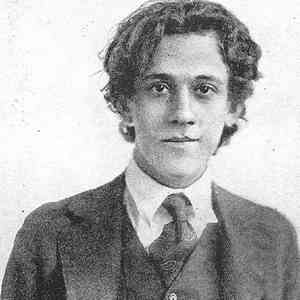 Leo Ornstein Source: Bruce Duffie |
|
| Born on 20 January 1894 in
Rockland, Maine,
Walter Hamor Piston Jr.
is a neglected composer, particularly for the high regard in which his
oeuvre overall is held. He
studied fine art at the Massachusetts Normal Art School until 1916, after
which he made a living playing piano in dance bands and violin in an
orchestra run by Georges Longy. During World War I he joined the U.S. Navy
and played in a Navy band. He entered Harvard in Cambridge, Massachusetts,
to study music in 1920. Upon graduation he studied in Paris from 1924 to
1926, during which period he composed his first work for orchestra which was
premiered by the Boston Symphony Orchestra (BSO) in 1928 but went unpublished. His
first published work also arrived in 1925 per 'Three Pieces for Flute,
Clarinet and Bassoon' [live performance]. He began
teaching at Harvard in 1926, where he remained until retirement in 1960.
Piston began experimenting with twelve-tone form a la
Schoenberg
as early as 1930, using it in his 'Sonata for Flute and Piano'
[interpretation
w score by Goran Marcusson (flute) & Joakim Kallhed (piano)]. Writing
several books on music theory, his first saw publishing in 1933 by E.C.
Schirmer titled 'Principles of Harmonic Analysis'. Piston also employed
twelve-tone in the composition of 'Symphony No.1'
for which premiere on 8 April 1938 he conducted the BSO [interpretation by the Louisville Orchestra conducted by Jorge Mester]. Piston's solitary
work for stage was the ballet, 'The Incredible Flutist', premiered by
Arthur Fiedler and the Boston Pops on 30 May 1938. Its
more popular orchestral 'Suite' was
premiered on 22 Nov 1940 by the Pittsburgh Symphony w Fritz Reiner
[*;
interpretation by the
Boston Civic Symphony directed by Max Hobart]. Norton published his
analytic text, 'Harmony', in 1941 [1,
2].
Piston's well-regarded 'Symphony No.2' saw premiere in Washington D.C. on 5
March 1944 by the National Symphony Orchestra conducted by Hans Kindler
[1,
2;
interpretation by the Seattle S O conducted by Gerard Schwarz;
live performance by the Azusa Pacific University S O conducted by Christopher Russell]. Piston's 'Symphony No.3'
that won him a Pulitzer Prize was premiered on 9
Jan 1948 by the BSO conducted by Serge Koussevitzky [the BSO w
Koussevitzky 1948;
the Eastman-Rochester S O w Howard Hanson 1954;
Harvard-Radcliffe Orchestra conducted by James Yannatos].
Norton published Piston's third volume on music theory, 'Counterpoint', in
1947. His fourth, 'Orchestration', followed in 1955. 'Symphony No.8' saw
premiere by the BSO conducted by Erich Leinsdorf on 5 March 1965
[interpretations by the Louisville Orchestra conducted by
Jorge Meste or
Robert Whitney]. Piston's final composition w a known date is commonly given as his 'Concierto'
for string quartet in 1976 prior to his death on 12 November. Together w works
for orchestra, Piston wrote for chamber along w a nice list of concertantes
for various instruments including piano, cello and violin. References: Wikipedia.
Compositions:
alphabetical;
chronological;
by genre: 1,
2,
3,
4.
Books & documents: Canada,
Germany,
United States,
international: 1,
2.
Audio: 1,
2,
3,
4.
Discographies: 1,
2,
3.
Further reading: analysis by Mark DeVoto (Harvard University 1994). Other profiles: Arabic;
Catalan;
Deutsch;
Dutch;
English: 1,
2,
3,
4;
French. Walter Piston 1930 Flute: Julius Baker Piano: Anthony Makas 1947 3 movements Portland String Quartet 1943 Seattle Symphony Orchestra 1946-47 Eastman-Rochester Symphony Orchestra Howard Hanson 1950 Seattle Symphony Orchestra 1955 Seattle Symphony Orchestra National SO of Ukraine Theodore Kuchar Violin: James Buswell |
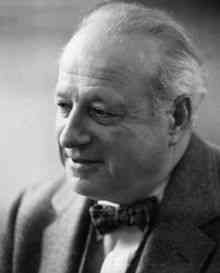 Walter Piston Source: Wikipedia |
|
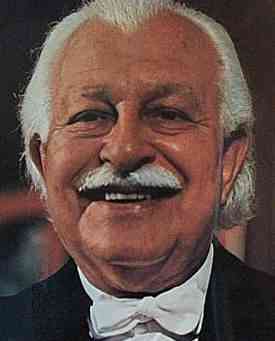 Arthur Fiedler Source: Bach Cantatas |
Born on 17 Dec 1894 in
Boston, Arthur
Fiedler
was of no relation to the earlier German composer and conductor,
Max Fiedler.
Nor was Arthur a composer, though a strong arranger as a conductor from the early modern period
onward. Fiedler is a prominent example of orchestration applied to popular American music of the 20th
century. His father was a violinist in the Boston Symphony Orchestra
[1,
2,
3]. His
mother was a professional pianist. Upon his family moving to Berlin he
studied there at the Royal Academy of Music from 1911 to 1915. He then
returned to Boston and joined the Boston Symphony Orchestra as a violinist,
pianist, organist and percussionist. In 1924 he formed the Boston Sinfonietta, a chamber orchestra
with which he recorded fifteen titles for Victor much later in 1937
[DAHR].
In 1930 he became the eighteenth conductor of the
Boston Pops Orchestra formed in 1885 by Henry Lee Higginson
[1,
2,
3], each to
become instrumental to the other's fame from there onward for decades to
come. Fiedler conducted
Tchaikovsky's '1812 Overture' w the Boston Pops for
the first time in 1930 [*]. DAHR
has Fiedler's first recordings w the Boston Pops going down on 1 July of
1935 beginning w
Schubert's 'Marche Militaire' toward issue on Victor 4314.
Among fourteen other titles recorded that day was Jacob Gade's
'Jalousie' issued on Victor 12160 and 18-0171, that to sell more than a million copies
[audio]. DAHR shows twelve more titles recorded on 2 July followed by 21 more on 3
July. From that time onward
Fiedler and the Boston Pops would make more recordings than any other
orchestra in the world, most for RCA and amounting to more than $50,000,000
in sales. Fiedler also conducted other orchestras during his career, notably
the San Francisco Pops for 26 seasons from 1951 to 1978
[*]. In 1962 he
conducted the Pops for 'Pops Roundup', an album of well-known western titles
arranged by Richard Hayman and Jack Mason. One such was Hayman's medley, 'Pops
Hoedown' [audio].
Starting in 1970 Fiedler conducted the Boston Pops for the 'Evening at the
Pops' television series [1,
2] by the PBS [Public Broadcasting System founded 1969:
1,
2]. Upon Fiedler's death in
1979 John Towner Williams
assumed his position to 1995, followed by Keith Lockhart
to 2004.
Fiedler conducted the opening of Walt Disney World in Bay Lake, Florida,
in 1971. Having contributed to the transformation of orchestral music from classical titles like
Tchaikovsky's '1812 Overture' in 1930 to such as popular television themes like 'Gunsmoke'
in the sixties, Fiedler was back to
Tchaikovsky's
'1812' when the Boston Pops gave its first annual July 4th performance of it
in 1974 [*;
1976
live performance of '1812' by Fiedler and the BP].
Tchaikovsky's '1812' had been composed in 1880 to commemorate the Russian
defeat of Napoleon's invading Grande Armée in 1812 [*]. What had been a
patriotic work in Russia now honored the existence of the United
States as well, Fiedler connecting his celebration with America's defeat of the British in the War of 1812. Be
as may, Fiedler traveled even further from '1812' when he conducted his
final album, the disco oriented 'Saturday Night Fiedler', on June 9 1979
[1,
2;
Side A]. He died of cardiac arrest on 10 July 1979 at his home in Brookline, Massachusetts, while
working on scores. Among his hobbies had been chasing fires to observe
firemen at work. References: 1,
2,
3.
Audio: 1,
2,
3,
4;
Muziekweb: albums,
individual titles.
Recordings of: discos: 1,
2,
3,
4,
5;
select: 'Leroy Anderson Favorites'.
IMDb.
Iconography.
Books & documents international: 1,
2.
Collections: Boston University.
Data bases: 1,
2.
Biblio: 'Arthur Fiedler: Papa, the Pops and Me' by Johanna Fiedler (Doubleday 1994).
Other profiles: English: 1,
2,
3,
4;
Italian;
Russian;
Spanish.
Arthur Fiedler Released 1966 With Chet Atkins 1935 Composer: Jacob Gade 1969 Composer: Jacob Gade Recorded 1959 Composer: George Gershwin Released 1971 1965> Composers: Oscar Hammerstein II Richard Rodgers |
|
| Born on 3 April 1895 in
Florence,
Mario Castelnuovo-Tedesco
(C-T herein)
proved you didn't have to be Spanish to know your way with guitar. His
father was a heavyweight Jewish banker; his mother taught him piano. Composing by age nine,
works without opus begin in 1905 at the MCT website with
'Arie Antiche', 'Notturno' and 'Ninna Nanna' ('Piccola Bérceuse'). He studied piano at the Institute Musicale Cherubini
from 1909 to 1914. During that time 'Cielo di Settembre' for piano became
his Opus 1 in 1910. Its orchestration in 1912 was designated Op 1a which MCT
has premiering five years later in Florence in 1917. Op 2 got assigned to
'Questo fu il carro della morte' for piano written in 1913, published in
1916. Mario also transcribed the works of other composers, beginning w
Robert Schumann's
'Nachstuck' Op 23 No.4 in 1913, which he eventually finished in 1916. Mario's
Op 3 is 'Le Roi Loys' for voice and piano written in 1914, published in
1922. Come 'Ninna Nanna' in G major Op 4 in 1914, published in 1919
[interpretation by Angelo Arciglione].
Mario studied composition beneath
Ildebrando Pizzetti
from 1914 to 1918 and began to come to attention throughout Europe when
pianist and conductor, Alfredo Casella,
started to include his works in his repertoire. I cite C-T's 'Ballata' Op 27
of 1923 pertinent to another more riddling Op 27
mentioned below. His first major
work was his initial opera, 'La Mandragola' Op 20,
premiering in Venice on 4 May 1926 [*]
w libretto by himself after Niccolò Machiavelli's 1524 comedy, 'The
Mandrake'. Mario's version for voice and orchestra,
Op 20a, saw conducting by Paul Bekker in 1928. Castelnuovo-Tedesco
began composing for guitar upon meeting
Andrés Segovia
in 1932, starting w 'Variations à travers les siècles' Op. 71 which he
dedicated to
Segovia
[interpretations by Lorenzo Micheli & Kadzuchito Yamashita;
live performances by Gabriel Bianco,
Leonardo De Marchi,
Antonio Rugolo].
C-T's 'Overture: Il Mercante di Venezia' Op 76 arrived in 1933
[interpretation
by the West Australian Symphony Orchestra conducted by Andrew Penny]. Being Jewish, his works were banned in fascist Italy in the latter
thirties, he then immigrating to the United States in 1939, the same year he
wrote 'Guitar Concerto No. 1' in D major Op 99 also dedicated to
Segovia who
first performed it in Montevideo, Uruguay [*; interpretations w guitar by
John Williams &
Kazuhito Yamashita;
live performance by Marco Salcito].
The MCT website has his 'Overture: A Midsummer’s Night’s Dream' Op 108
composed in 1940 [*;
audio (Penny)] premiering as 'Overture to a Fairy Tale' on 25 Nov 1945 by
the NBC Symphony conducted by Arturo Toscanini in New York [recording].
Landing
in Hollywood, Mario began to compose for Metro-Goldwyn-Mayer in 1941. He would write about 200
scores for such as the 1943 war film directed by Tay Garnett, 'The Cross of
Lorraine', and 'Voice of the Whistler' of 1945 directed by William Castle
[1,
2].
In the meantime his religious work, 'Sacred Service for the Sabbath Eve' Op
122, had arrived in 1943 for baritone, mixed chorus and organ. Titles
derived from that the same year were 'Five Organ Preludes' Op 122/1a and
'Silent Devotion' Op 122/1b for two violins, viola, cello and bass. An
Addenda for chorus and organ as of 1950 is designated Op 122/2, shifting Op
122 to Op 122/1. C-T had begun composing for radio per 'Suspense' in 1944
for CBS Radio. Becoming a U.S. citizen in
1946, he composed 'Naomi and Ruth' Op 137 in 1947 for multiple female voices
and piano or organ. Not as is sounds, that was a nonliturgical
autobiographical cantata of about ten minutes in which Naomi (soprano)
represents his mother and the choir his wife. It premiered in Los Angeles
in 1949. 'Naomi and Ruth' is also seen designated as Op 27 [including IMSLP].
As I've not been able determine why that is so, I'll simply
comment that they both refer to the same work
[1,
2]. Designated as Op 137a is
'Aria of Ruth' for soprano and orchestra written the same year. Come the
oratorio, 'Book of Ruth' Op 140, in 1949. 'Ballata dall'Esilio' for voice
and guitar arrived in 1956, that to a 1300 text by Guido Cavalcanti
[live performance by Angela Alesci (soprano) w Simone Rinaldo (guitar)
* or
Gigi Mitchell-Velasco (mezzo Soprano) w Giuseppe Ficara (guitar)
*].
Mario composed the opera, 'The Merchant of Venice', in 1956 though it was
first performed in
Italian in Florence on 25 May 1961. The English version eventually premiered at the
Shrine Auditorium in Los Angeles on 13 April 1966
[recording
by the Pacific Coast Opera Company]. '24 Caprichos de Goya' Op 195 for
guitar arrived in 1961 [*;
interpretations by Kazuhito Yamashita].
Castelnuovo-Tedesco died on 16 March
1968 in Beverly Hills, CA. Other than numerous works for piano, guitar and film,
he
also composed concertantes for various instruments. and works for chamber and voice.
References: 1,
2.
Chronology;
Compositions:
alphabetical: 1,
2,
3;
count by category;
by genre: 1,
2,
3,
4,
Dutch,
Francais,
Italian;
by Opus: 1,
2;
orchestral,
radio,
transcriptions,
viola,
WoO.
Song texts.
Editions & scores: 1,
2,
3,
4,
5.
Books & documents: France: 1,
2;
international: 1,
2.
Databases: DBpedia.
Collections:
Library of Congress: 1,
2,
3,
4;
OAC;
University of SC.
Audio: 1,
2,
3,
4,
5,
6.
Recordings of: discos: 1,
2,
3,
4;
select: '24 Caprichos de Goya' by Zoran Dukic:
1,
2,
3,
notes by Graham Wade;
'Complete Guitar Concertos' by Lorenzo Micheli & Massimo Felici
*;
''Naomi and Ruth' | 'Sacred Service for the Sabbath Eve'' by Milken Archive American Classics:
1,
2,
3,
notes by Neil Levin;
'Piano Quintets 1 & 2' by Massimo Giuseppe Bianchi & the Aron Quartet
*;
'Shakespeare Overtures' by the West Australian Symphony Orchestra w Andrew Penny:
Vol 1: 1,
2,
3;
Vol 2;
'Shakespeare Sonnets' by Ashley Riches (baritone) & Emma Abbate (piano).
Filmographies: 1,
2,
3.
Documentary by James Westby.
Iconography.
Further reading by source: Interviews w Diana Castelnuovo-Tedesco (granddaughter):
2016,
2017;
Ricordi;
Matteo Sansone;
Unsung Composers;
Violão;
Graham Wade.
Further reading by topic: clarinet (Eric Schultz);
films (Bruce Eder) w
war themes;
guitar (Escarraman);
songs (Klaus Georg).
See also the Mario Castelnuovo-Tedesco Fund.
Bibliography: 1,
2;
'Una vita di musica' (autobigraphical compilation) ed. by James Westby (Cadmo 2005)
Vol 2.
Other profiles: Catalan;
Dutch;
English: 1,
2,
3,
4;
French;
Italian: 1,
2,
3;
Portuguese;
Russian;
Spanish.
Mario Castelnuovo-Tedesco 1961 Op 195 Guitar: Giulio Tampalini 1920 Op 17 Piano: Mariaclara Monetti 1939 Op 99 Guitar: John Williams 1953 Op 160 Guitar: Johan Fostier 1927 Op 47:1 Cello: Luca Paccagnella Piano: Raffaele D'Aniello Op 147 Cello: Sebastian Diezig Guitar: Maria Efstathiou 1961 Op 196 Dúo L'Encouragement |
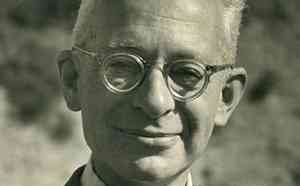 Mario Castelnuovo-Tedesco Source: Art Song Project |
|
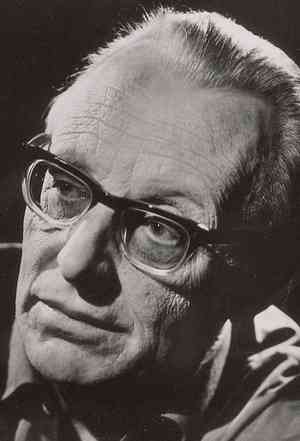 Carl Orff Source: Stockton Symphony |
Born on 10 July 1895 in Munich,
Carl Orff
began piano at age five, organ and cello as well while raised in Catholic
household. At age ten a short story
of his was published in a children's magazine. He began writing songs by the
time he was an adolescent. With the exception of his mother helping him with
scoring he was self-taught. His music first published in 1911,
soClassiQ
dates a couple of songs to that year: 'Immer leiser wird mein Schlummer'
[text]
and 'Schlaflied für Mirjam' [autograph;
text]. Orff studied at the Munich Academy of Music
from 1912 to 1914. The latter year at age eighteen he composed the
orchestral 'Tanzende Faune' ('Dancing Fauns') Op 21
[interpretation by the Cincinnati Symphony Orchestra w Paavo Järvi;
autograph]. World War I found Orff
in a German trench. After the War he returned to the Munich Academy, also
employed at various opera houses. In 1924 he and
Dorothee Günther founded
the Günther School for gymnastics, music and dance in Munich.
A major portion of Orff's career involved teaching music to children.
With assistance from former students, Hans Bergese and Gunild Keetman, Orff
published 'Orff-Schulwerk: Elementare Musikübung' from 1932-1935 [*], a
method for teaching music to children which didn't pass inspection w the
Nazi Reich but would later revive [1,
2,
3,
4,
5,
6,
7;
Wikipedia: 1,
2,
3].
Orff's famous cantata trilogy,
'Carmina Burana', premiered in Frankfurt on 8 June 1937
[1,
2,
3,
4,
5,
6;
interpretation by the Hartford Symphony Orchestra & Chorus directed by Fritz Mahler;
live performance by the UC Davis Symphony and Chorus;
text].
Lyrics for that were taken
from the 'Codex Buranus', the latter containing above 200 texts by largely anonymous
composers before year 1250 and published in 1847 [1,
2]. 'Carmina Burana' opens and
closes with 'Fortuna Imperatrix Mundi' including the song, 'O Fortuna',
addressing the Greek
goddess of fate [1,
2,
3;
live performance by the Johann Strauss Orchestra w André Rieu;
text].
Orff continued working in Germany during the Nazi regime, coming
to considerable guilt for not attempting to intercede for Karl Huber, a
friend and
founder of the Nazi resistance movement called the White Rose. Fearing that
a vain attempt to assist Huber would destroy his career, Orff confronted his
failure of Huber, Huber's wife and himself when Huber was guillotined on 13
July 1943. The Nuremburg trials [1,
2,
3] which began the process of the denazification
of Germany [1,
2,
3] otherwise found him innocent of Nazism.
Opinion of Orff and his situation in the Third Reich ranges widely from
clear of any guilt to highly self-interested, an involved matter of deeper
concern which pursuit I leave as is. From 1950 to 1954 Orff and Keetman published five volumes of 'Music for Children'
[1,
2].
'Music For Children' was issued by Columbia in the UK in 1958 per
Volume 1 [audio]
and Volume 2 [audio], recorded by the Chorus Of The Children's Opera Group
directed by Margaret John w The Chorus Of The Bancroft School For Boys
directed by J. G. Wright assisting on Volume 2. Orff drew
from antiquity again toward the premiere of his opera, 'Prometheus', at the
Staatstheater in Stuttgart on 24 March 1968
[1,
2;
interpretation by the Bavarian Radio S O & Frauenchor October 1975]. Orff's opera drawn from
Aeschylus' (disputably)
'Prometheus Bound' written sometime after 479 BC,
Prometheus is the
figure in Greek mythology condemned to the eternal eating of his liver by an
eagle for stealing fire from the gods to bestow it upon humankind. Begun in
1962, Orff eventually completed the first version of his mystery play, 'De Temporum Fine Comoedia'
('A Play on the End of Time'),
on 20 Feb 1971 toward its premiere at the Salzburg Music Festival on 20
August 1973. Its revision in '79 saw publishing in 1981
[1,
2,
3,
4;
interpretation by the Cologne Radio Symphony Orchestra w Herbert von Karajan
1974]. That was the last work that Orff completed before his death in Munich on 29
March 1982 [obits: 1,
2].
References: 1,
2,
3.
Chronologies: 1,
2.
Compositions:
chronological;
by genre: 1,
2;
operas;
pedagogic.
Authorship.
Books & documents: Canada;
France;
Germany: 1,
2,
3,
4;
USA;
international: 1,
2.
Audio: 1,
2,
3,
4,
5,
6,
7.
Recordings of: discos: 1,
2,
3,
4,
5;
select: 'Lieder Und Gesänge' w Michael Schopper (baritone), Mechthild Bach (soprano) and Gerd Türk (tenor);
'Prometheus' by the Cologne West German Radio S O w Ferdinand Leitner:
1,
2,
3.
Filmographies: 1,
2,
3.
Documentaries: at home 1958.
Iconography.
Further reading by source: Carl Orff Competition;
Carl Orff Foundation;
Godela Orff
(daughter);
John Rockwell;
Ingo Schulz.
Further reading by topic: Nazism and: 1,
2,
3,
4;
pedagogy of;
students of;
trivia.
See also: the American Orff-Schulwerk Association;
the Russian Pedagogical Society.
Bibliographies: 1,
2.
Other profiles: Deutsch: 1,
2;
English: encyclopedic: 1,
2,
3;
musical; 1,
2,
3,
4,
5
(alt);
Espanol;
French;
Russian: 1,
2.
Carl Orff 1949 Opera Chor der Wiener Staatsoper Der Winer Philharmoniker Ferenc Fricsay Contralto (Antigonae): Res Fischer premiere: Frankfurt 1937 Cantata trilogy Pacific Boychoir Academy: Kevin Fox University Chorus & Alumni Chorus Jeffrey Thomas UC Symphony Orchestra Dallas Kern Holoma Soprano: Shawnette Sulker 1962-72 Revised 1979 Opera Kölner Rundfunk Sinfonie Orchester Herbert von Karajan 1953 Cantata Novosibirsk Philharmonic Gintaras Rinkevičius |
|
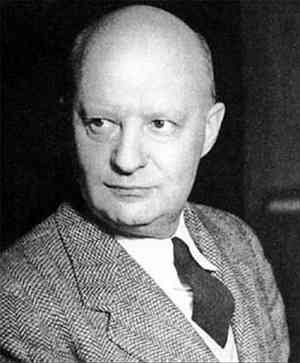 Paul Hindemith Source: All Music |
Born on 16 Nov 1895 in
Hanau, Germany, violinist
Paul
Hindemith
made his name, considerable as composers go, as a modernistic Expressionist.
He
began
studies at the Hoch Conservatory [1,
2] in Frankfurt in the winter of 1908-09, that on a
scholarship from one Adolph Rebner due that his parents could not afford the
school. IMSLP has him composing 'Lieder' Op 274
No.1-7 in 1908-09, that for soprano or tenor w piano which autograph yet
exists
[see also
Hindemith].
His Opus 1 got assigned to 'Andante and Scherzo' for piano, clarinet and
horn premiering at the Hoch Conservatory on 12 June 1914 [1,
2]. Among his first professional
positions was as deputy leader of the Frankfurt Opera Orchestra in 1914, as
well as second violin in the Rebner String Quartet. He became leader of the
Frankfurt Orchestra in 1917. Hindemith began his breakaway from the late
romantic works of his early period as he shifted his focus to contemporary
literature. His first wade into Expressionism was his 'String Quartet
No.2' Op 10 written in Alsace in 1918 and first performed on 2 June 1919 in
Franfurt [1,
2;
interpretation w score by the Danish String Quartet or
the Kocian Quartet].
He followed that with his expressionistic Opus 11 Nos. 1-5. He had begun
composing 'Violin
Sonata' Op 11 No.1 in May 1918 toward its premiere by
Adolf Rebner (violin) and Emma Lübbecke-Job (piano) on 2 June 1919 in
Frankfurt [1,
2,
3,
4;
live performance by Lea Birringer (violin) w Esther Birringer (piano);
score].
He wrote 'Violin Sonata' Op 11 No.2 between Sep and Nov of
1918 toward premiere on 10 April 1920 in Frankfurt
[1,
2;
interpretation by Petro Titiaiev (violin) w Anastasiia Boyko (piano);
live performance by Roman Mints (violin) w Alexander Kobrin (piano);
score].
The first version of his
'Cello Sonata' Op 11 No.3 saw performing in
Frankfurt on 27 October 1919, a second version finished in 1921
[live performance by
Kevin Kunkel (cello) w Yejin Noh (piano)]. Hailed for his instrumental works,
Hindemith also wrote for stage. His first two were expressionistic operas
performed together in Stuttgart on 4 June 1921, the one being 'Mörder,
Hoffnung der Frauen' ('Murderer, Hope of Women') Op 12 w libretto by Oskar
Kokoschka [1,
2,
3,
4,
5;
interpretation by
the Radio-Symphonie-Orchester Berlin diretta da Gerd Albrecht]. The other was 'Das Nusch-Nuschi' Op
20 w text by Franz Blei [1,
2,
3,
4,
5;
interpretation by
the Radio-Symphonie-Orchester Berlin diretta da Gerd Albrecht]. Those
comprised the first two of a triptych of one-act operas with sexuality their
theme, the third being 'Sancta Susanna' Op 21 composed in Jan and Feb of
1921 toward its premiere in Frankfurt on 26 March 1922 w libretto by August
Stramm [1,
2;
interpretation w score by
the Radio-Symphonie-Orchester Berlin diretta da Gerd Albrecht;
dress rehearsal
by the Orchestra Arché]. Significant as well was Hindemith's tour of Europe in latter 1921 with the Amar Quartet
[1,
2].
Hindemith's 'Klaviermusik mit Orchester' Op 29 had been commissioned in 1923
by left-handed pianist, Paul Wittgenstein, who never performed it. The
work wasn't premiered until 2004 by Leon Fleisher and the Berlin
Philharmonic [1,
2,
3,
4; Leon Fleisher backed by the San Francisco Symphony conducted by Herbert Blomstedt
2005]. Come Hindemith's fourth of eleven operas, 'Cardillac' Op 39 w
libretto by Ferdinand Lion, to the Staatsoper in Dresden on 9 November 1926
[1,
2;
live performance at the Bayerische Staatsoper
1985]. He began teaching at the Berliner Hochschule für Musik in 1927.
Hindemith's score to the Dadaist [1,
2,
3,
4,
5,
6] silent film directed by Hans Richter, 'Ghosts Before Breakfast',
was later destroyed by Nazis. Though other scores have since been written, Hindemith's is
lost [1,
2,
3,
4;
film
(silent)]. During the thirties he visited Cairo, worked in
Ankara and toured the United States as a solo violist. Hindemith wrote
several texts on music theory, Book 1 of 'The Craft of Musical Composition'
issued by Associated Music Publishers in 1937 [1,
2,
3,
4].
Book 2 and Book 3 were exercises published in '39 and '40 respectively. The weather as of
Nazi Germany found Hindemith emigrating to Switzerland in 1938, then the United
States in 1940 where he taught at Yale and lectured at Harvard. It was 1940
when he began to write among his most esteemed orchestral works, 'Symphonic
Metamorphosis of Themes by Carl Maria von Weber', completing it on 29 August
1943 [1,
2,
3,
4,
5,
6;
interpretation by the San Francisco Symphony Orchestra w Herbert Blomstedt
or
the BBC Scottish Symphony Orchestra w Martyn Brabbins;
live performance by the SWR Symphonieorchester w Dima Slobodeniouk]. Volume
1 of 'A Concentrated Course in Traditional Harmony' had appeared in 1943 as well, Volume 2
published in '53 [*]. He published
'Elementary Training for Musicians' in 1946 [1,
2],
the same year he became a U.S. citizen. In 1947
Benny Goodman
commissioned 'Clarinet Concerto', premiering it in 1950 with the
Philadelphia Orchestra, conducted by
Eugene Ormandy
[1,
2,
3,
4;
interpretations w clarinet by Louis Cahuzac
or
Ulrich Mehlhart].
Hindemith completed his 'Symphony in B-flat for Band' in 1951
[1,
2,
3;
interpretation
w score by the Colorado Springs Chamber Music Society conducted by Michael Paul]. He returned to Europe in 1953 to teach at the
University of Zurich. He also did some recording in his latter years,
such as 'Symphony in B-flat for Band' for EMI in 1956. Hindemith premiered
his final opera, the one-act 'The Long Christmas Dinner' w text by Thornton
Wilder, at the Juilliard School of Music in New York on 13 March of '63
[1,
2,
3;
interpretation by
the Rundfunk-Sinfonieorchester Berlin diretta da Marek Janowski]. Hindemith
died
in Frankfurt of pancreatitis on 28 December 1963. Along with 11 operas
Hindemith had written concertantes
and works for chamber, orchestra, voice, piano
and organ. References: 1,
2,
3,
4.
Chronologies: 1,
2.
Compositions: 1,
2;
alphabetical: 1,
2;
chronological;
count by category;
by genre: 1,
2,
3;
Catalan;
Deutsch: 1,
2;
Francais,
Russian,
Spanish.
Authorship: 1,
2.
Artwork.
Song texts.
Editions & scores: 1,
2,
3,
4.
Books & documents: 1,
2,
3,
4,
5,
6,
7.
Databases: BMLO;
Audio: 1,
2,
3,
4,
5,
6,
7,
8,
9.
Recordings of: discos: 1,
2,
3,
4,
5;
select: 'The Complete Violin Sonatas' by Ulf Wallin (violin) & Roland Pöntinen (piano)
*;
'Complete Works for Violin & Piano' by Roman Mints (violin) & Alexander Kobrin (piano)
*;
'Hindemith Conducts Hindemith': Deutsche Grammophon 3CD;
HMV vinyl;
Urainia 2CD;
'Paul Hindemith': EMI Classics 55032;
EMI Classics 3 77344 2.
IMDb.
Iconography.
Further reading: awards & honorary degrees;
dwellings: Frankfurt 1923-27,
Lake Geneve 1953>;
Expressionism;
fugal
composing;
students.
Bibliography:
'Mörder Hoffnung der Frauen' by Christopher Thomas ('Opera Quarterly' 1988).
Other profiles: Catalan;
Deutsch: 1,
2.
English: 1,
2,
3,
4,
5,
6;
Finnish;
Francais;
Russian: 1,
2,
3,
4;
Spanish.
Paul Hindemith Die Harmonie der Welt Symphony 1951 3 movementsSpanish Radio & Television S O Arturo Tamayo 1922 Op 23b 6 poems by Georg Trakl Mezzosopran: Katrin Wundsam 1922 Op 24:1 4 movements Netherlands Radio Chamber Orchestra Peter Eotvos 1927 Op 46:2 3 movements Organ: Konstantin Volostnov Norbert Kaiser Organ: Konstantin Volostnov Piano Sonata 3 in B flat major 1936 Piano: Maria Yudina 1937 4 movementsQueensland S O Brisbane Werner Andreas Albert 1941 4 movements Trombone: Carsten Svanberg 1931 Secular oratorio C & O della RAI di Torino Mario Rossi Sopran: Adriana Martino |
|
| Born on 28 December 1896 in
Brooklyn,
Roger Huntington Sessions
composed his first work in 1910 during his last year in high school, an opera titled 'Lancelot and Elaine',
inspired by Lord Alfred Tennyson's 1859 'Idylls of the King', that
was probably performed but not published. An advanced student, he
enrolled at Harvard to study music in 1911 at age fourteen, there writing for and
editing
the 'Harvard Musical Review' before graduating at age eighteen. Sessions
further studied at Yale before beginning to teach at Smith College in
Northampton, Massachusetts. In June 1920 he married one Barbara Foster. In the meantime he wrote
'Romauldo's Song' for voice and piano in 1923. His highly popular 'The Black Maskers' was
incidental music for a senior class play at Smith College in 1923. The
orchestral 'Suite' followed five years later in '28
[interpretations by the Eastman-Rochester Orchestra w Howard Hanson,
the American Recording Society Orchestra w Walter Hendl
or
the Juilliard Orchestra w Paul Zukofsky].
Owning dates of 1924-26 is '3 Chorale Preludes', two w keyboard,
consisting of settings to Biblical verses: 'Praise Ye the Lord' (from
'Psalms'), 'Ah, Sinful Nation' (from 'Isaiah') and 'Out of the Depths' (from
'Psalms')
[*].
During that period he and Barbara left for Europe in 1925 for the next eight
years where they lived in Florence, Rome and Berlin as he acquired a couple
of Guggenheim fellowships, a Prix de Rome and a grant from the Carnegie
Corporation. It was during that period that he finally got down to focusing
on composition. His 'Symphony No.1' was premiered by the Boston Symphony
Orchestra w Serge Koussevitzky on April 22, 1927
[1,
2;
interpretations by the New York Philharmonic Orchestra w Neeme Jarvi &
the Japan Philharmonic Orchestra w Akeo Watanabe].
'Piano Sonata No. 1' in E minor arrived in 1930 [Robert Phelps at piano].
Sessions and Barbara returned to the USA in 1933 where he finally finished
his 'Violin Concerto' in San Francisco in August of '35. Its 1936 premiere,
however, had to be cancelled, as the Finale contains a difficult tarantella
which intended violinist, Albert Spalding, was unable
to master in time.
It was eventually proved playable in Chicago on 8 January 1940 by Robert
Gross w the WPA Illinois Symphony Orchestra conducted by Izler Solomon
[1,
2;
Paul Zukofsky at violin
w the Orchestre Philharmonique de l'ORTF conducted by
Gunther Schuller].
Though Sessions had dedicated 'Violin Concerto' to Barbara, they divorced in
Sep 1936 whence Sessions married Sarah Elizabeth Franck in November with
whom he would have a couple of children in '38 and '40, the elder to become a cellist. Sessions
had begun teaching at Princeton in New Jersey in
1936. His 'Duo for Violin and Piano' arrived in 1942
[interpretation
by Patricia Travers (violin) & Otto Herz (piano) 1950]. In 1945 he moved to California to teach at its university in
Berkeley to 1953. Most of Sessions' composing up to that time had
been traditionally keyed. His 'Piano Sonata No.2' of 1946, however, was completely
atonal
[*;
piano by Robert Fleitz,
Robert Helps or
Beveridge Webster].
Also an author, Sessions' 'The Musical Experience of Composer, Performer,
Listener' saw publishing by Princeton University Press in 1950, republished
in 1958 [*].
Harcourt, Brace published 'Harmonic Practice' in 1951
[review by Alvin Bauman].
Sessions' first examination of twelve-tone serial composing was in 1953 per his 'Violin
Sonata' [*],
the year he returned to Princeton to teach until retirement in '65.
'Reflections on the Music Life in the United States' was published by Merlin
Press in 1956. Come his twelve-tone opera 'Montezuma', a major modernistic
work first performed on 19 April 1964 at the Deutsche Oper in Berlin w
English libretto by Giuseppe Antonio Borgese translated into Deutsch
[1,
2]. Its
English premiere in
the USA didn't arrive until 31 March 1976 by the Opera Company of Boston
conducted by Sarah Caldwell w Richard Lewis as Montezuma [recording].
Another important atonal work was 'Piano Sonata No. 3' arriving in 1965
[interpretation by Yan Shen]. From 1966 to 1983 Sessions taught at Juilliard part time. Lectures at
Harvard in 1968 and '69 saw publishing in 1970 as 'Questions About Music'
[*].
Sessions' 'Symphony No.7' saw premiere in Ann Arbor, Michigan, on 1 October
1967 by the Chicago Symphony Orchestra conducted by Jean Martinon
[recording]. Inspired
by the 1954 'Story of O' by Pauline Réage (Anne Desclos), that was composed
for the 150th anniversary of the University of Michigan. His 'Symphony
No.8' premiered on 2 May 1968 by the New York Philharmonic conducted by
William Steinberg [1,
2;
interpretations by the American Symphony Orchestra w Leon Botstein &
the BBC Symphony Orchestra w Lawrence Foster]. Sessions received
a Pulitzer Prize Special Citation in 1974 for life work [*]. Commissioned by the Syracuse Symphony Orchestra, 'Symphony No.9', Sessions'
final, saw its first performance in Syracuse on 17 January 1980 conducted by
Christopher Keene [interpretation by the BBC Northern Symphony Orchestra w
Frederik Prausnitz].
Sessions won another Pulitzer Prize in '82 for his 'Concerto for Orchestra'
completed on 16 August 1981 toward
premiere on 23 October 1981 by the Boston Symphony Orchestra conducted by
Seiji Ozawa [1,
2].
He died on 16 March 1985 in
Princeton, having left 'Duo for Violin and Violoncello', another serial work, unfinished
[interpretation
by Curtis Macomber (violin) & Joel Krosnick (cello)].
References: 1,
2,
3,
4.
Compositions: 1,
2;
chronological (Español);
by genre: 1,
2,
3;
operas.
Song texts.
Editions & scores.
Books & documents: France;
Germany;
international: 1,
2.
Collections:
Andrea Olmstead (New York Public Library);
PACSCL.
Audio: 1,
2,
3,
4.
Recordings of: discos: 1,
2,
3;
select: 'Music for Violin & Piano' by David Bowlin (violin) & David Holzman (piano)
*;
'String Quartet' by the Group of Contemporary Music
*;
'Symphonies 6, 7 & 9' by the American Composers Orchestra w Dennis Russell Davies
*.
Further reading by source: GMG (forum);
David Wright;
Iannis Xenakis ('Formalized Music').
Further reading by topic: analysis of Symphonies 2 & 6 (Steven Morton Kress);
correspondence; students.
Relevant reading by subject: atonal music: 1,
2;
serialism: 1,
2,
3;
twelve-tone technique: 1,
2.
Bibliography: analysis: 'Montezuma' (Mason);
authors: Andrea Olmstead,
Barbara Tischler;
books: 'Roger Sessions on Music: Collected Essays' edited by Edward Cone (Princeton University Press 1979):
1,
2;
'Roger Sessions: How a 'Difficult' Composer Got That Way' by Frederik Prausnitz (Oxford U Press 2002).
Other profiles: Dutch;
English: 1,
2,
3,
4;
Italian;
Russian;
Spanish.
Roger Sessions 1966 Violincello: Luca Fels The Black Maskers Orchestral Suite 1928American Recording Society Orchestra Walter Hendl 1942 Performance 1950 Piano: Otto Herz Violin: Patricia Travers 1937-40 4 movements for piano Piano: Robert Helps 1956 Munich Philharmonic Orchestra James Levine 1930 Piano: Robert Helps 1946 Piano: Robert Helps 1927 3 movements Japan Philharmonic Orchestra Akeo Watanabe 1946 New York Philharmonic Dimitri Mitropoulos 1957 4 movements Royal Philharmonic Orchestra Igor Buketoff 1958 3 movements Columbus Symphony Orchestra Christian Badea 1964 Columbus Symphony Orchestra Christian Badea 1964 Columbus Symphony Orchestra Christian Badea 1964 Columbus Symphony Orchestra Christian Badea 1967 3 movements Chicago Symphony Orchestra Jean Martinon 1968 2 movements American Symphony Orchestra Leon Botstein 1978 BBC Northern Symphony Orchestra Frederick Prausnitz 1927-35 Orchestre Philharmonique de l'ORTF Gunther Schuller Violin: Paul Zukofsky |
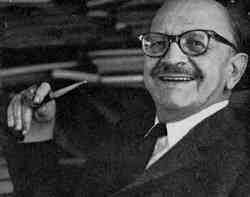 Roger Sessions Source: American Century Music |
|
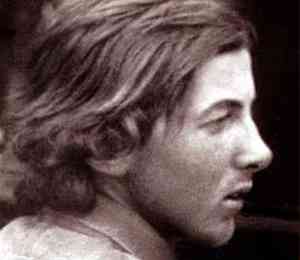 Henry Cowell Circa 1913 Photo: Sydney Cowell Collection/NYPL Source: Wikipedia |
Born on 11 March 1897 in
Menlo Park, California,
modernist composer,
Henry Cowell
had in Irish immigrant for a father, his mother from Iowa. His compositions
are listed by "HC" number per 'The Music of Henry Cowell: A Descriptive
Catalog' by William Lichtenwanger (Brooklyn College 1986). The Henry Cowell
website (frames) lists his HC 1 as a sing melodic line for a song titled
'The Waves' written when he was nine or ten years of age. HC 2 was a piano
setting written at age eleven for Longfellow's 1851 'The Golden Legend'. HC
3 was 'Lullaby' for piano composed circa 1910. Come 'Savage Suite' HC 40 for
piano in 1913. Cowell wrote 'Anger Dance'
for piano in 1914, the year he entered the
University of California, Berkeley. Originally titled 'Mad Dance', Michael
Hicks has that inspired by a visit to a doctor for a muscle spasm in his
leg. Cowell himself recorded the piece at least once, emerging on Circle
L-51-101 in 1951 [piano by Henry Cowell
(date unidentified); interpretation by
Steffen Schleiermacher;
live performance by Fausto Bongelli].
After a couple years at Berkeley he studied further in New York
where in 1916 an interest in tone clusters
[1,
2], term coined by Cowell, brought
about 'Dynamic Motion' which requires play by both forearms
[1,
2;
interpretation by Daniele Lombardi;
live performance by
Fausto Bongelli]. His mother
also dying in 1916, Cowell returned to California where in 1917 he composed
music for John Varian's opera, 'The Building of Banba' HC 219. Varlan was leader of
a theosophical community in Halcyon where the opera premiered in August 1917
at the Temple of the People [Lewis; Wikipedia].
The prelude to that is ''The Tides of Manaunaun' HC 219/1 in which Cowell
explores tone clusters again [1,
2,
3;
live performances by Shi-An Costello (世 安),
Wilhem Latchoumia
&
Elif Onal;
score]. 'The Tides of Manaunaun' is the first of
Cowell's 'Three Irish Legends' HC 354 published in 1922
[1,
2;
interpretation by Steffen Schleiermacher w scores;
live performance by Tricia Dawn Williams].
Cowell's first of 21 symphonies, 'Symphony No.1', was a student work that he
didn't like bearing a date of 1918. His next wouldn't arrive for more than
twenty years.
Stephanie Stallings has Cowell in the army in 1918 and 1919 [making the
enlistment date of Feb 1917 at MINDS
a typo?]. Serving stateside in an army band, not to see combat, Cowell's
first visit to Europe was a concert tour in 1923. It was about 1923 that he completed 'Aeolian Harp' HC 370 in which
the strings of the piano are played in addition to keys
[1,
2;
live performances by Fausto Bongelli &
Gabi Sultana]. That would lead to the
later development of prepared piano by
John Cage who was a student of
Cowell in 1933. In 1927 Cowell began to publish the 'New Music Quarterly' whence
scores by then unknown
Charles Ives
would see print. Cowell is the first American composer invited to the
Soviet Union, visiting Moscow in 1928 [*]. Touring North America and Europe as a
pianist helped make Cowell's a major name in modernistic composing by the time he
published his study in rhythm, 'New Musical Resources', in 1930
[1,
2,
3,
4].
Another of Cowell's various innovations was his invention of the Rhythmicon
[1,
2,
3,
4,
5] with
Léon Theremin (inventor of the
theremin, an instrument favored by
Les Baxter). Beginning work on the Rhythmicon in
1930, its premiere arrived to the New School for Social Research in New York
on 19 Jan 1932. The Rhythmicon produced 16
different rhythms electronically [later demonstrations: 1,
2].
issuu shows the score to 'Rhythmicana for Rhythmicon and Orchestra'
published in 1931 [see also *]. His version for solo piano followed in 1938
[interpretation by Stacey Barelos;
live performance by Sarah Cahill]. A Guggenheim Fellowship in 1931 sent
Cowell to Berlin to
study musicology, Carnatic theory
(major Indian subgenre) and Indonesian gamelan.
He formed the record label, New Music Recordings, in 1934. Though he didn't identify as a homosexual (marrying Sidney in 1941) he found himself at San Quentin north
of San Francisco for fours years in 1936 as a result of oral sex with a
seventeen year-old male, Cowell age 39. He there directed the prison band.
It's said that quite some years after serving his term Cowell exhibited symptoms of
paranoia developed while incarcerated. He nevertheless had a protector in
one John Hendricks. Incarcerated for murder, Hendricks also played violin and
respected Cowell who made Hendricks his conductor. While in San Quentin
Cowell composed, all in 1939: 'Amerind Suite' for piano, 'Return'
[Ensemble 64.8 live],
'Ritournelle' and 'Pulse'
[interpretation by the Kroumata Percussion Ensemble;
live performance by the TAMUCC Percussion Ensemble].
Upon his release from prison in June 1940 he began what could be called his
next career as as he added a strong interest in more traditional forms to
his otherwise
progressive ear. His initial employment was creating radio programs for
broadcast overseas by the United States Office of War Information, that to
counter Nazi radio propaganda. In the meantime he began to write the majority of his symphonies
('No.1' back in 1918)
commencing with 'Symphony No.2'
('Anthropos') premiering at the Brooklyn Museum on 9 March
1941 by the New York Civic Orchestra conducted by Cowell
[interpretation by the American Symphony Orchestra conducted by Leon Botstein; on CD: 1,
2,
3].
Come 'Symphony No.3' ('Gaelic') in 1944
[interpretation by the Louisville Orchestra conducted by Jorge Mester;
score].
'Symphony No.4' ('Short Symphony') arrived in 1946 [interpretation by the Eastman-Rochester S O w Howard Hanson].
Come 'Symphony No.5' in 1948 [interpretation by the American Recording S O w Dean Dixon;
score].
Several more symphonies down the road, his 'Symphony No.10' emerged in 1953
[interpretations by the Vienna Philharmonic Society Orchestra w F. Charles Adler & the Chicago Symphony Orchestra w Christopher Keene].
Cowell began work on 'Symphony No.11' ('Seven Rituals of Music') in 1953 toward
its completion in '54 [interpretation by the Louisville Orchestra w Robert Whitney].
He
also resurrected the harpsichord in 1954 per his 'Quartet'
for flute, oboe, cello and harpsichord [harpsichord by Jacquelyn Bartlett (audio) &
Joyce Chen (live)].
In 1955 Cowell published the biography, 'Charles Ives and His Music',
written in collaboration with his wife, Sydney, the year following
Ives' death. He began 'Symphony No.12' HC
830 in '55 toward completion in '56, the year the
Rockefeller Foundation sent him to Iran, India and Japan. Come 'Symphony
No.13' ('Madras') in 1957-58 [interpretation by the San Francisco Composers Chamber Orchestra w Mark Alburger]. It was harpsichord
again per 'Set of Four' written for Ralph Kirkpatrick who premiered it at
the U of C Berkeley 1961 ['Rondo' 1/4 by Ralph Kirkpatrick 1961;
Mahan Esfahani 2020]. In 1961
Cowell
represented the United States at conferences in Tehran and Tokyo. He wrote
'26 Simultaneous Mosiacs' upon learning of the assassination of President
Kennedy in Nov 1963 [*;
live performance by the Ensemble Third Sound].
He left 'Symphony No.21' unfinished when he himself died on 10
Dec of 1965, only its sketches to be completed by former student and longtime
associate, Lou Harrison.
References: 1,
2,
3,
4,
5,
6.
Compositions:
alphabetical: 1,
2;
by genre: 1,
2,
3;
by HC number;
solo piano: 1,
2,
Dutch.
Authorship.
Editions & scores (German).
Books & documents: Canada,
France,
international: 1,
2.
Collections: Fleisher;
NYPL.
Audio: 1,
2,
3,
4,
5,
6,
7,
8;
San Francisco Composers Chamber Orchestra w Mark Alburger;
YouTube;
WNYC Radio 1940;
Recordings of: discos: 1,
2,
3,
4;
select: 'Amiable Conversation: Henry Cowell | John Cage' w piano by Sabine Liebner;
'From the Steeples and the Mountains' by the London Gabrieli Brass Ensemble w Christopher Larkin;
'Henry Cowell' w piano by Stefan Litwin backed by the Rundfunk-Sinfonieorchester Saarbrücken w Michael Stern;
'Mosaic'
(chamber works) by the Colorado Quartet & Musicians Accord: review;
'Piano Music' by Henry Cowell: 1,
2;
'The Piano Music of Henry Cowell' by Henry Cowell.
Interviews: 'Masterwork Hour' 1955,
WBAI FM 1961.
Further reading by source: Peter Garland,
Albert Imperato,
Joan Peyser,
Stephanie Stallings,
Mark Swed.
Further reading by topic: piano works performance guide [Clough].
Bibliography:
'Henry Cowell: Bohemian' by Michael Hicks (U of Illinois Press 2002);
'Writings about Henry Cowell' by Martha Manion (Brooklyn College of CUNY 1977);
'Henry Cowell: A Man Made of Music' by Joel Sachs; 'The Writings of Henry Cowell' by Bruce Saylor (Brooklyn College of CUNY 1977).
Other profiles: Dutch;
English: 1,
2;
Russian.
Henry Cowell 1963 Continuum/Joel Sachs 1957 Louisville Orchestra Jorge Mester 1939 The Kroumata Percussion Ensemble 1930? Internal piano piece Piano: Fausto Bongelli 1925 6 pieces Piano: Cheryl Seltzer Violin: Mia Wu 1946 'Short Symphony' 4 movements Eastman-Rochester S O Howard Hanson 1948 4 movements American Recording S O Dean Dixon 1956 'Seven Rituals of Music' 7 movements Louisville Orchestra Robert Whitney 1927 Tone cluster piece Piano: Maria Fernanda Zapata |
|
|
Born in Łódź, Russia (now Poland) on 12 June 1897,
Alexandre Tansman
was a virtuosic pianist who
studied music at the Łódź Conservatory [1,
2] from 1902 to 1914. Beginning studies in law and philosophy
at the University of Warsaw, he acquired his doctorate in 1918, during which
time he composed 'Caprice' in 1916. My main authority in what few compositions
that I cite herein is Gérald Hugon. In 1919
Tansman headed for Paris. He declined
opportunity to become a member of the avant-garde group of composers known
as
Les Six, preferring a high
degree of independence. Exampling his young career during the Années folles
in France is his '7 Preludes' for piano of 1922 and his 'Sinfonietta No.1' of 1924 [interpretation by the Virtuoso di Praga w Israel Yinon].
Come 'Concerto No.1' for piano and orchestra in 1925
[piano by Julia Kociuban
backed by the Arthur Rubinstein Philharmonic Orchestra w Paweł Przytocki]. 'Concerto No.2'
for piano and orchestra arrived in 1927 dedicated to Charlie Chaplin
[piano by David Greilsammer
backed by the French National Orchestra w Steven Sloane]. As France entered
into the Depression years Tansman wrote his 'Concertino' for piano and
orchestra in 1931. He composed 'Rapsodie Polonaise' in Nice 1940, completing
its orchestration on 16 July 1941
[interpretation by the Polish Radio S O w Bernard le Monnier].
Being Jewish, Tansman left Europe at war for Los Angeles in 1941 where he
began writing film scores. His 'Symphony No.5' of nine arrived in 1942
dedicated to the conductor, Paul Kletzki
[interpretation by the Melbourne Symphony Orchestra w Oleg Caetani].
Come his 'Concertino' for guitar and orchestra in the summer of '45
[guitar by Frédéric Zigante
backed by the Royal Ballet Sinfonia w Andrew Panny]. Returning to Paris in 1946 after the War,
he composed his 'Concertino' for oboe, clarinet and string orchestra in 1952
[interpretation by the Silesian Chamber Orchestra w Bernard le Monnier].
Tansman premiered his 'Onze Interludes' in Nov of 1955 for a French radio
broadcast [piano by Giorgio Koukl].
Also premiering on radio was his suite of ten movements, 'Visit to Israel',
in 1958 [piano by Giorgio Koukl;
score].
Tansman's fourth and last 'Concertino' arrived in 1968 for flute, piano and
string orchestra. He premiered his 'Sinfonietta No.2' on his birthday in
1980 [interpretations by
the Orchestra della Svizzera Italiana w Oleg Caetani &
the Virtuoso di Praga w Israel Yinon].
Tansaman died in Paris
on 15 Nov 1986 with works for individual instruments like piano and guitar
more highly regarded in general than his orchestral works. Albeit he had spent the majority of life in Paris he
identified as a Polish composer.
References: 1,
2,
3,
4,
5.
Compositions:
alphabetical: 1,
2,
3;
chronological;
by genre: 1,
2,
Deutsch,
Francais.
Editions & scores: 1,
2.
Books & documents: 1,
2,
3,
4.
Collections: BYU.
Sheet music.
Audio: 1,
2,
3,
4,
5,
6.
Recordings of: discographies: 1,
2,
3,
4;
select: 'Complete Music for Solo Guitar' by Cristiano Poli Cappelli:
1,
2;
'Guitar Music Complete' by Marc Regnier:
notes;
'Guitar Recital' by Andrés Segovia;
'Music for Violin and Piano' by Klaidi Sahatçi (violin) & Giorgio Koukl (piano)
*;
'Piano Music' by Giorgio Koukl:
notes.
IMDb.
Iconography.
Further reading: 'Portrait of a Composer' by Timmons & Frémaux:
Part 1,
Part 2.
See also the Tasman Philharmonic.
Bibliography.
Other profiles: Deutsch: 1,
2;
English: 1,
2,
3,
4,
5;
LA Phil (video biography);
French;
Italian;
Japanese;
Russian;
Spanish.
Alexandre Tansman 1957 3 movements Silesian Chamber Orchestra Mrosław Jacek Błaszczyk Clarinet: Jean-Marc Fessard 1945 Royal Ballet Sinfonia Andrew Penny Guitar: Frédéric Zigante Piano: Daniel Blumenthal Sonatine for Bassoon and Piano Bassoon: Yuki KatayamaPiano: Xi Chen 1940 Piano: Daniel Blumenthal 1926 Melbourne Symphony Orchestra Oleg Caetani 1939 Bamberger Symphoniker Israel Yinon 1947 Concertgebouw Orchestra Rafael Kubelík |
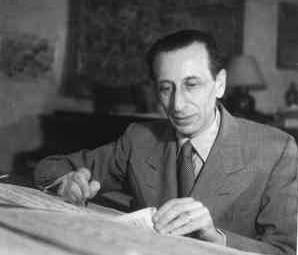 Alexandre Tansman Source: Musicologie |
|
| Born in Chandler,
Oklahoma, on 12 Feb 1898, to farmers,
Roy Harris
grew up in California upon his father selling his homestead to purchase land
in Covina east of Los Angeles. Roy played piano and clarinet as a youth, but
studied nonmusical topics at the University of California when he enrolled
there in 1919. Pytheas [below] has him composing 'Pueña Hueca' for chorus,
violin, cello and piano as early as 1920. He began to study composition apart from UC in 1922,
acquiring the tutelage of Arthur Farwell in 1924. He was with Farwell
when he completed the Andante to his first symphony, 'Our Heritage', in
1925. That was revised the next year, though the rest of the work was
abandoned.
Wikipedia offers a list of twenty symphonies
written by Harris. In 1926 Harris was able to get to Paris to study Renaissance
music with
Nadia Boulanger.
He that year completed an encouragingly successful 'Concerto for Piano, Clarinet and String Quartet'
Op 2, revised in '27 [interpretation
by the Long Island Chamber Ensemble of New York]. A version for piano
followed in '28, the year his 'Piano Sonata' Op 1 was begun in France toward
its completion and premiere in New York City in 1929
[piano by Roger Shields;
live performance by Geoffrey Burleson].
His Op 3 got assigned to 'Chorale' for string sextet of 1932. Harris began a lifelong
partnership with pianist, Beula Duffey, in 1936 by marrying her, she to
become Johana Harris, changing her first name as well in honor of
Johann Sebastian Bach [1,
2,
3,
4,
exhibit,
YouTube].
Johana and Roy would produce three daughters and two sons, the latter among whom became rock
musicians. The next year in '37 Roy
completed the symphony that
made his name, 'No 3' [1,
2,
3;
interpretation by the Colorado Symphony w Marin Alsop,
the New York P O w Leonard Bernstein
or the BBC S O w Grant Llewellyn]. Harris had also assisted the founding of the American Composers Alliance in
1937, that to publish and promote contemporary classical music with now
above 200 members [1,
2]. Harris left his
'American Symphony' for jazz band of 1938 unfinished. Exampling a
later work for orchestra is Harris' 'Kentucky Spring' of 1949
[Louisville Orchestra conducted by Robert Whitney].
Harris's 1955 cantata for baritone and orchestra, 'Give Me the Splendid Silent
Sun', was set to Walt Whitman's 1865 poem of the same title
[score: 1,
2]. It
was revised in 1959 [baritone by Paul Mann
(version unidentified)]. Harris was sent as cultural ambassador to the Soviet
Union where he conducted a Soviet orchestra in 1958 [*], that one of multiple
trips to Russia. He founded the International String Congress in 1959 to
replenish an attrition of string players. Harris instructed at the University of California Los
Angles (UCLA) during the sixties. Starting in 1970 he began teaching at
California State University in Los Angeles. Though Harris wasn't likely a big fan of rock & roll, unless I've missed something somewhere
he is the earliest-born in these Classical histories to have contributed to
rock music, albeit but a sprig, credited w the Introduction to
'Today's a Day' on Shaun Harris's (son)
solo album of 1973
on which his other son, Danny, also performed guitar [audio].
Roy's final symphony, 'No.13' ('Bicentennial Symphony'), arrived in 1976
originally as 'No.14' due to superstition
[1,
2].
His last composition was 'Rejoice and Sing' in 1976 for bass voice, string
quartet and piano. Harris died in Santa Monica, CA, on 1 October of
1979 [obit], having composed above 170 works.
References: 1,
2,
3.
Compositions: alphabetical: 1,
2,
3;
chronological: AMR,
Pytheas,
Unsung Composers;
by genre: Musicalics,
Pytheas.
Song texts.
Editions & scores.
Books & documents: France;
international: 1,
2.
Collections: Library of Congress.
Audio: 1,
2,
3,
4,
5.
Recordings of: discos: 1,
2,
3,
4;
select: 'Roy Harris | William Schuman' by the New York Philharmonic w Leonard Bernstein
*;
'Violin Concertos' by Tamsin Waley-Cohen (violin) backed by the BBC Symphony
Orchestra conducted by Andrew Litton
*.
Other profiles: Deutsch;
English: 1,
2,
3,
4,
5,
NPR Radio;
Espanol;
Francais.
Roy Harris Concerto for Piano . . . Quartet 1926 Revised 1927/28Long Island Chamber Ensemble 1954 Director: Izler Solomon MGM Symphony Orchestra 1936 This performance 1939 Coolidge String Quartet Piano: Johana Harris 1937–38 Revised 1939 BBC Symphony Orchestra Conducting: Grant Llewellyn 1939 'Folk Song Symphony' Colorado Symphony O & C 1951–52 Revised 1955 BBC Symphony Orchestra Director: Andrew Litton 1961–62 San Francisco Symphony 1962 BBC National Orchestra of Wales Director: Eric Stern 1967 Sinfonia Varsovia |
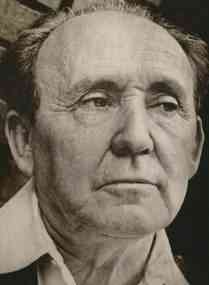 Roy Harris |
|
| Born on 7 Jan 1899 in
Paris, Francis
Jean Marcel Poulenc
composed mostly for piano and song, though also wrote
chamber works such as sonatas, as well as concertos, choral, operatic and
symphonic works. He was 5 weeks older than his future colleague in Les Six,
Georges Auric. Poulenc was
the son of a wealthy manufacturer of pharmaceuticals. He began piano lessons
at age five. He is catalogued by "FP" number per the
chronological 'The Music of Francis Poulenc (1899–1963): A Catalogue' by
Carl B. Schmidt (Clarendon Press 1995). Poulenc's FP1
is listed as 'Processional pour la crémation
d'un mandarin' for piano of 1914, thought to have been destroyed by himself [*].
Poulanc's mother died in 1915 when he was age sixteen, his father to follow
a couple years later. He also destroyed 'Preludes' for piano FP2 of 1916 [*], that the year he studied beneath pianist,
Ricardo Viñes, while
hanging out with avant-garde poets at the bookshop of Adrienne
Monnier. Poulenc's public debut was his 'Rapsodie Nègre' FP3 in 1917, that
for multiple instruments and baritone dedicated to
Érik Satie
[1,
2,
3,
4,
5;
interpretation by New Music Studium directed by Antonio Plotino w Nicolas Rivenq (baritone);
w score;
live performance by the ensemble of the KammerMusikKöln w Marta Wryk
(mezzo-soprano)]. From 1918 to 1921 Poulenc served in the military, his last
post as a typist. During that time he composed 'Le Bestiaire' ('Cortège
d’Orphée') FP15a for baritone and piano in 1919 to six songs by Guillaume
Apollinaire
[1,
2,
3,
4,
5,
6,
7] toward publishing in 1920
[1,
2;
interpretation by Gilles Cachemaille (baritone) w Pascal Rogé (piano);
texts]. A version arranged for voice and
multiple instruments in 1922 is designated FP15b. Apollinaire is a key
literary figure of the period, credited
with coining the term, Cubism, in 1911 as well as
Orphism in 1912 and
Surrealism in 1917,
the latter in reference to the music of
Satie. It was via Vines that Poulenc
had met Satie, whose Nouveaux
Jeunes he joined, shortly later to be dubbed
Les Six upon Satie moving
onward. Les Six were a loose though significant
ensemble of nonacademic avant-garde composers [refs below]. It was 1920 when
they published 'L'Album des Six'
[audio] w Poulanc's
'Valse' in C for piano FP17a
included [interpretations by Pascal Rogé
& Gabriel Tacchino]. Poulenc
later wrote an orchestrated version in 1932 catalogued as
FP17b. All of Les Six except
Louis Durey
contributed to the music for Jean
Cocteau's ballet, 'Les mariés de la tour Eiffel', premiering at the Théâtre
des Champs-Élysées on 18 June 1921 [1,
2,
3;
production directed by Ycuba Stojanovic]. It wasn't until 1921
that Poulenc decided to acquire assistance with composition, studying with
Charles Koechlin off
and on until 1925. In the meantime he opened the door to his career with his
sensual one-act ballet, 'Les Biches' ('The Darlings') FP36, to choreography by
dancer, Bronislava Nijinska, at the Salle Garnier in Monte Carlo on 6 Jan
1923, that performed by the Ballets Russes
[1,
2,
3,
4;
interpretation by the Ambrosian Singers and the Philharmonia Orchestra conducted by Georges Prêtre].
The orchestral 'Suite' FP36b followed in 1923 w that later revised in
1939-40 designated as FP36c [1,
2]. In 1926
Poulenc met baritone, Pierre Bernac [1,
2,
3], with whom he
would work for the next few decades. The first recordings of Poulenc's
compositions appeared in 1928 for French Columbia with mezzo-soprano, Claire
Croiza, performing his song cycle, 'La Bestiaire' (FP15 above), issued on
Columbia D 15041 and WLX 328/9 [audio: 1,
2,]. Poulenc completed the
twenties in an overall happy condition, his career successful and having
inherited his father's fortune, allowing him to purchase a house in Noizay
about 140 miles from Paris. Poulenc composed his first significant
liturgical work, 'Mass in G major' in 1937. Dedicated to his father who had
died when he was yet a teenager, it was first performed in Paris on 3 April
1938 [1,
2;
interpretations by the RIAS Kammerchor conducted by Marcus Creed
& various;
live performance by the Eastman Chorale conducted by David Chin]. He made his first tour of Great
Britain with Bernac in 1938 and began working with the BBC (British
Broadcasting Corporation). Poulenc was briefly drafted into the military a second time in
1940, serving in an anti-aircraft unit at Bordeaux for a month until France
surrendered to Germany on 22 June 1940. He worked in Paris during the occupation.
With the Allied liberation of France completed in May of 1945, Poulenc
headed back to London, also recording for the BBC. His first opera, 'Les Mamelles de Tirésias'
('The Breasts of Tiresias') FP125 dedicated to former Les Six associate,
Milhaud, was taken from a 1917 play by Apollinaire
with the same title to premiere on 3 June 1947 at the Opéra-Comique in Paris
[1,
2;
interpretation by the C & O of the Paris Opéra-Comique w André Cluytens;
score].
The summer of 1948 found Poulenc composing the sacred 'Quatre petites
prières de saint François d'Assise' FP142 [1,
2;
live performance by The Gents w Beni Csillag; texts:
1,
2]. Poulenc
and his vocal partner, Bernac, debuted in the United States on 7 November
1948 at Town Hall in NYC. Lending examples of what the long-lived duo of
Bernac and Poulenc were up to is their 1950 recording of 'Pierre Bernac ·
Francis Poulenc' for Columbia
[*].
Gone down on 8 Feb was more poetry by Apollinaire per 'Banalities'
[audio].
Poulenc's sacred 'Stabat Mater' arrived to Strasbourg in 1951,
composed the earlier year [soprano by
Regine Crespin;
Judith Howarth: live,
w score;
Christine Wolff (live)].
Poulenc began to compose his three-act opera, 'Dialogues of the
Carmelites,' in 1953. He experienced a nervous breakdown in 1954 along the
way to its premiere at La Scala in Milan on 26 Jan 1957, Paris on 21 June and
San Francisco in September. 'Dialogues of the Carmelites' came w a libretto
by Georges Bernanos concerning the 1794 execution by guillotine of
Discalced Carmelite
nuns during the Reign of Terror of the French Revolution
[1,
2,
3,
4,
5;
live extracts: Ave Maria Act 2/3,
Salve Regina Act 3/3]. Poulenc gave his last
performance with Bernac at the Salle Gaveau in Paris on 27 May 1959, Bernac retiring.
Poulenc's liturgical 'Gloria' FP177 premiered on 21 January 1961 in Boston
[1,
2,
3,
4,
5,
6;
soprano by Elsa Benoit
(live);
Barbara Hendricks
(w score);
YoonGeong Lee (live)].
Schmidt (above) has Poulenc writing his last compositions in 1962 per
'Renaud et Armide' FP183, 'Clarinet Sonata' FP184 and 'Oboe Sonata' FP185.
'Renaud et Armide' was incidental music for a staging of Jean Cocteau's 1943
tragedy.
Dedicating the 'Clarinet Sonata' to prior Les Six comrade, Arthur Honegger, Poulenc
didn't live to see its premiere by
Benny Goodman, who commissioned it, w
Leonard
Bernstein at Carnegie Hall on 10 April 1963
[interpretations by Gleb Kanasevich (clarinet) w Dmitry Samogray (piano)
* &
Michel Portal (clarinet) w Jacques Février (piano)
*;
live performance by
Pascal Moragues (clarinet) w Momo Kodama (piano)].
Poulenc dedicated the 'Oboe Sonata' to the memory of
Prokofiev.
Its third of three movements, 'Déploration' ('Lamentation'), is thought to be his final
composition
[1,
2;
interpretations by Maurice Bourgue (oboe) w Jacques Février (piano)
*;
the Nash Ensemble;
various;
live performances by Balder Dendievel (oboe) w Kristien Devolder (piano)
* &
Katherine Needleman (oboe) w Amy Yang (piano)
*].
Though he'd written other sonatas, FP184 and FP185 were the last of three
for wind instrument and piano. His first had been FP164 finished in 1957 for
flute and piano [1,
2;
interpretations by Michel Debost (flute) w Jacques Février (piano)
* &
various;
live performances by Denis Bouriakov (flute) w Naoko Ishibashi (piano)
* &
Chelsea Meynig (flute) w Siang Ching Ngu (piano)
*].
Poulenc passed away of
heart attack in his apartment in Paris on 30 January of 1963. Being at once Catholic and
bisexual, his romantic relationships had been more homosexually inclined.
He hadn't married and had no children. His was a musical, not romantic, partnership with Bernac who survived
Poulenc until his own death in 1979.
References for Poulenc: 1,
2,
3.
Compositions: 1,
2;
alphabetical: 1,
2;
chronological: 1,
2;
by "FP" number (Schmidt): 1,
2,
3,
Francais;
by genre: 1,
2,
3,
4,
5,
Francais,
Spanish;
chorales,
melodies,
for piano ("FP").
Audio: 1,
2,
3,
4,
5,
6,
7,
8,
9.
Recordings of: discos: 1,
2,
3,
4,
5;
select: 'L'Album des Six' by Emily Beynon (flute) w Andrew West (piano)
*;
'Gloria & Motets' w Polyphony conducted by Stephen Layton
*;
'Le Groupe des Six' *;
'Melodies sur des Poèmes de Guillaume Apollinaire' by Holger Falk (baritone) & Alessandro Zuppardo (piano)
*.
IBDB (Broadway).
IMDb (film).
Iconography: 1,
2.
Further reading: choral problems (Bernard).
Editions & scores: 1,
2,
3,
4.
Books & documents: 1,
2,
3.
Sheet music: 1,
2.
Bibliographies: 1,
2.
Other profiles: Deutsch;
English: encyclopedic: 1,
2,
3,
4;
musical: 1,
2,
3;
Finnish;
French;
Russian: 1,
2,
3;
Spanish.
References for Les Six: 1,
2,
3,
4,
5,
6.
Francis Poulenc [Part 1] 1953-56 FP 159 Performance unknown [Part 2] 1953-56 FP 159 Performance unknown 1959-60 FP 177 Gloria 6 movements Penn State Philharmonic & Choir Soprano: Julia Wolcott Les Mamelles de Tirésias [Part 1] 1944 FP 125 Opera 2 actsTokio Opera Singers/Takamori Egami Saito Kinen Orchestra/Seiji Ozawa Les Mamelles de Tirésias [Part 2] 1944 FP 125 Opera 2 actsTokio Opera Singers/Takamori Egami Saito Kinen Orchestra/Seiji Ozawa Les Mamelles de Tirésias [Part 3] 1944 FP 125 Opera 2 actsTokio Opera Singers/Takamori Egami Saito Kinen Orchestra/Seiji Ozawa Les Mamelles de Tirésias [Part 4] 1944 FP 125 Opera 2 actsTokio Opera Singers/Takamori Egami Saito Kinen Orchestra/Seiji Ozawa 1917 Revised 1933 FP 3 Rhapsody 5 sections Conductor: Banja Luka Piano: Sonja Bobrek 1962 FP 185 3 movements Oboe: Maurice Bourgue Piano: Jacques Février 1950–51 FP 148 Stabat mater 12 movements Choeur Régional Vittoria d'Île de France Orchestre de la Cité/Michel Piquemal Soprano: Danielle Borst |
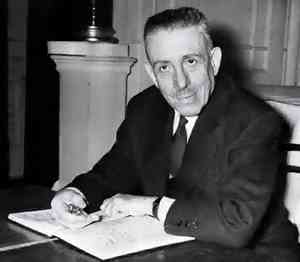 Francis Poulenc Source: Bach Cantatas |
|
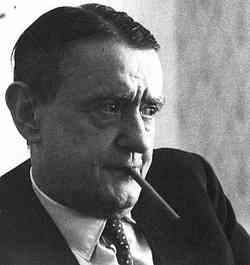 Georges Auric Source: Find a Grave |
Born in Lodève,
France, on 15 Feb 1899,
Georges Auric
came out of the gate strong at age twelve, performing his first piano
recital at the Société Musicale Indépendante
[*]. Songs he'd composed were
performed at the Société Nationale de Musique [*] the next year. He enrolled
into the Paris Conservatoire in 1913, also studying with
Vincent d'Indy
at the Schola Cantorum de Paris
[1,
2,
3] and
Albert Roussel.
This column will queue largely following the chronological list of compositions at Pytheas [below], though catalogues of Auric commonly commence with 'L'après-midi
dans un parc' ('Afternoon in a Park') for piano in 1914 followed by '3
Interludes' for voice and piano after R. Chapulet the same year. Come his
first ballet, 'Les Noces de Gamache' ('Gamache's Wedding') in 1915-16. An avant-garde composer from the begin, Auric fell in with a bunch with whom
he would become a member, that
Érik Satie's
Nouveaux Jeunes
formed in 1917 at the studio of painter, Émile Lejeune.
Author and artist, Jean Cocteau
[1,
2,
3,
4,
5,
6; art:
1,
2], had written the scenario to
Satie's first
ballet, 'Parade'.
Satie left Nouveaux Jeunes less than a year after their formation, that the
catalyst which spawned Les Six
[1,
2,
3,
4,
5,
6] upon Cocteau's 1918 publication of 'Le Coq et l'Arlequin:
Notes Around Music' (Éditions
de la Sirène) dedicated to Auric [1,
2,
3,
4].
Les Six, thus dubbed by critic, Henri Collet, in 1920, was an important group
of avant-garde composers something after the manner of the
The Five, an earlier
group of romantic Russian independents. The bunch consisted of Auric,
Louis Durey, Arthur Honegger,
Darius Milhaud,
Francis Poulenc and
Germaine Tailleferre.
Auric was the first member of Les Six to set Cocteau's poetry to music per 'Huit
Poèmes de Jean Cocteau' for piano and voice. Though Pytheas gives a date of
1919, the Cocteau website by Pierre-Marie Héron has the melodies begun in 1917,
preceding the publication of Cocteau's 'Le Coq et l'Arlequin' above
[*;
interpretations by Marie Marquis (soprano) & Donna Loewy (piano): 1,
2;
texts].
Les Six frequented a
cabaret (bar) called 'La
Gaya' which became Le Boeuf sur le Toit upon changing location,
renamed after
Milhaud's eponymous surrealist ballet which premiered at the Théâtre des
Champs-Élysées in February of 1920
[*]. Also on the program that evening were
Poulenc's 'Cocardes'
w libretto by Cocteau,
Satie's 'Trois petites pièces montées' and Auric's
fox-trot,
'Adieu, New York!' dedicated to Cocteau
[*;
piano by Peter Toperczer;
score]. Auric's
'Prelude' in A major was composed in 1919 toward publishing in 1920
with Les Six per 'L'Album
des Six' [1,
2;
piano by Mathias Weber].
His opera comique of 1919, 'La Reine de Coeur', remains lost. '3 Pastorales' for
piano saw publishing in 1920 in dedication to
Milhaud
[*;
live performance by Fumecri Himecri;
score].
All of Les Six except
Durey responded to
Cocteau's request for music to his libretto, 'Les mariés de la tour Eiffel',
premiering at the Théâtre des Champs-Élysées on 18 June 1921
[1,
2,
3;
production directed by Ycuba Stojanovic].
Auric composed his 'Sonatine' for piano dedicated to
Poulenc in
1922 [piano by Daniel Blumenthal w score]. His
ballet, 'Les Fâcheux' ('The Unfortunate'), premiered on 19 January 1924 in
Monte Carlo [interpretation by the Deutsche Radio Philharmonie Saarbrücken Kaiserslautern w
Christoph Poppen:
same on CD: 1,
2,
3].
Auric was an early heavyweight in the transforming of classical music into scores
for popular films. He began his film career, however, as an actor in René
Clair's Dadaist 'Entr'acte' of 1924 to be shown w music written by Satie at
the intermission of Francis Picabia's ballet, 'Relâche',
for which Satie also
composed the music [1,
2,
3,
4,
5;
film].
Auric's incidental music for 'Le Mariage de Monsieur le Trouhadec' was
premiered on 31 Jan of 1925. Come
his ballet, 'Les Matelots' ('The Sailors'), to the Théâtre de la
Gaîté-Lyrique on 17 June 1925 ['1,
'2].
That also came w an orchestral 'Suite'
[interpretation by the Houston Symphony Orchestra w 'Efrem Kurtz].
His second and last opera since his first in 1919 since lost [above] arrived
in 1927, 'Sous le Masque', which saw publishing on an unidentified date,
but had yet to be performed as of 1978 [*].
Auric also emerged on screen in Man Ray's 1929 film 'Les Mystères du Château
de Dé' [1,
2,
3,
4,
5;
film].
Auric's debut film score was for Cocteau's 1930 'Le Sang d'un Poète' ('The
Blood of a Poet') [1,
2,
3,
4,
5;
film: Part 1,
Part 2]. Auric and
Cocteau collaborated on eleven films together
[see also Deaville & Wood]. Come
Clair's film, 'A Nous, la Liberté!' in 1931 [1,
2,
3,
4,
5,
6,
7].
More at music in itself minus spectacle was 'Sonata' in G for violin and
piano written in '36 toward publishing in '37
[interpretation
by Frank Peter Zimmermann (violin) w Alexander Lonquich (piano)]. Come
'Trio' in D for oboe, clarinet et bassoon in 1938
[1,
2;
interpretation by the Arundo-Donax Ensemble;
live performance by Avenue Winds].
The film score for 'L'Éternel Retour' saw theaters on 13 Oct 1943 in France,
3 Jan 1948 in the US, that written by Cocteau and directed
Jean Delannoy
[1,
2,
3].
Come Cocteau's 'La Belle et la Bete' ('The Beauty and the Beast') in 1946 [1,
2,
3,
4;
soundtrack: 1,
2].
Auric's ballet,
'Phèdre', was first performed at the Opéra Paris on 14 June
1950 w choreography by Serge Lifar and set design by Cocteau
[orchestral 'Suite': interpretation the Orchestre National de l'ORTF w Manuel Rosenthal;
live performance by the Radio France Philharmonic Orchestra w Mikko Franck].
Auric supplied the score for Henri-Georges Clouzot's 'Le Salaire de la Peur'
('The Wages of Fear') premiering in 1953 [1,
2,
3]. He became President of SACEM in 1954 [1,
2,
3,
4]. Come
Clouzot's documentary film, 'Le Mystere Picasso', in 1956
[1,
2,
3,
4;
audio extracts: Overture,
Matisse].
In 1962 Auric became director
of the Opéra National de Paris [1,
2]. He began
his 'Imaginées' in 1968 w I for flute and piano. II was for cello and piano
in '69, III for clarinet and piano in 1971. Come IV for voice et piano in
1975. V was for piano in '76 along w VI for voice and instrumental ensemble
the same year. Among Auric's latest compositions was a 1976 revision of his
1927 'Aria' for flute and piano. In 1978 he scored one episode
each for the television series 'Volpone'
and 'Au Théâtre ce Soir' [1,
2]. He died in Paris on 23 July 1983
[obit],
having survived his wife since 1930, the painter, Eleanore Vilter, who had
passed the year before.
References: 1,
2,
3,
4.
Compositions:
chronological: Pytheas;
by genre: 1,
2,
3,
4,
Francais;
Italian.
Filmographies: 1,
2,
3,
4,
5,
6,
7.
Editions & scores (German).
Books & documents: French: 1,
2; international:
1,
2.
Sheet music.
Audio: 1,
2,
3,
4,
5,
6,
7,
8,
9,
YouTube.
Recordings of: discos: 1,
2,
3,
4;
select: 'L'Album des Six' by Emily Beynon (flute) & Andrew West (piano)
*;
'La Belle et la Bete' (film score) by the Moscow Symphony Orchestra w Adriano
*,
notes;
'The Classic Film Music of Georges Auric' by the Slovak Radio Symphony Orchestra w Adriano
*;
'The Film Music of Georges Auric'
*;
'Jean Cocteau Erik Satie and Les Six'
*;
'Phèdre' by the Orchestre Philharmonique du Luxembourg w Arturo Tamayo
1,
2.
Bibliography: 'Georges Auric: A Life in Music and Politics' by Colin Roust (Oxford U Press 2020);
'Parodic Narration in 'Entr'acte'' by Paul Sandro ('Film Criticism' 1979).
Other profiles: English: 1,
2,
3,
4;
French;
Italian: 1,
2;
Japanese;
Russian: 1,
2;
Spanish.
Georges Auric 1946 Film score Moscow Symphony Orchestra Adriano 1946 Film score Moscow Symphony Orchestra Adriano Conducted by Jacques Métehen 1949 Film scoreSlovak Radio Symphony Orchestra Adriano 1932 Minneapolis Symphony Orchestra Antal Dorati 1949 Symphonique suite Orchestre National de l'ORTF Manuel Rosenthal 1922 For piano 3 movements Pianoforte: Daniel Blumenthal Trio for Oboe, Clarinet and Bassoon 1938 3 movementsArundo-Donax Ensemble |
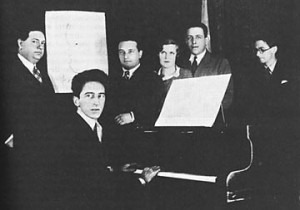
Les Six Source: Interlude |
| Born on 13 June 1899 in
Mexico City,
Carlos Chavez
finds Mexico but a heartbeat behind the United States in producing major
talent in the classical genre. Chavez was a romantic atop which he developed a nationalistic style a la Mexico
while his
contemporary and friend north of the border,
Aaron Copland, did the
same a la the United States. Chavez' father was a rich inventor, a plough of
his used in the United States. He studied piano as a child,
'La danza de las bruja' ('The Witch's Dance') for piano arriving in 1910 per Pytheas [below],
that the year the Mexican Revolution began, not to end until 1920
[1,
2,
3,
4,
5,
6].
Numerous compositions arrived in 1911 and onward including for violin. As Chavez composed
more than 500 works, most will go unmentioned in this account which will
mainly follow his symphonies, concerning which Pytheas has him writing his first, 'Sinfonia',
from 1915 to 1918. Albeit the arts journal, 'Gladios', that Chavez had begun
in 1916 as a high school student didn't run long, it strongly influenced
his career direction. Though that was an intellectual endeavor, no mention
is found of Chavez ever attending university. As composition goes, he was
largely an autodidact though he studied under Juan B. Fuentes, Manuel Ponce
and Pedro Luis Ogaz6n. Composers important to him as a youth included
Beethoven,
Wagner
and
Debussy. Exampling
one of his earlier works is 'Sextet' for piano and strings of 1919 which he
played during his first public performance in 1921
[interpretation
by the Southwest Chamber Music Ensemble]. Chavez' first of several ballets,
'El Fuego Nuevo' ('The New Fire') of 1921, was inspired by an Aztec legend
toward a flavor indigenous to Mexico. Pytheas has that gone unperformed
[live performance of arrangement for ensemble by Juan Gabriel Hernández]. Most of Chavez' works had been for piano before
marrying one Otilia Ortiz in Sep of 1922 with whom he honeymooned in Vienna,
Berlin and Paris, where he met
Paul Dukas,
until April of '23. His first visit to the
States was from Dec '23 to March '24, after which he acquired employment as
a writer for the newspaper, 'El Universal', in 1924, where he would remain
for more than three decades [1,
2,
3].
Chavez was also concerned to create a theme indigenous to Mexico with his
second ballet, 'Los Cuatro Soles' ('The Four Suns') of 1925 [orchestral score]. Chavez began his work on mechanization, 'Caballos de Vapor: Sinfonía de Baile' ('Horse-Power:
Ballet Symphony'), in 1926 toward its eventual premiere in Philadelphia by the
Philadelphia Grand Opera Company with the Philadelphia Orchestra conducted
by
Leopold Stokowski
on March 31, 1932. Chavez also wrote a shorter 'Horsepower Suite'
[interpretation
by the Simon Bolivar Symphony Orchestra of Venezuela]. In the meantime he brought Mexico its first
major orchestra in 1928
per the Orquesta Sinfónica Mexicana, later renamed the Orquesta Sinfónica
de México. He was appointed Director of Mexico's National Conservatory of
Music that year as well. In 1932 Chavez wrote the incidental music to Jean
Cocteau's adaptation of Sophocles' 'Antigone' which became his 'Symphony
No.1' ('Sinfonía de Antígona') in 1933. Chavez' short orchestral piece 'Cantos de México' arrived in 1933
w flavoring more indigenous to Mexico [interpretations by
Southwest Chamber Music &
the State of Mexico S O w Enrique Bátiz].
His 'Llamadas: Sinfonía Proletaria' for mixed chorus and orchestra arrived
in 1934 filled with Mexican Revolutionary ballads. Chavez's 'El Sol: Corrido
Mexicano' for chorus and orchestra surfaced in 1934 w text by Carlos
Gutiérrez Cruz
[*;
recording
by the Symphony Orchestra of Mexico directed by Chávez
(1951?)]. The corrido is a
widely popular form of Mexican folk ballad originating with the
Mexican War of Independence from Spain in the early 19th century
[1,
2,
3,
4,
5;
Strachwitz Frontera: 1,
2,
3,
4;
audio samples by various: 1,
2;
see also narcocorrido].
'Symphony No. 2' ('Sinfonía India') was begun in the United States in Dec of
1935 inspired by American Indian melodies indigenous to Mexico. It premiered
in Mexico City on 31 July 1936 [1,
2;
interpretations by various: 1,
2,
3;
live performances: 1,
2;
score: 1,
2].
On an unidentified date in 1937 W. W. Norton published Chavez' book in music
theory which addressed electronics, 'Toward a New Music: Music and
Electricity'. He premiered his orchestrated arrangement
of Buxtehude's 'Chacona' in E minor
for organ at the Teatro de Bellas Artes on 14 Sep 1937 conducting the
Orquesta Sinfónica de México. He wrote versions for both small and
symphony orchestra [1,
2,
3;
interpretation by the London Symphony Orchestra w Eduardo Mata; live performances: 1,
2].
Sometime in early 1938 Chavez received a grant from the Guggenheim Memorial
Foundation [1,
2] which he used to write 'Piano Concerto' eventually premiering
by Eugene List at piano with the New York Philharmonic Orchestra directed by
Dimitri Mitropoulos on 1 January 1942 [1,
2]. Wikipedia has Chavez recording
'Piano Concerto' in 1963, conducting the Vienna State Opera Orchestra w List
at piano toward issue in '64 on Westminister WST 17030 [1,
2,
3]. Chavez had also visited the US in 1938 to conduct the NBC Symphony Orchestra in the absence of
Arturo Toscanini.
The 'New York Times' has his second such performance
directing
Sibelius' 1911 'Symphony No.4'
at Radio City Music Hall in NYC on 19 March 1938.
qwerty
supplies a broad date of 1938 for the recording and/or issue of Chavez' 'Sinfonía de
Antígona', 'Sinfonía India' and his orchestrated version of
Buxtehude's 'Chacona' on Victor Red Seal M/DM 503,
that directing the Orquesta Sinfónica de México. In 1940
Chavez wrote 'Xochipilli' for four wind and six percussion instruments commissioned by
Nelson Rockefeller
to be performed on 16 May at the Museum of Modern Art in New York
[MoMA: 1,
2,
3]. Subtitled 'An
Imagined Aztec Music', 'Xochipilli' is the first half of
Xochipilli-Macuilxóchitl, the Aztec god whose name is rendered in English as
Flower Prince-Five Flower [1,
2,
3;
interpretation by La Camerata (Panamerican Chamber Players) et Tambuco Percussion Ensemble w
Eduardo Mata;
live performance by the
Sinaloa Symphony Orchestra of the Arts w Gordon Campbell].
In 1947 Chavez
became General Director of the National Institute of Fine Arts in Mexico
City [1,
2]. That occasioned the
disassembly of the Orquesta Sinfónica de México founded by Chavez in '28 to resurrect it as the National Symphony Orchestra
(OSN) [1,
2].
'Symphony No.3'
was begun in 1951 w a commission from Clare Boothe Luce toward its premiere in December of '54 by the Orquesta
Sinfónica de Venezuela conducted by Chavez at the Anfiteatro José Ángel
Lamas in Caracas, Venezuela [interpretation by the London S O w Eduardo Mata:
Introduzione,
Allegro,
Scherzo/Finale].
'Symphony No.4' ('Sinfonía Romántica') was commissioned by and dedicated to
the Louisville Orchestra [1,
2,
3]
which performed it on 11 February 1953 (prior to the premiere of 'No.3' in
'54) [1,
2;
interpretation by the London S O w Eduardo Mata;
score].
'Symphony No.5' had been written in the summer of '53 in Acapulco toward its
premiere in December (prior to the premiere of 'No.3' in '54) at Royce Hall in
Los Angeles by the Los Angeles Chamber Orchestra conducted by Chavez
[interpretation by the London S O w Eduardo Mata:
1/3,
2/3,
3/3;
score].
'Symphony No.6' was commissioned in 1961 by the New York Philharmonic
[1,
2,
3]
which performed its delayed premiere at Lincoln Center in NYC on 7 May 1964
conducted by Leonard Bernstein
[recording of 10 May 1964].
Chavez wrote scores for a few
documentaries appearing from 1970 to 1977.
He composed his last ballet in 1974 for choreographer, Amalia Hernández,
the four-act 'Pirámide' which Pytheas
has going unperformed until its much later premiere
[alt] in Oct 2019 w the National Symphony
Orchestra conducted by Carlos Miguel Prieto. Chavez had died some forty
years earlier on 2 August 1978 in Mexico
City. References: 1,
2,
3,
4.
Chronology.
Compositions:
alphabetical: All Music,
Arkiv;
chronological: Musicweb,
Pytheas; Wikipedia:
English,
Italian,
Spanish;
by genre: 1,
2,
3,
4,
5.
Authorship: 'Mexican Music' by Herbert Weinstock
w Introduction by Chavez (MoMA 1940);
'El Universal'.
Books & documents:
Canada,
France,
international: 1,
2.
Collections: NYPL.
Audio: 1,
2,
3,
4
5,
6,
7,
8,
9,
10;
'Complete Works of Carlos Chavez' (YouTube):
Vol 1,
Vol 2,
Vol 3,
Vol 4;
KPFA Radio (Harrison & Copland on Chavez).
'The Six Symphonies of Carlos Chavez' CBS 1967 *.
Recordings of: discos: 1,
2,
3,
4;
select: 'Chavez' ('Los Cuatros Soles' & 'Pirámide' including Copland's 'Appalachian Spring'):
1,
2;
'Complete Chamber Music':
Vol 1,
Vol 2,
Vol 3,
Vol 4;
'The Complete Symphonies' by the London Symphony Orchestra w Eduardo Mata:
1,
2;
'Mexico: 100 Years of Piano Music' by Max Lifchitz (piano);
'Piano Concerto' by Jorge Federico Osorio (piano) backed by the Mexico National Symphony Orchestra w Carlos Miguel Prieto.
Further reading by author: Russell Platt,
William Robin;
Further reading by topic: modern music in NYC and (Gibson);
politics: Pufleau,
Tapia;
polysemic style (Saavedra).
Bibliography:
'A Recurring Melodic Cell' by Robert Parker ('Latin American Music Review' 1991);
Shawn Roberts (comparative study between Chávez' 1940 'Xochipilli' & Lou Harrison's 1941 'The Song of Quetzalcóatl');
'Mexico and the United States' by Lee Stacy (Marshall Cavendish 2002);
'Carlos Chavez' by various (Ediciones Méxicanas de Música 1951).
Other profiles: English: 1,
2,
3,
4,
5;
Espanol: 1,
2;
Francais;
Italian;
русском: 1,
2.
Carlos Chavez Concerto for piano and orchestra 1938-40Vienna State Opera Orchestra Conductor: Carlos Chávez Piano: Eugene List 1973 State of Mexico Symphony Orchestra Enrique Bátiz Sinfonia 1 (Sinfonía de Antigona) 1933Orquesta Filarmónica de la ciudad de México Enrique Bátiz 1935-36 SCM Symphony Orchestra Eduardo Diazmuñoz 1953 Allegro molto moderato London Symphony Orchestra Eduardo Mata 1953 Molto lento London Symphony Orchestra Eduardo Mata 1953 Allegro molto moderato London Symphony Orchestra Eduardo Mata 1961 Allegro energico London Symphony Orchestra Eduardo Mata 1961 Adagio molto cantabile London Symphony Orchestra Eduardo Mata 1961 Allegro energico London Symphony Orchestra Eduardo Mata
|
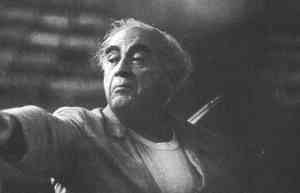 Carlos Chavez Source: John Craton |
|
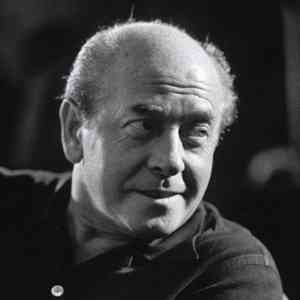 Eugene Ormandy Source: Last FM |
Born on 18 Nov 1899 in
Budapest,
Eugene Ormandy
wasn't a composer, but as a conductor and musical director he was a
significant interpreter of many important works who fairly requires mention
in this history. Ormandy began to study violin at age five at the Royal
National Hungarian Academy of Music, gave his first recitals at salon violin at age seven
and graduated at age fourteen. Though not a composer he had studied
composition beneath
Zoltán Kodály
and Leó Weiner. He next acquired a philosophy degree from Budapest
University in 1920.
Moving to the United States in 1921, he was employed as a violinist at the
Capitol Theatre in New York City, providing accompaniment to silent films in
the orchestra of Major
Edward Bowes of which he quickly became director.
Between 1923 and 1930 Ormandy issued twenty records, four acoustic, the rest
w with
microphone per Frederick Williams at the Ormandy website by Kenji Yokota. Ormandy recorded violin
as early as circa 8-10 Nov 1923 toward the issue of a
couple titles by
Rimsky-Korsakov:
'Hymn to the Sun' [audio] and 'Song of India'
[audio] on Cameo 465.
A date of 7 Nov 1923 is supplied at the ODP, authority
unidentified (Rust?). Ormandy's
initial electrical recordings on violin were
Dvorák's 'Humoresque' on
Cameo 983 w
Franz Liszt's 'Liebestraum'
going down circa 18-20 June 1926 toward issue on Cameo 983 [1,
2]. Switching over to the Okeh label in 1927,
he directed Mary Ellis' 1924 'Indian Love Call' and Thurlow Lieurance's 1921
'The Waters of Minnetonka' circa 18-20 August toward release on Okeh 40930 by the Major Bowes
Theatre Trio [Discogs]. The date of August 23 supplied at MusikTitel is from 'Discography of OKeh Records 1918-1934' by Ross Laird and Brian Rust [*].
He was a guest conductor as Dr. Ormandy for the Dorsey Brothers on 16 July
of '28 toward the issue of 'Was It a Dream' on Okeh 41083
[audio].
Yokota (above) lists known violinists for that in the order of Al Duffy
followed by Leo Krocurik. DAHR [scroll] finds Ormandy backing vocalist, Kenny
Sargent, on violin for several titles in Nov and Dec 1927, those for
Columbia, status unknown. 'Go to Bed' for the soundtrack of 'The Gold
Diggers of Broadway' [1,
2,
3]
saw recording on 17 Sep 1929 w Dr. Ormandy
conducting his Salon Orchestra. Likely w
Jimmy Dorsey
at clarinet and alto sax w Tommy at trombone,
that saw release on Okeh 41200. Ormandy first conducted the Philadelphia Orchestra
(PO) in 1931, filling
in for Arturo Toscanini who was ill. But
it was the Minneapolis
Symphony Orchestra (MSO) which he officially conducted from 1931 to 1936 [now the
Minnesota Orchestra: [1,
2]. DAHR
(above) begins its sessionography of Ormandy and the MSO with Percy
Grainger's 'Shepherd's Hey' recorded at the Cyrus Northrop Auditorium on
16 Jan 1934 toward issue on Victor 1666 [*;
audio].
The works of numerous composers saw recording for the first time by Ormandy
and the MSO including
Zoltán Kodály's 'Háry János Suite' on 17 Jan 1934
(Victor 7951/54) [audio],
Rachmaninoff's 'Symphony No.2' in E minor on 19 Jan 1934
(Victor 8463/69),
Arnold Schoenberg's 'Verklärte Nacht' on 24 Jan 1934
(Victor 8266/70) and
Sibelius' 'Symphony No.1' in E minor on 16 Jan 1935
(Victor 8873/78) [audio].
Ormandy assumed his post with the Philadelphia Orchestra (PO) in 1936, by
which he would make his name;for another four decades so.
He began as assistant to conductor,
Leopold Stokowski,
becoming musical director a couple years later. Ormandy and the PO
made hundreds of recordings. Among those gone down in the latter thirties
was
Richard
Strauss' 'Domestic Symphony' on 9 May 1938 for Victor.
Stokowski
had conducted the PO supporting Rachmaninoff's recording of his 'Concerto
No.2' back in April of 1929 [audio: 1,
2,
3].
Ten years later it was Ormandy conducting the PO in support of
Rachmaninoff's 'Concerto No. 1' in December 1939 and February 1940
[audio: 1,
2,
3],
Concerto No. 3' in December 1939 and February 1940
[audio: 1,
2,
3], and
'Concerto No.4' in Dec 1940 [audio: 1,
2]. In 1947 he appeared in the film, 'Night Song', with
Hoagy Carmichael
and
Arthur Rubinstein
[1,
2,
3].
In 1950 Ormandy conducted the PO on a recording of Prokofiev's
'Symphony No.6' [audio] with 'Symphony No.7' following in
1953 [audio].
Latter 1959 brought
Shostakovich's 'Cello Concerto No.1'
Op 107 w Mstislav
Rostropovich at cello [audio].
Discogs has the first complete recording of
Mahler's 'Symphony No.10' issued
in 1966 with Ormandy conducting the PO. He received the Presidential Medal
of Freedom in 1970. Ormandy often toured with the Philadelphia Orchestra, including the
People's Republic of China in 1973. Though Hungarian and a US citizen, he
received an honorary knighthood from Queen Elizabeth in June 1976.
The American Philosophical Society
[1,
2]
granted him a residency in 1977.
Ormandy and the PO made their first digital recording in 1979 per
Béla Bartók's 'Concerto for
Orchestra' [1,
2].
It was 1980 when Ormandy decided upon Riccardo Muti [1,
2] as his successor to the
Philadelphia Orchestra. Another version of
Shostakovich's
'Cello Concerto No.1' Op 107 arrived in 1983, now with Yo-Yo Ma
[1,
2] at cello
[Allegretto]. Ormandy
conducted the PO for the last time on 10 Jan of 1984, performing Bartók's
'Concerto for Orchestra'
at Carnegie Hall. He died in Philadelphia a year or so later on 12 March 1985
[obit].
References for Ormandy: 1,
2,
3,
4,
5.
Audio: 1,
2,
3,
4,
5,
6;
Recordings of: discographies: 1,
2,
3,
4,
5,
6;
select: 'American Orchestral Music' (Schuman - Gesensway - Persichetti)
*;
'American Symphonies' (Piston - Harris - Schuman)
*;
'The Art of Eugene Ormandy'
*;
'Prokofiev: Symphonies Nos. 6 & 7':
1,
2.
Soundtracks.
Further reading: recordings:
1,
2;
symphonies;
Lon Tuck.
Iconography: 1,
2,
3,
4.
Books & documents: Canada,
USA,
international: 1,
2.
Collections: University of Pennsylvania.
Databases: BMLO (Bavaria).
Other profiles: Deutsch;
Dutch;
English: 1,
2,
3,
4;
Finnish;
French;
Italian;
Polish;
Portuguese;
Russian: 1,
2;
Spanish.
References for the Philadelphia Orchestra: 1,
2,
3,
concerts in Japan,
double bassists,
principle members.
Eugene Ormandy Composer: George Enescu 1901 Op 11:1 & 2 Philadelphia Orchestra Composer: Sergei Prokofiev Version 1: 1912-13 Version 2: 1923 Op 16 4 movements Philadelphia Orchestra Recorded 1974 Composer: Gustav Holst 1914-16 Op 32 7 movements Philadelphia Orchestra Recorded 1977 Composer: Dmitri Shostakovich 1937 Op 47 Philadelphia Orchestra Recorded 1958 Composer: Dmitri Shostakovich 'Babi-Yar' 1962 Op 113Baritone: Tom Krause Philadelphia Orchestra Recorded 1970 Violin Concerto 2 in C sharp minor Composer: Dmitri Shostakovich1967 Op 129 Violin: David Oistrakh London Symphony Orchestra Recorded 1967 |
|
|
This section of the history of early modern classical suspends with Ormandy. |
|
Early Blues 2: Vocal - Other Instruments
Modern Blues 2: Vocal - Other Instruments
Classical
Romantic: Composers born 1770 to 1840
Early Jazz 1: Ragtime - Bands - Horn
Early Jazz 2: Ragtime - Other Instrumentation
Modern 4: Guitar - Other String
Modern 5: Percussion - Other Orchestration
Modern 7: Latin Jazz - Latin Recording
Modern 8: United States 1960 - 1970
Modern 9: International 1960 - 1970
Latin
Latin Recording 2: The Caribbean
Latin Recording 3: South America
The Big Bang - Fifties American Rock
Total War - Sixties American Rock
Musician Indexes
Classical - Medieval to Renaissance
Classical - Baroque to ClassicalJazz Early - Ragtime - Swing Jazz
Jazz Modern - Percussion - Song - Other
Boogie Woogie - Doo Wop - R&B - Rock & Roll - Soul - Disco
Sixties American Rock - Popular
Latin Recording - The Caribbean - South America
![]()
vfssmail (at) gmaill (dot) com